Impact of Corporate Governance in Retail Segment in Singapore
VerifiedAdded on 2023/06/11
|47
|11069
|165
AI Summary
This dissertation analyzes the effect of corporate governance on the retail sector companies in Singapore. It includes a literature review, research methodology, data analysis, and results. The research questions address the level of corporate governance in the retail industry and the difference between firms listed in the Main Board and Catalyst. The study's contributions include identifying the necessity of corporate governance disclosures, laws, and exercises regarding corporate social accountability.
Contribute Materials
Your contribution can guide someone’s learning journey. Share your
documents today.
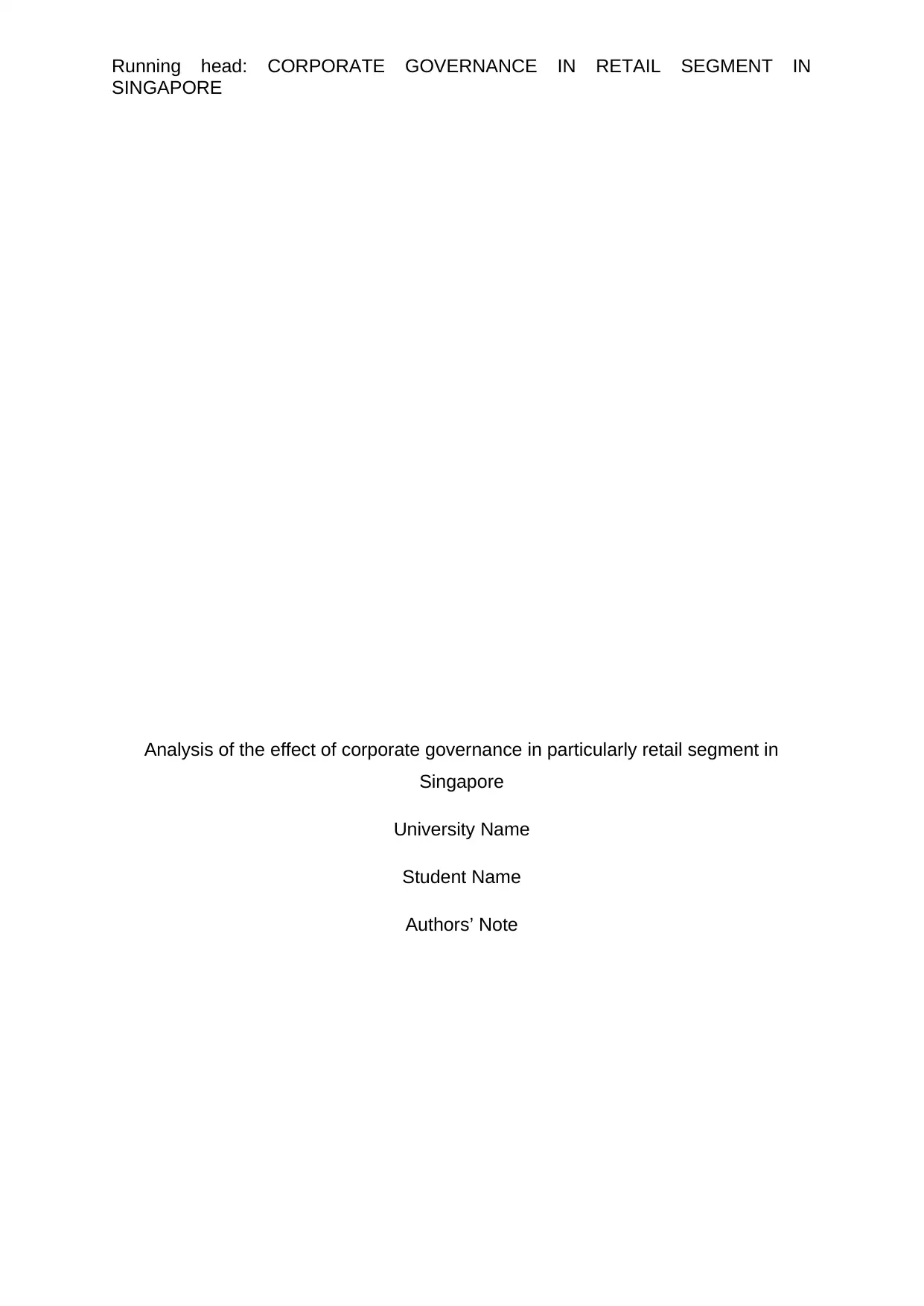
Running head: CORPORATE GOVERNANCE IN RETAIL SEGMENT IN
SINGAPORE
Analysis of the effect of corporate governance in particularly retail segment in
Singapore
University Name
Student Name
Authors’ Note
SINGAPORE
Analysis of the effect of corporate governance in particularly retail segment in
Singapore
University Name
Student Name
Authors’ Note
Secure Best Marks with AI Grader
Need help grading? Try our AI Grader for instant feedback on your assignments.
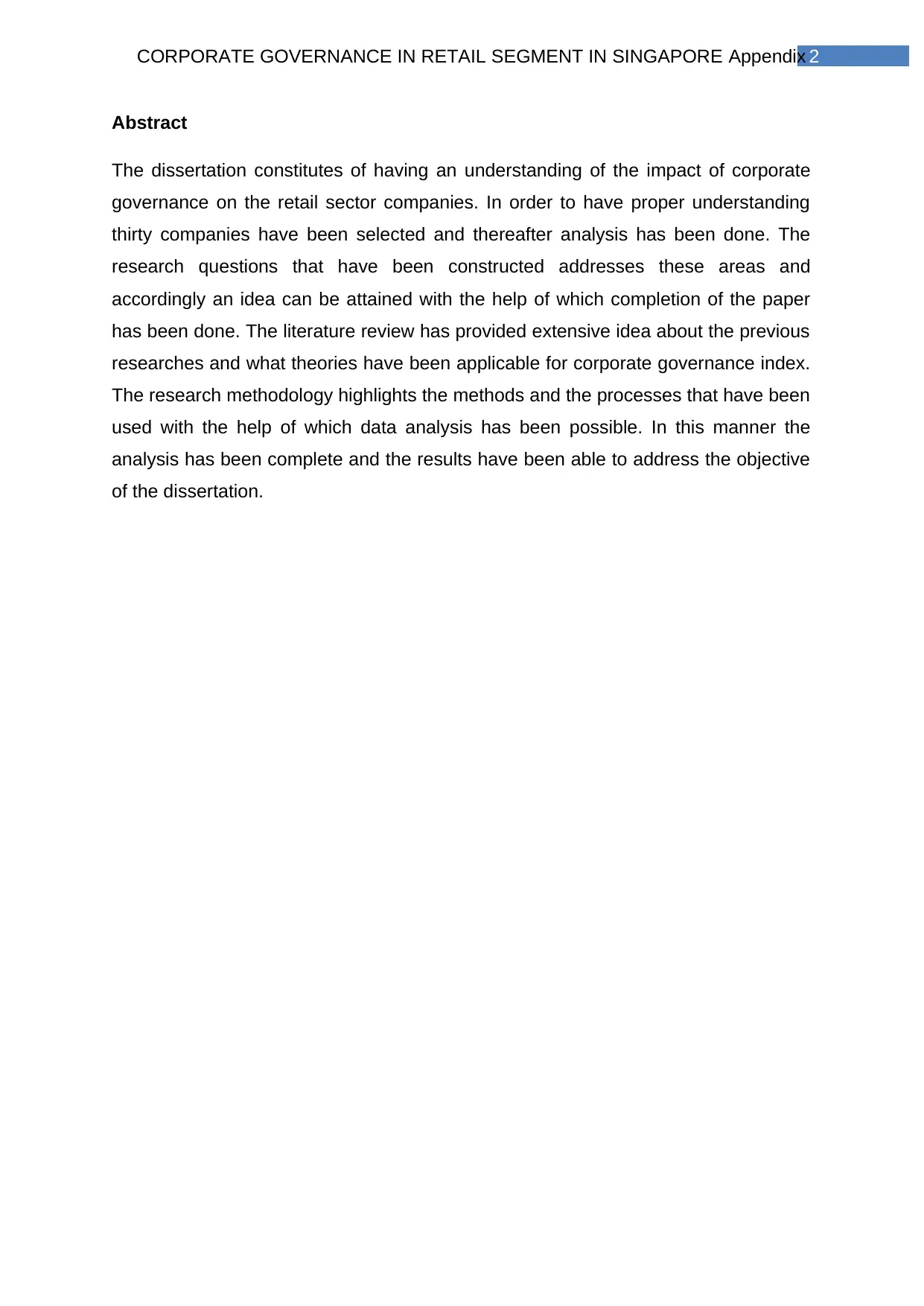
2CORPORATE GOVERNANCE IN RETAIL SEGMENT IN SINGAPORE Appendix
Abstract
The dissertation constitutes of having an understanding of the impact of corporate
governance on the retail sector companies. In order to have proper understanding
thirty companies have been selected and thereafter analysis has been done. The
research questions that have been constructed addresses these areas and
accordingly an idea can be attained with the help of which completion of the paper
has been done. The literature review has provided extensive idea about the previous
researches and what theories have been applicable for corporate governance index.
The research methodology highlights the methods and the processes that have been
used with the help of which data analysis has been possible. In this manner the
analysis has been complete and the results have been able to address the objective
of the dissertation.
Abstract
The dissertation constitutes of having an understanding of the impact of corporate
governance on the retail sector companies. In order to have proper understanding
thirty companies have been selected and thereafter analysis has been done. The
research questions that have been constructed addresses these areas and
accordingly an idea can be attained with the help of which completion of the paper
has been done. The literature review has provided extensive idea about the previous
researches and what theories have been applicable for corporate governance index.
The research methodology highlights the methods and the processes that have been
used with the help of which data analysis has been possible. In this manner the
analysis has been complete and the results have been able to address the objective
of the dissertation.
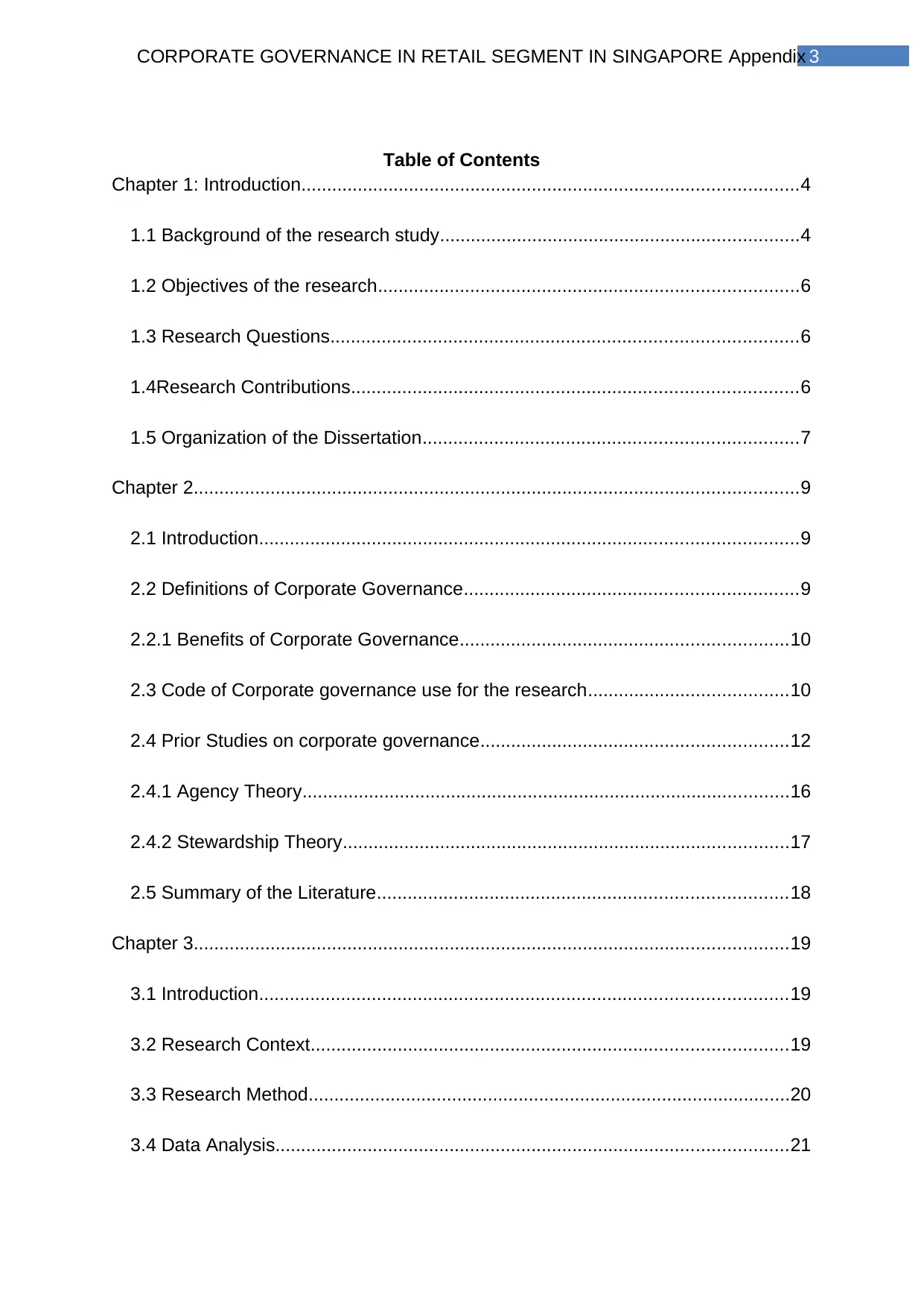
3CORPORATE GOVERNANCE IN RETAIL SEGMENT IN SINGAPORE Appendix
Table of Contents
Chapter 1: Introduction.................................................................................................4
1.1 Background of the research study......................................................................4
1.2 Objectives of the research..................................................................................6
1.3 Research Questions...........................................................................................6
1.4Research Contributions.......................................................................................6
1.5 Organization of the Dissertation.........................................................................7
Chapter 2......................................................................................................................9
2.1 Introduction.........................................................................................................9
2.2 Definitions of Corporate Governance.................................................................9
2.2.1 Benefits of Corporate Governance................................................................10
2.3 Code of Corporate governance use for the research.......................................10
2.4 Prior Studies on corporate governance............................................................12
2.4.1 Agency Theory...............................................................................................16
2.4.2 Stewardship Theory.......................................................................................17
2.5 Summary of the Literature................................................................................18
Chapter 3....................................................................................................................19
3.1 Introduction.......................................................................................................19
3.2 Research Context.............................................................................................19
3.3 Research Method..............................................................................................20
3.4 Data Analysis....................................................................................................21
Table of Contents
Chapter 1: Introduction.................................................................................................4
1.1 Background of the research study......................................................................4
1.2 Objectives of the research..................................................................................6
1.3 Research Questions...........................................................................................6
1.4Research Contributions.......................................................................................6
1.5 Organization of the Dissertation.........................................................................7
Chapter 2......................................................................................................................9
2.1 Introduction.........................................................................................................9
2.2 Definitions of Corporate Governance.................................................................9
2.2.1 Benefits of Corporate Governance................................................................10
2.3 Code of Corporate governance use for the research.......................................10
2.4 Prior Studies on corporate governance............................................................12
2.4.1 Agency Theory...............................................................................................16
2.4.2 Stewardship Theory.......................................................................................17
2.5 Summary of the Literature................................................................................18
Chapter 3....................................................................................................................19
3.1 Introduction.......................................................................................................19
3.2 Research Context.............................................................................................19
3.3 Research Method..............................................................................................20
3.4 Data Analysis....................................................................................................21
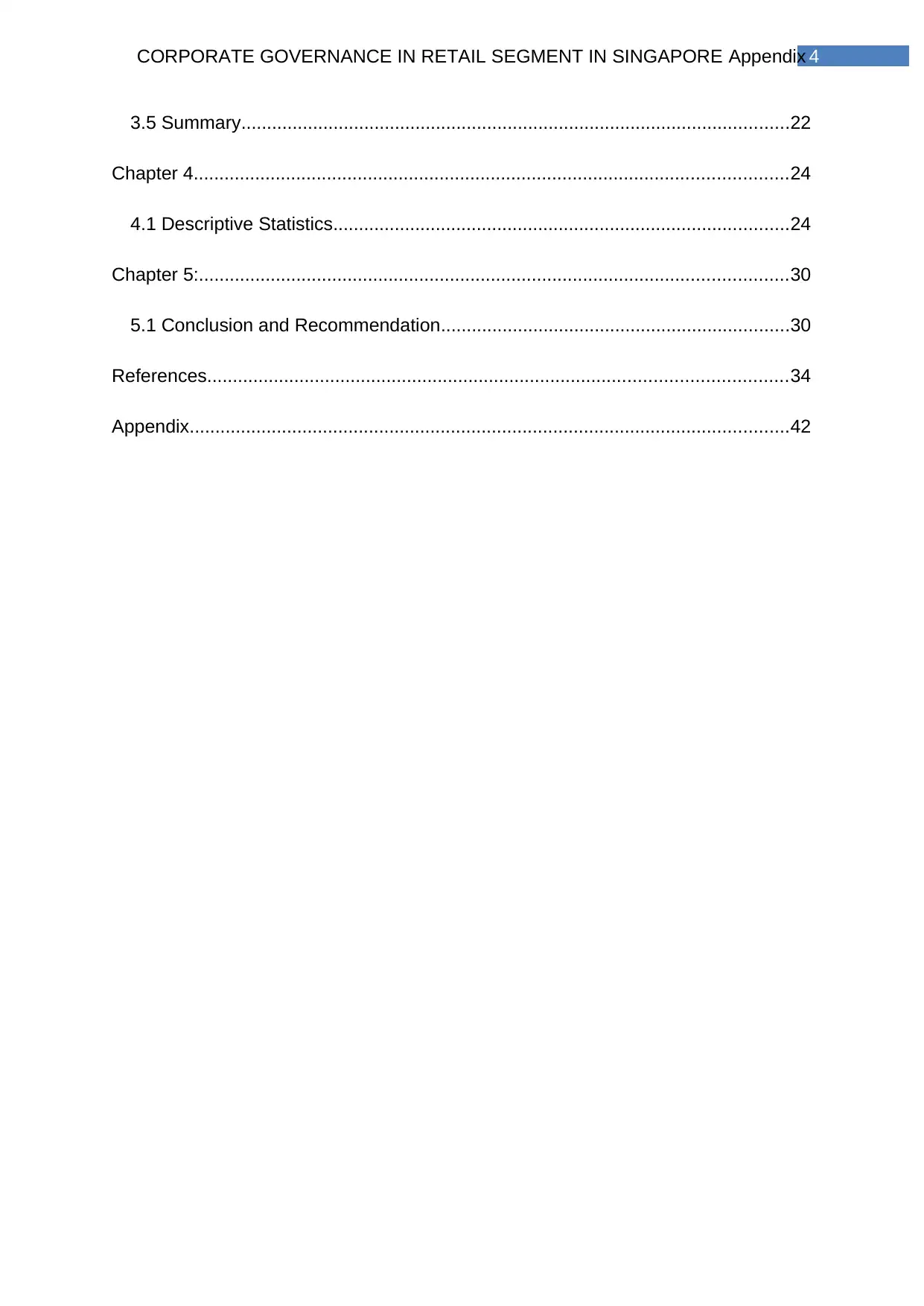
4CORPORATE GOVERNANCE IN RETAIL SEGMENT IN SINGAPORE Appendix
3.5 Summary...........................................................................................................22
Chapter 4....................................................................................................................24
4.1 Descriptive Statistics.........................................................................................24
Chapter 5:...................................................................................................................30
5.1 Conclusion and Recommendation....................................................................30
References.................................................................................................................34
Appendix.....................................................................................................................42
3.5 Summary...........................................................................................................22
Chapter 4....................................................................................................................24
4.1 Descriptive Statistics.........................................................................................24
Chapter 5:...................................................................................................................30
5.1 Conclusion and Recommendation....................................................................30
References.................................................................................................................34
Appendix.....................................................................................................................42
Secure Best Marks with AI Grader
Need help grading? Try our AI Grader for instant feedback on your assignments.
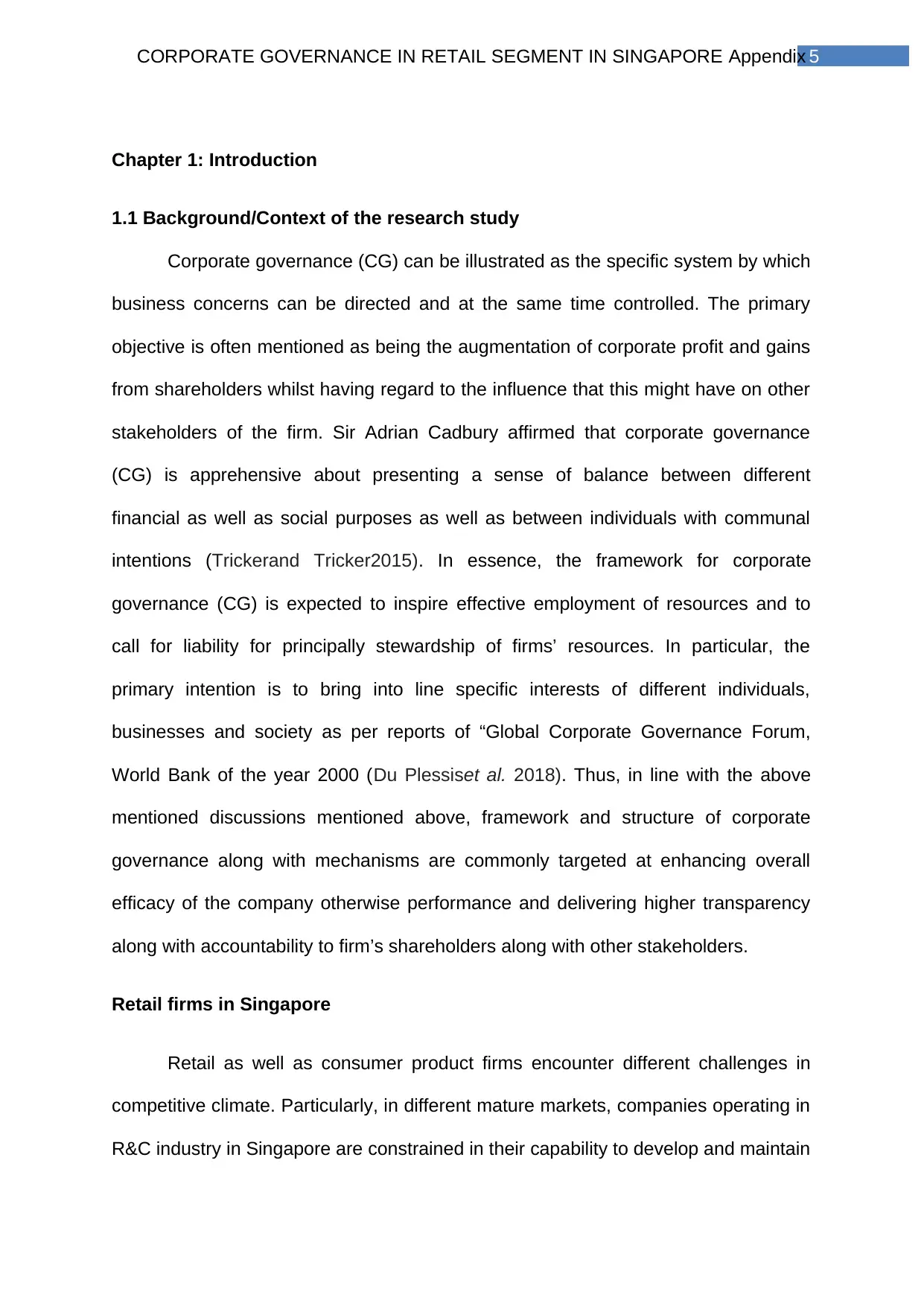
5CORPORATE GOVERNANCE IN RETAIL SEGMENT IN SINGAPORE Appendix
Chapter 1: Introduction
1.1 Background/Context of the research study
Corporate governance (CG) can be illustrated as the specific system by which
business concerns can be directed and at the same time controlled. The primary
objective is often mentioned as being the augmentation of corporate profit and gains
from shareholders whilst having regard to the influence that this might have on other
stakeholders of the firm. Sir Adrian Cadbury affirmed that corporate governance
(CG) is apprehensive about presenting a sense of balance between different
financial as well as social purposes as well as between individuals with communal
intentions (Trickerand Tricker2015). In essence, the framework for corporate
governance (CG) is expected to inspire effective employment of resources and to
call for liability for principally stewardship of firms’ resources. In particular, the
primary intention is to bring into line specific interests of different individuals,
businesses and society as per reports of “Global Corporate Governance Forum,
World Bank of the year 2000 (Du Plessiset al. 2018). Thus, in line with the above
mentioned discussions mentioned above, framework and structure of corporate
governance along with mechanisms are commonly targeted at enhancing overall
efficacy of the company otherwise performance and delivering higher transparency
along with accountability to firm’s shareholders along with other stakeholders.
Retail firms in Singapore
Retail as well as consumer product firms encounter different challenges in
competitive climate. Particularly, in different mature markets, companies operating in
R&C industry in Singapore are constrained in their capability to develop and maintain
Chapter 1: Introduction
1.1 Background/Context of the research study
Corporate governance (CG) can be illustrated as the specific system by which
business concerns can be directed and at the same time controlled. The primary
objective is often mentioned as being the augmentation of corporate profit and gains
from shareholders whilst having regard to the influence that this might have on other
stakeholders of the firm. Sir Adrian Cadbury affirmed that corporate governance
(CG) is apprehensive about presenting a sense of balance between different
financial as well as social purposes as well as between individuals with communal
intentions (Trickerand Tricker2015). In essence, the framework for corporate
governance (CG) is expected to inspire effective employment of resources and to
call for liability for principally stewardship of firms’ resources. In particular, the
primary intention is to bring into line specific interests of different individuals,
businesses and society as per reports of “Global Corporate Governance Forum,
World Bank of the year 2000 (Du Plessiset al. 2018). Thus, in line with the above
mentioned discussions mentioned above, framework and structure of corporate
governance along with mechanisms are commonly targeted at enhancing overall
efficacy of the company otherwise performance and delivering higher transparency
along with accountability to firm’s shareholders along with other stakeholders.
Retail firms in Singapore
Retail as well as consumer product firms encounter different challenges in
competitive climate. Particularly, in different mature markets, companies operating in
R&C industry in Singapore are constrained in their capability to develop and maintain
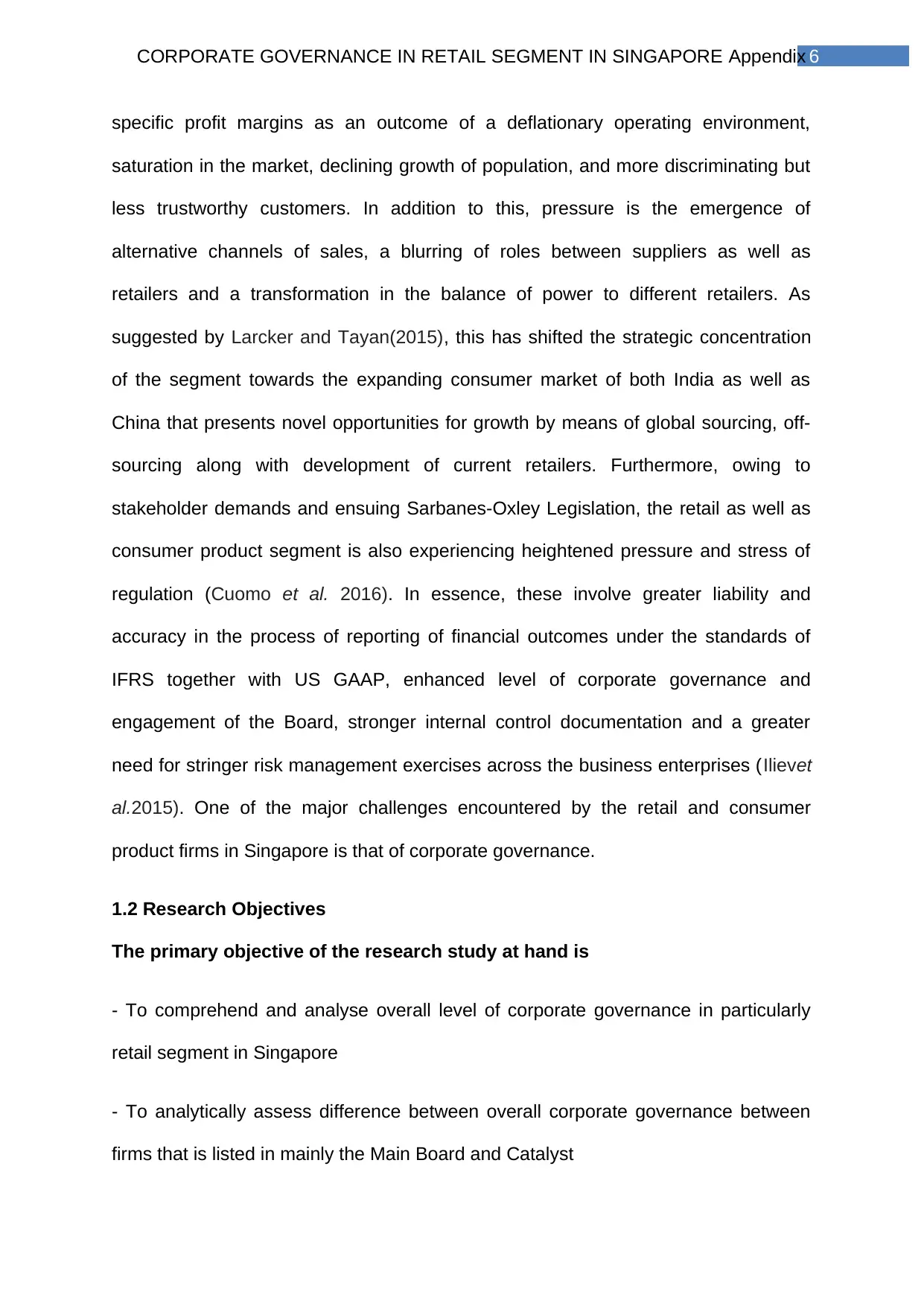
6CORPORATE GOVERNANCE IN RETAIL SEGMENT IN SINGAPORE Appendix
specific profit margins as an outcome of a deflationary operating environment,
saturation in the market, declining growth of population, and more discriminating but
less trustworthy customers. In addition to this, pressure is the emergence of
alternative channels of sales, a blurring of roles between suppliers as well as
retailers and a transformation in the balance of power to different retailers. As
suggested by Larcker and Tayan(2015), this has shifted the strategic concentration
of the segment towards the expanding consumer market of both India as well as
China that presents novel opportunities for growth by means of global sourcing, off-
sourcing along with development of current retailers. Furthermore, owing to
stakeholder demands and ensuing Sarbanes-Oxley Legislation, the retail as well as
consumer product segment is also experiencing heightened pressure and stress of
regulation (Cuomo et al. 2016). In essence, these involve greater liability and
accuracy in the process of reporting of financial outcomes under the standards of
IFRS together with US GAAP, enhanced level of corporate governance and
engagement of the Board, stronger internal control documentation and a greater
need for stringer risk management exercises across the business enterprises (Ilievet
al.2015). One of the major challenges encountered by the retail and consumer
product firms in Singapore is that of corporate governance.
1.2 Research Objectives
The primary objective of the research study at hand is
- To comprehend and analyse overall level of corporate governance in particularly
retail segment in Singapore
- To analytically assess difference between overall corporate governance between
firms that is listed in mainly the Main Board and Catalyst
specific profit margins as an outcome of a deflationary operating environment,
saturation in the market, declining growth of population, and more discriminating but
less trustworthy customers. In addition to this, pressure is the emergence of
alternative channels of sales, a blurring of roles between suppliers as well as
retailers and a transformation in the balance of power to different retailers. As
suggested by Larcker and Tayan(2015), this has shifted the strategic concentration
of the segment towards the expanding consumer market of both India as well as
China that presents novel opportunities for growth by means of global sourcing, off-
sourcing along with development of current retailers. Furthermore, owing to
stakeholder demands and ensuing Sarbanes-Oxley Legislation, the retail as well as
consumer product segment is also experiencing heightened pressure and stress of
regulation (Cuomo et al. 2016). In essence, these involve greater liability and
accuracy in the process of reporting of financial outcomes under the standards of
IFRS together with US GAAP, enhanced level of corporate governance and
engagement of the Board, stronger internal control documentation and a greater
need for stringer risk management exercises across the business enterprises (Ilievet
al.2015). One of the major challenges encountered by the retail and consumer
product firms in Singapore is that of corporate governance.
1.2 Research Objectives
The primary objective of the research study at hand is
- To comprehend and analyse overall level of corporate governance in particularly
retail segment in Singapore
- To analytically assess difference between overall corporate governance between
firms that is listed in mainly the Main Board and Catalyst
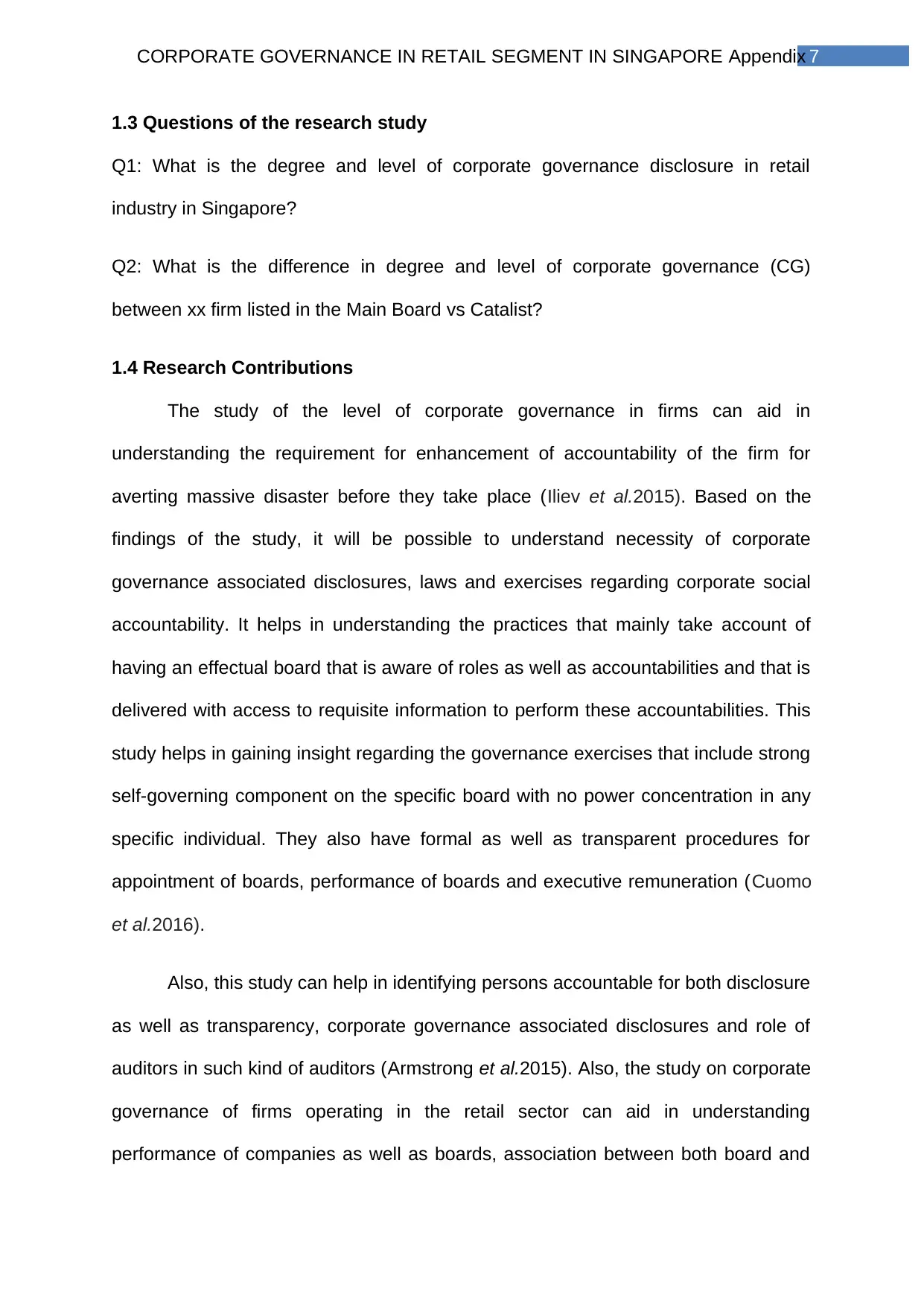
7CORPORATE GOVERNANCE IN RETAIL SEGMENT IN SINGAPORE Appendix
1.3 Questions of the research study
Q1: What is the degree and level of corporate governance disclosure in retail
industry in Singapore?
Q2: What is the difference in degree and level of corporate governance (CG)
between xx firm listed in the Main Board vs Catalist?
1.4 Research Contributions
The study of the level of corporate governance in firms can aid in
understanding the requirement for enhancement of accountability of the firm for
averting massive disaster before they take place (Iliev et al.2015). Based on the
findings of the study, it will be possible to understand necessity of corporate
governance associated disclosures, laws and exercises regarding corporate social
accountability. It helps in understanding the practices that mainly take account of
having an effectual board that is aware of roles as well as accountabilities and that is
delivered with access to requisite information to perform these accountabilities. This
study helps in gaining insight regarding the governance exercises that include strong
self-governing component on the specific board with no power concentration in any
specific individual. They also have formal as well as transparent procedures for
appointment of boards, performance of boards and executive remuneration (Cuomo
et al.2016).
Also, this study can help in identifying persons accountable for both disclosure
as well as transparency, corporate governance associated disclosures and role of
auditors in such kind of auditors (Armstrong et al.2015). Also, the study on corporate
governance of firms operating in the retail sector can aid in understanding
performance of companies as well as boards, association between both board and
1.3 Questions of the research study
Q1: What is the degree and level of corporate governance disclosure in retail
industry in Singapore?
Q2: What is the difference in degree and level of corporate governance (CG)
between xx firm listed in the Main Board vs Catalist?
1.4 Research Contributions
The study of the level of corporate governance in firms can aid in
understanding the requirement for enhancement of accountability of the firm for
averting massive disaster before they take place (Iliev et al.2015). Based on the
findings of the study, it will be possible to understand necessity of corporate
governance associated disclosures, laws and exercises regarding corporate social
accountability. It helps in understanding the practices that mainly take account of
having an effectual board that is aware of roles as well as accountabilities and that is
delivered with access to requisite information to perform these accountabilities. This
study helps in gaining insight regarding the governance exercises that include strong
self-governing component on the specific board with no power concentration in any
specific individual. They also have formal as well as transparent procedures for
appointment of boards, performance of boards and executive remuneration (Cuomo
et al.2016).
Also, this study can help in identifying persons accountable for both disclosure
as well as transparency, corporate governance associated disclosures and role of
auditors in such kind of auditors (Armstrong et al.2015). Also, the study on corporate
governance of firms operating in the retail sector can aid in understanding
performance of companies as well as boards, association between both board and
Paraphrase This Document
Need a fresh take? Get an instant paraphrase of this document with our AI Paraphraser
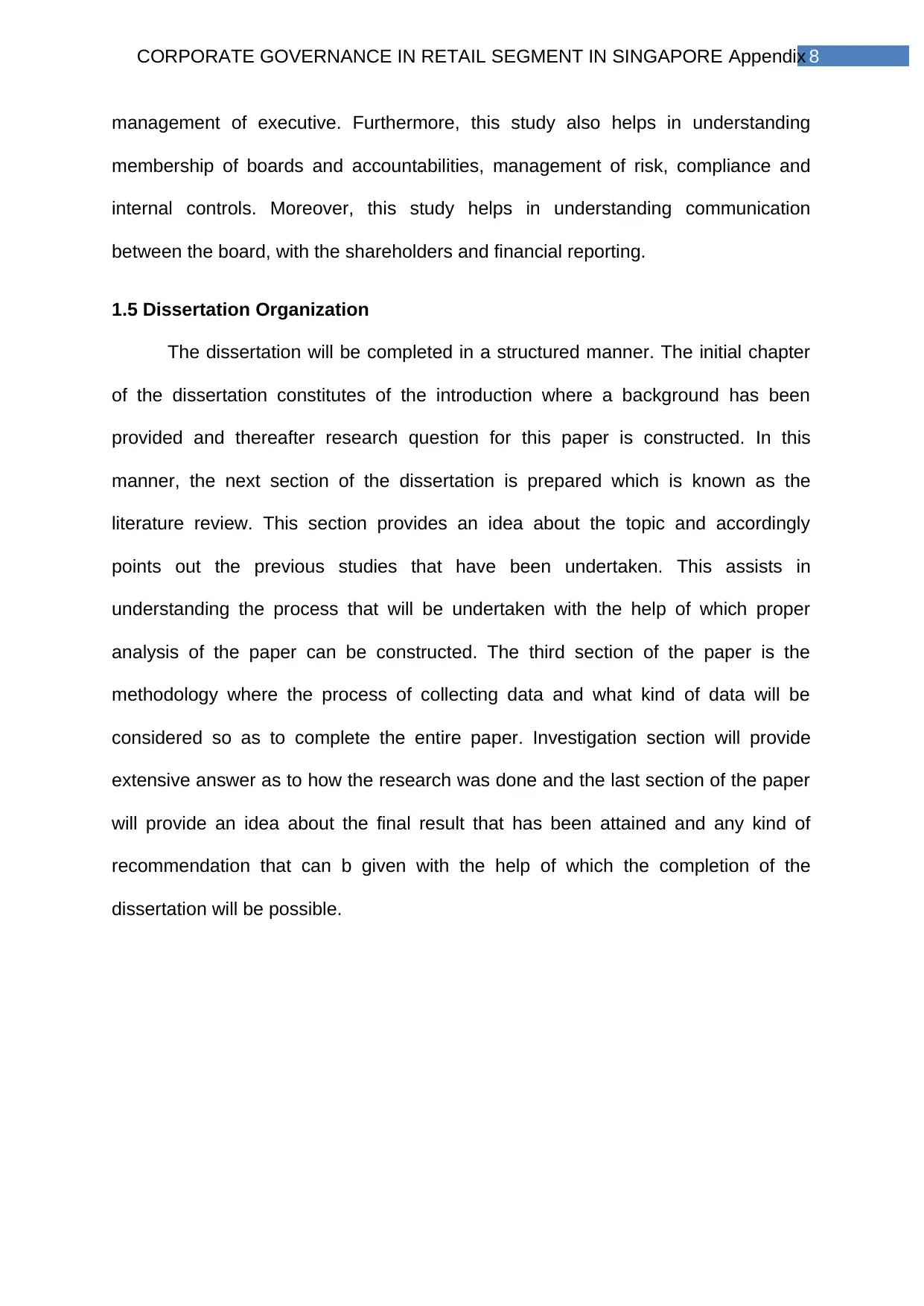
8CORPORATE GOVERNANCE IN RETAIL SEGMENT IN SINGAPORE Appendix
management of executive. Furthermore, this study also helps in understanding
membership of boards and accountabilities, management of risk, compliance and
internal controls. Moreover, this study helps in understanding communication
between the board, with the shareholders and financial reporting.
1.5 Dissertation Organization
The dissertation will be completed in a structured manner. The initial chapter
of the dissertation constitutes of the introduction where a background has been
provided and thereafter research question for this paper is constructed. In this
manner, the next section of the dissertation is prepared which is known as the
literature review. This section provides an idea about the topic and accordingly
points out the previous studies that have been undertaken. This assists in
understanding the process that will be undertaken with the help of which proper
analysis of the paper can be constructed. The third section of the paper is the
methodology where the process of collecting data and what kind of data will be
considered so as to complete the entire paper. Investigation section will provide
extensive answer as to how the research was done and the last section of the paper
will provide an idea about the final result that has been attained and any kind of
recommendation that can b given with the help of which the completion of the
dissertation will be possible.
management of executive. Furthermore, this study also helps in understanding
membership of boards and accountabilities, management of risk, compliance and
internal controls. Moreover, this study helps in understanding communication
between the board, with the shareholders and financial reporting.
1.5 Dissertation Organization
The dissertation will be completed in a structured manner. The initial chapter
of the dissertation constitutes of the introduction where a background has been
provided and thereafter research question for this paper is constructed. In this
manner, the next section of the dissertation is prepared which is known as the
literature review. This section provides an idea about the topic and accordingly
points out the previous studies that have been undertaken. This assists in
understanding the process that will be undertaken with the help of which proper
analysis of the paper can be constructed. The third section of the paper is the
methodology where the process of collecting data and what kind of data will be
considered so as to complete the entire paper. Investigation section will provide
extensive answer as to how the research was done and the last section of the paper
will provide an idea about the final result that has been attained and any kind of
recommendation that can b given with the help of which the completion of the
dissertation will be possible.
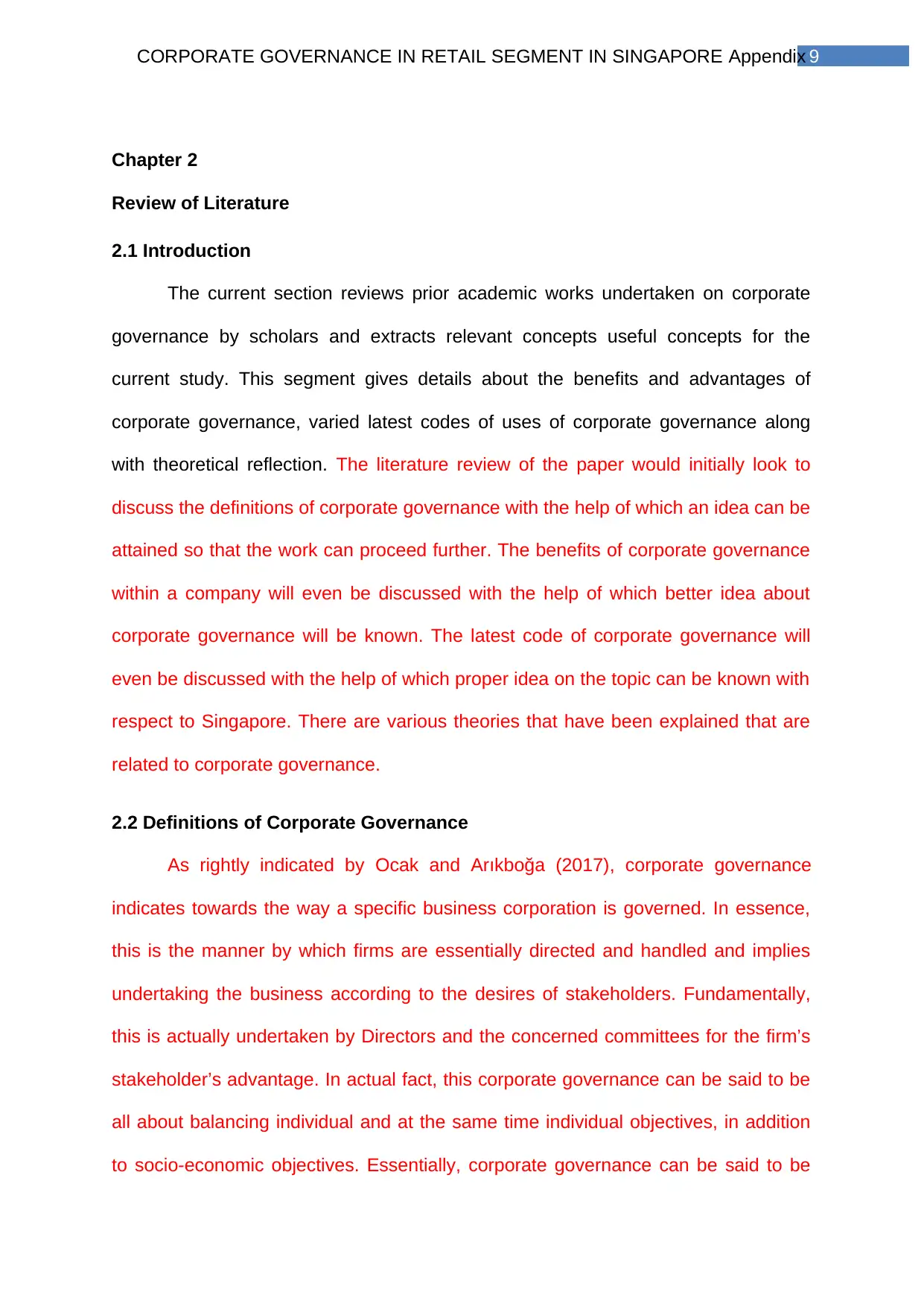
9CORPORATE GOVERNANCE IN RETAIL SEGMENT IN SINGAPORE Appendix
Chapter 2
Review of Literature
2.1 Introduction
The current section reviews prior academic works undertaken on corporate
governance by scholars and extracts relevant concepts useful concepts for the
current study. This segment gives details about the benefits and advantages of
corporate governance, varied latest codes of uses of corporate governance along
with theoretical reflection. The literature review of the paper would initially look to
discuss the definitions of corporate governance with the help of which an idea can be
attained so that the work can proceed further. The benefits of corporate governance
within a company will even be discussed with the help of which better idea about
corporate governance will be known. The latest code of corporate governance will
even be discussed with the help of which proper idea on the topic can be known with
respect to Singapore. There are various theories that have been explained that are
related to corporate governance.
2.2 Definitions of Corporate Governance
As rightly indicated by Ocak and Arıkboğa (2017), corporate governance
indicates towards the way a specific business corporation is governed. In essence,
this is the manner by which firms are essentially directed and handled and implies
undertaking the business according to the desires of stakeholders. Fundamentally,
this is actually undertaken by Directors and the concerned committees for the firm’s
stakeholder’s advantage. In actual fact, this corporate governance can be said to be
all about balancing individual and at the same time individual objectives, in addition
to socio-economic objectives. Essentially, corporate governance can be said to be
Chapter 2
Review of Literature
2.1 Introduction
The current section reviews prior academic works undertaken on corporate
governance by scholars and extracts relevant concepts useful concepts for the
current study. This segment gives details about the benefits and advantages of
corporate governance, varied latest codes of uses of corporate governance along
with theoretical reflection. The literature review of the paper would initially look to
discuss the definitions of corporate governance with the help of which an idea can be
attained so that the work can proceed further. The benefits of corporate governance
within a company will even be discussed with the help of which better idea about
corporate governance will be known. The latest code of corporate governance will
even be discussed with the help of which proper idea on the topic can be known with
respect to Singapore. There are various theories that have been explained that are
related to corporate governance.
2.2 Definitions of Corporate Governance
As rightly indicated by Ocak and Arıkboğa (2017), corporate governance
indicates towards the way a specific business corporation is governed. In essence,
this is the manner by which firms are essentially directed and handled and implies
undertaking the business according to the desires of stakeholders. Fundamentally,
this is actually undertaken by Directors and the concerned committees for the firm’s
stakeholder’s advantage. In actual fact, this corporate governance can be said to be
all about balancing individual and at the same time individual objectives, in addition
to socio-economic objectives. Essentially, corporate governance can be said to be
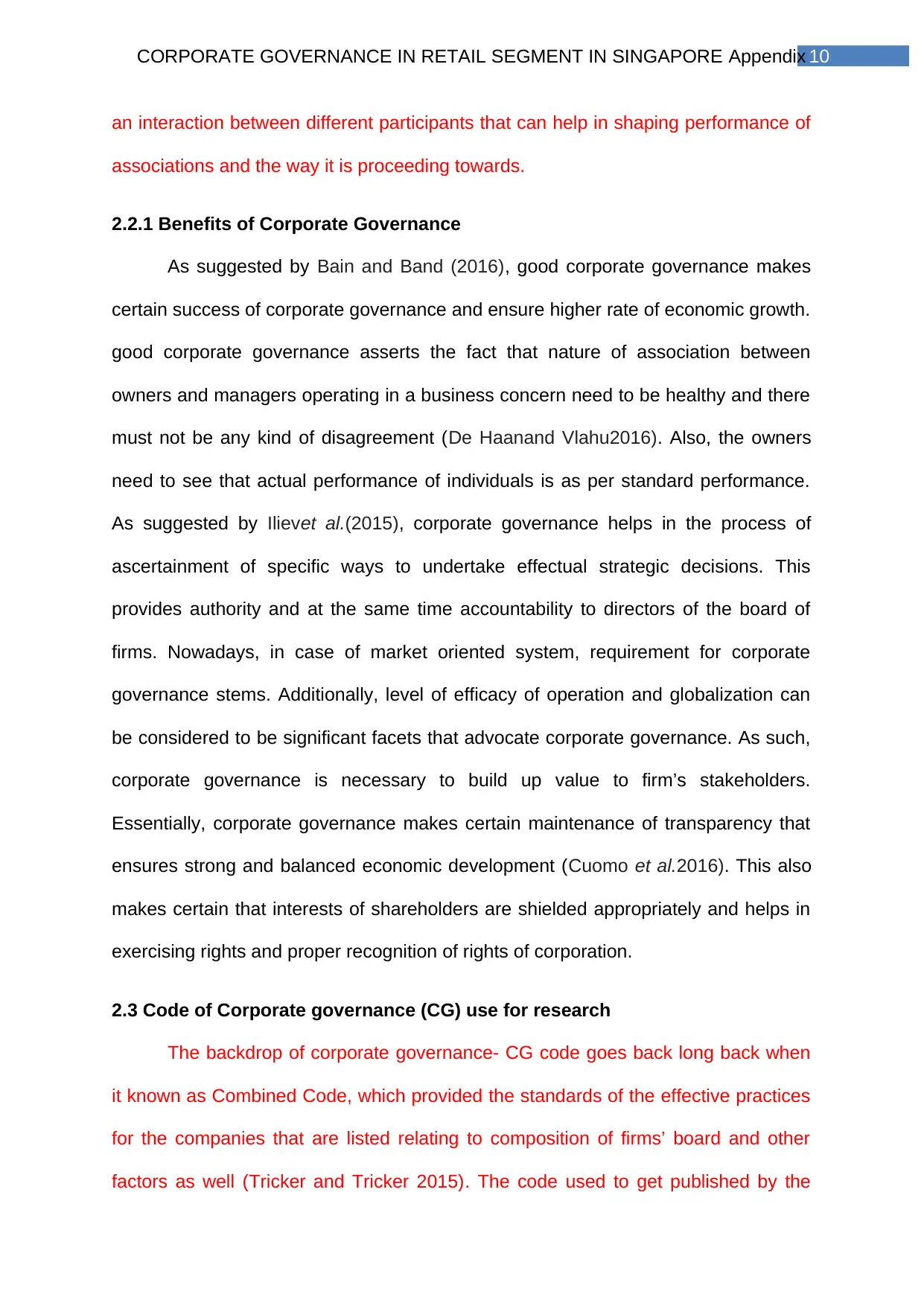
10CORPORATE GOVERNANCE IN RETAIL SEGMENT IN SINGAPORE Appendix
an interaction between different participants that can help in shaping performance of
associations and the way it is proceeding towards.
2.2.1 Benefits of Corporate Governance
As suggested by Bain and Band (2016), good corporate governance makes
certain success of corporate governance and ensure higher rate of economic growth.
good corporate governance asserts the fact that nature of association between
owners and managers operating in a business concern need to be healthy and there
must not be any kind of disagreement (De Haanand Vlahu2016). Also, the owners
need to see that actual performance of individuals is as per standard performance.
As suggested by Ilievet al.(2015), corporate governance helps in the process of
ascertainment of specific ways to undertake effectual strategic decisions. This
provides authority and at the same time accountability to directors of the board of
firms. Nowadays, in case of market oriented system, requirement for corporate
governance stems. Additionally, level of efficacy of operation and globalization can
be considered to be significant facets that advocate corporate governance. As such,
corporate governance is necessary to build up value to firm’s stakeholders.
Essentially, corporate governance makes certain maintenance of transparency that
ensures strong and balanced economic development (Cuomo et al.2016). This also
makes certain that interests of shareholders are shielded appropriately and helps in
exercising rights and proper recognition of rights of corporation.
2.3 Code of Corporate governance (CG) use for research
The backdrop of corporate governance- CG code goes back long back when
it known as Combined Code, which provided the standards of the effective practices
for the companies that are listed relating to composition of firms’ board and other
factors as well (Tricker and Tricker 2015). The code used to get published by the
an interaction between different participants that can help in shaping performance of
associations and the way it is proceeding towards.
2.2.1 Benefits of Corporate Governance
As suggested by Bain and Band (2016), good corporate governance makes
certain success of corporate governance and ensure higher rate of economic growth.
good corporate governance asserts the fact that nature of association between
owners and managers operating in a business concern need to be healthy and there
must not be any kind of disagreement (De Haanand Vlahu2016). Also, the owners
need to see that actual performance of individuals is as per standard performance.
As suggested by Ilievet al.(2015), corporate governance helps in the process of
ascertainment of specific ways to undertake effectual strategic decisions. This
provides authority and at the same time accountability to directors of the board of
firms. Nowadays, in case of market oriented system, requirement for corporate
governance stems. Additionally, level of efficacy of operation and globalization can
be considered to be significant facets that advocate corporate governance. As such,
corporate governance is necessary to build up value to firm’s stakeholders.
Essentially, corporate governance makes certain maintenance of transparency that
ensures strong and balanced economic development (Cuomo et al.2016). This also
makes certain that interests of shareholders are shielded appropriately and helps in
exercising rights and proper recognition of rights of corporation.
2.3 Code of Corporate governance (CG) use for research
The backdrop of corporate governance- CG code goes back long back when
it known as Combined Code, which provided the standards of the effective practices
for the companies that are listed relating to composition of firms’ board and other
factors as well (Tricker and Tricker 2015). The code used to get published by the
Secure Best Marks with AI Grader
Need help grading? Try our AI Grader for instant feedback on your assignments.
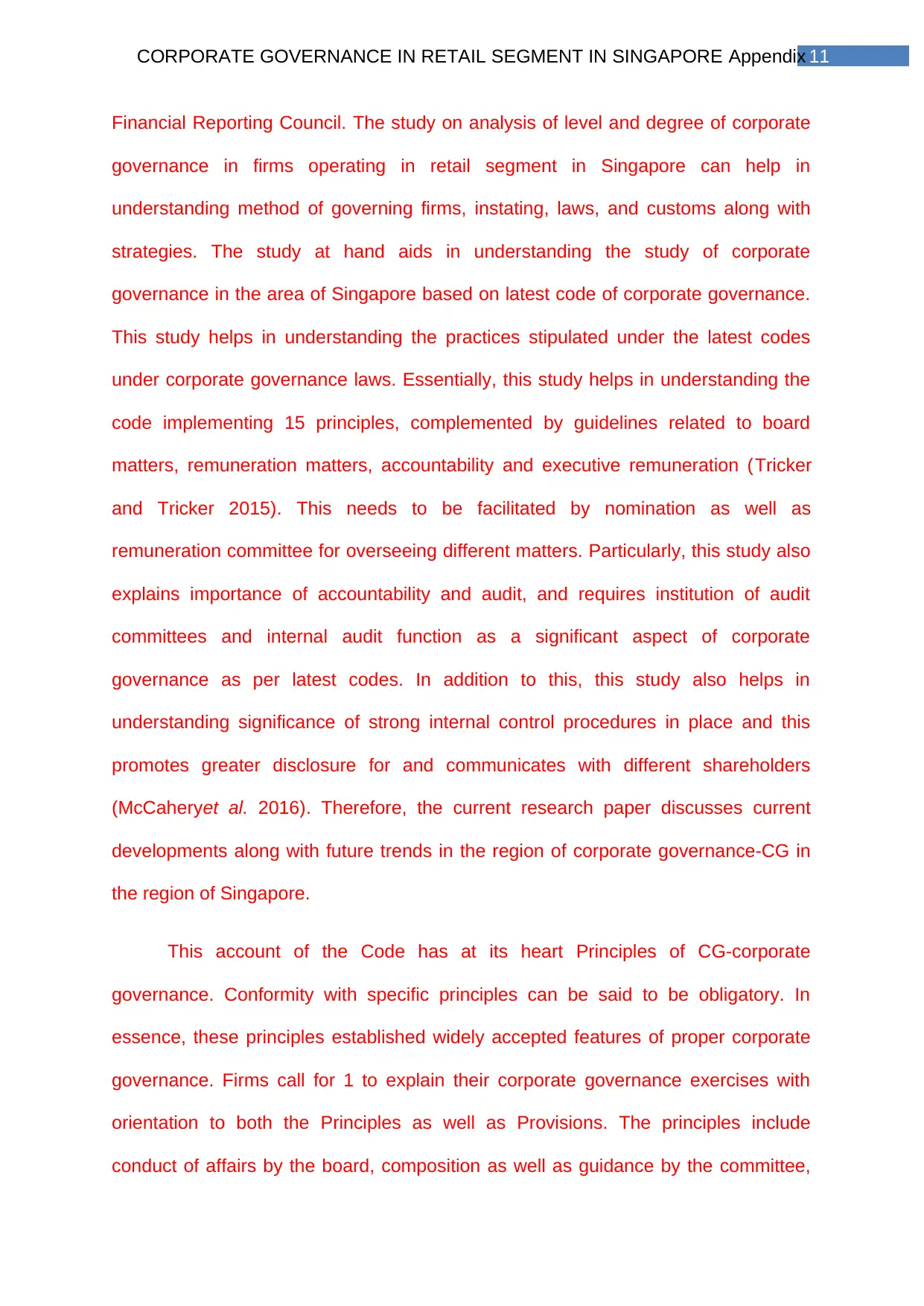
11CORPORATE GOVERNANCE IN RETAIL SEGMENT IN SINGAPORE Appendix
Financial Reporting Council. The study on analysis of level and degree of corporate
governance in firms operating in retail segment in Singapore can help in
understanding method of governing firms, instating, laws, and customs along with
strategies. The study at hand aids in understanding the study of corporate
governance in the area of Singapore based on latest code of corporate governance.
This study helps in understanding the practices stipulated under the latest codes
under corporate governance laws. Essentially, this study helps in understanding the
code implementing 15 principles, complemented by guidelines related to board
matters, remuneration matters, accountability and executive remuneration (Tricker
and Tricker 2015). This needs to be facilitated by nomination as well as
remuneration committee for overseeing different matters. Particularly, this study also
explains importance of accountability and audit, and requires institution of audit
committees and internal audit function as a significant aspect of corporate
governance as per latest codes. In addition to this, this study also helps in
understanding significance of strong internal control procedures in place and this
promotes greater disclosure for and communicates with different shareholders
(McCaheryet al. 2016). Therefore, the current research paper discusses current
developments along with future trends in the region of corporate governance-CG in
the region of Singapore.
This account of the Code has at its heart Principles of CG-corporate
governance. Conformity with specific principles can be said to be obligatory. In
essence, these principles established widely accepted features of proper corporate
governance. Firms call for 1 to explain their corporate governance exercises with
orientation to both the Principles as well as Provisions. The principles include
conduct of affairs by the board, composition as well as guidance by the committee,
Financial Reporting Council. The study on analysis of level and degree of corporate
governance in firms operating in retail segment in Singapore can help in
understanding method of governing firms, instating, laws, and customs along with
strategies. The study at hand aids in understanding the study of corporate
governance in the area of Singapore based on latest code of corporate governance.
This study helps in understanding the practices stipulated under the latest codes
under corporate governance laws. Essentially, this study helps in understanding the
code implementing 15 principles, complemented by guidelines related to board
matters, remuneration matters, accountability and executive remuneration (Tricker
and Tricker 2015). This needs to be facilitated by nomination as well as
remuneration committee for overseeing different matters. Particularly, this study also
explains importance of accountability and audit, and requires institution of audit
committees and internal audit function as a significant aspect of corporate
governance as per latest codes. In addition to this, this study also helps in
understanding significance of strong internal control procedures in place and this
promotes greater disclosure for and communicates with different shareholders
(McCaheryet al. 2016). Therefore, the current research paper discusses current
developments along with future trends in the region of corporate governance-CG in
the region of Singapore.
This account of the Code has at its heart Principles of CG-corporate
governance. Conformity with specific principles can be said to be obligatory. In
essence, these principles established widely accepted features of proper corporate
governance. Firms call for 1 to explain their corporate governance exercises with
orientation to both the Principles as well as Provisions. The principles include
conduct of affairs by the board, composition as well as guidance by the committee,
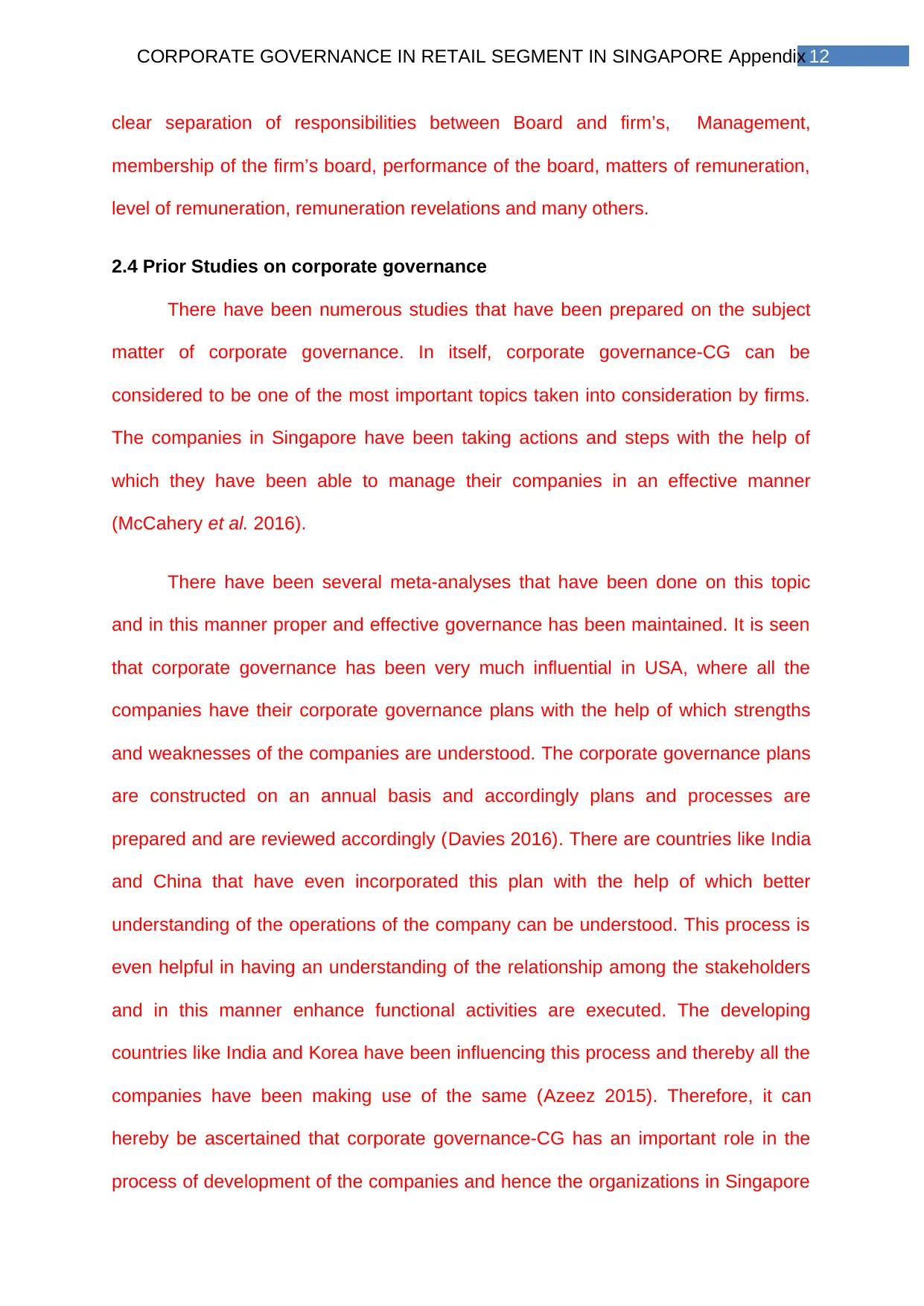
12CORPORATE GOVERNANCE IN RETAIL SEGMENT IN SINGAPORE Appendix
clear separation of responsibilities between Board and firm’s, Management,
membership of the firm’s board, performance of the board, matters of remuneration,
level of remuneration, remuneration revelations and many others.
2.4 Prior Studies on corporate governance
There have been numerous studies that have been prepared on the subject
matter of corporate governance. In itself, corporate governance-CG can be
considered to be one of the most important topics taken into consideration by firms.
The companies in Singapore have been taking actions and steps with the help of
which they have been able to manage their companies in an effective manner
(McCahery et al. 2016).
There have been several meta-analyses that have been done on this topic
and in this manner proper and effective governance has been maintained. It is seen
that corporate governance has been very much influential in USA, where all the
companies have their corporate governance plans with the help of which strengths
and weaknesses of the companies are understood. The corporate governance plans
are constructed on an annual basis and accordingly plans and processes are
prepared and are reviewed accordingly (Davies 2016). There are countries like India
and China that have even incorporated this plan with the help of which better
understanding of the operations of the company can be understood. This process is
even helpful in having an understanding of the relationship among the stakeholders
and in this manner enhance functional activities are executed. The developing
countries like India and Korea have been influencing this process and thereby all the
companies have been making use of the same (Azeez 2015). Therefore, it can
hereby be ascertained that corporate governance-CG has an important role in the
process of development of the companies and hence the organizations in Singapore
clear separation of responsibilities between Board and firm’s, Management,
membership of the firm’s board, performance of the board, matters of remuneration,
level of remuneration, remuneration revelations and many others.
2.4 Prior Studies on corporate governance
There have been numerous studies that have been prepared on the subject
matter of corporate governance. In itself, corporate governance-CG can be
considered to be one of the most important topics taken into consideration by firms.
The companies in Singapore have been taking actions and steps with the help of
which they have been able to manage their companies in an effective manner
(McCahery et al. 2016).
There have been several meta-analyses that have been done on this topic
and in this manner proper and effective governance has been maintained. It is seen
that corporate governance has been very much influential in USA, where all the
companies have their corporate governance plans with the help of which strengths
and weaknesses of the companies are understood. The corporate governance plans
are constructed on an annual basis and accordingly plans and processes are
prepared and are reviewed accordingly (Davies 2016). There are countries like India
and China that have even incorporated this plan with the help of which better
understanding of the operations of the company can be understood. This process is
even helpful in having an understanding of the relationship among the stakeholders
and in this manner enhance functional activities are executed. The developing
countries like India and Korea have been influencing this process and thereby all the
companies have been making use of the same (Azeez 2015). Therefore, it can
hereby be ascertained that corporate governance-CG has an important role in the
process of development of the companies and hence the organizations in Singapore
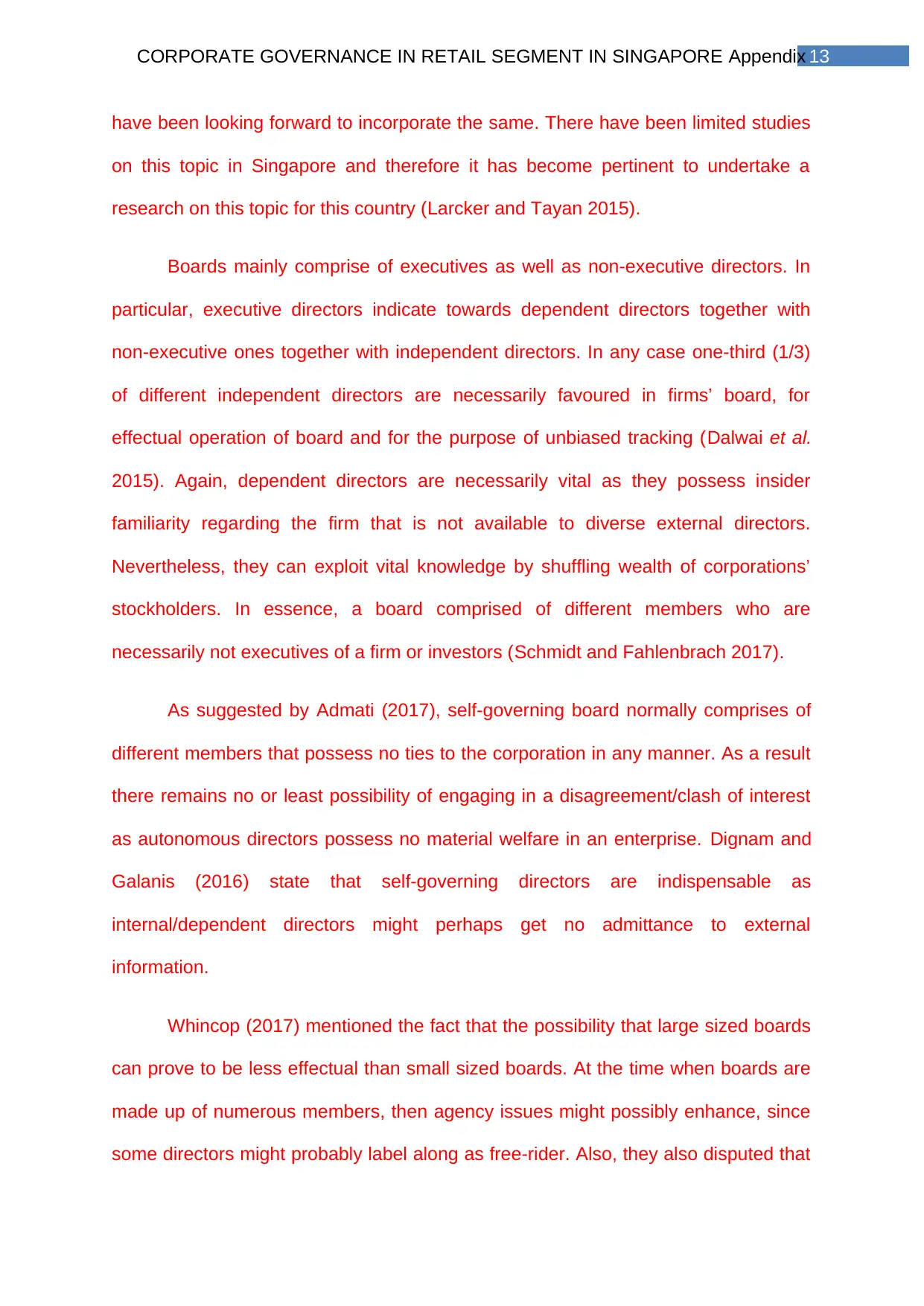
13CORPORATE GOVERNANCE IN RETAIL SEGMENT IN SINGAPORE Appendix
have been looking forward to incorporate the same. There have been limited studies
on this topic in Singapore and therefore it has become pertinent to undertake a
research on this topic for this country (Larcker and Tayan 2015).
Boards mainly comprise of executives as well as non-executive directors. In
particular, executive directors indicate towards dependent directors together with
non-executive ones together with independent directors. In any case one-third (1/3)
of different independent directors are necessarily favoured in firms’ board, for
effectual operation of board and for the purpose of unbiased tracking (Dalwai et al.
2015). Again, dependent directors are necessarily vital as they possess insider
familiarity regarding the firm that is not available to diverse external directors.
Nevertheless, they can exploit vital knowledge by shuffling wealth of corporations’
stockholders. In essence, a board comprised of different members who are
necessarily not executives of a firm or investors (Schmidt and Fahlenbrach 2017).
As suggested by Admati (2017), self-governing board normally comprises of
different members that possess no ties to the corporation in any manner. As a result
there remains no or least possibility of engaging in a disagreement/clash of interest
as autonomous directors possess no material welfare in an enterprise. Dignam and
Galanis (2016) state that self-governing directors are indispensable as
internal/dependent directors might perhaps get no admittance to external
information.
Whincop (2017) mentioned the fact that the possibility that large sized boards
can prove to be less effectual than small sized boards. At the time when boards are
made up of numerous members, then agency issues might possibly enhance, since
some directors might probably label along as free-rider. Also, they also disputed that
have been looking forward to incorporate the same. There have been limited studies
on this topic in Singapore and therefore it has become pertinent to undertake a
research on this topic for this country (Larcker and Tayan 2015).
Boards mainly comprise of executives as well as non-executive directors. In
particular, executive directors indicate towards dependent directors together with
non-executive ones together with independent directors. In any case one-third (1/3)
of different independent directors are necessarily favoured in firms’ board, for
effectual operation of board and for the purpose of unbiased tracking (Dalwai et al.
2015). Again, dependent directors are necessarily vital as they possess insider
familiarity regarding the firm that is not available to diverse external directors.
Nevertheless, they can exploit vital knowledge by shuffling wealth of corporations’
stockholders. In essence, a board comprised of different members who are
necessarily not executives of a firm or investors (Schmidt and Fahlenbrach 2017).
As suggested by Admati (2017), self-governing board normally comprises of
different members that possess no ties to the corporation in any manner. As a result
there remains no or least possibility of engaging in a disagreement/clash of interest
as autonomous directors possess no material welfare in an enterprise. Dignam and
Galanis (2016) state that self-governing directors are indispensable as
internal/dependent directors might perhaps get no admittance to external
information.
Whincop (2017) mentioned the fact that the possibility that large sized boards
can prove to be less effectual than small sized boards. At the time when boards are
made up of numerous members, then agency issues might possibly enhance, since
some directors might probably label along as free-rider. Also, they also disputed that
Paraphrase This Document
Need a fresh take? Get an instant paraphrase of this document with our AI Paraphraser
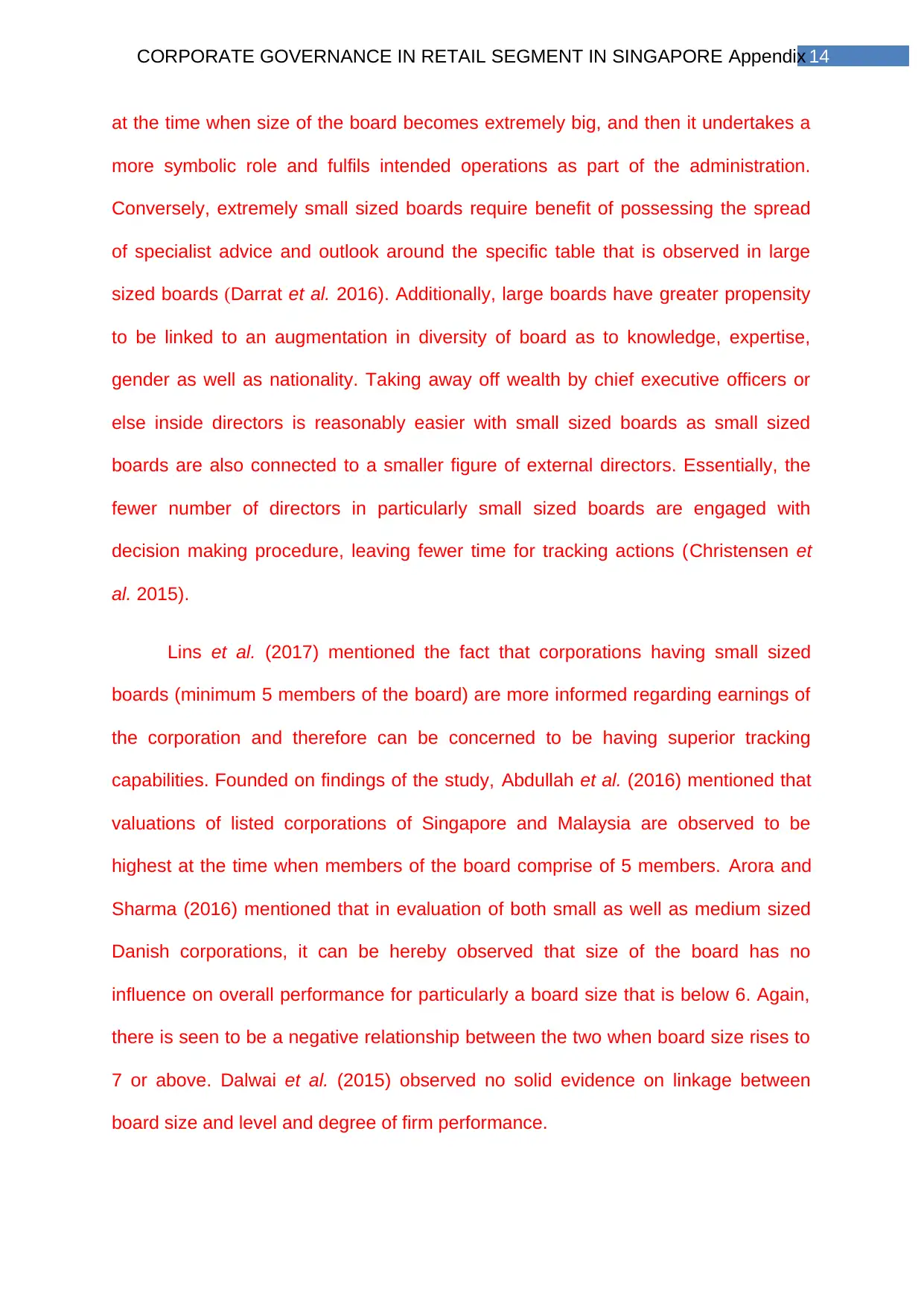
14CORPORATE GOVERNANCE IN RETAIL SEGMENT IN SINGAPORE Appendix
at the time when size of the board becomes extremely big, and then it undertakes a
more symbolic role and fulfils intended operations as part of the administration.
Conversely, extremely small sized boards require benefit of possessing the spread
of specialist advice and outlook around the specific table that is observed in large
sized boards (Darrat et al. 2016). Additionally, large boards have greater propensity
to be linked to an augmentation in diversity of board as to knowledge, expertise,
gender as well as nationality. Taking away off wealth by chief executive officers or
else inside directors is reasonably easier with small sized boards as small sized
boards are also connected to a smaller figure of external directors. Essentially, the
fewer number of directors in particularly small sized boards are engaged with
decision making procedure, leaving fewer time for tracking actions (Christensen et
al. 2015).
Lins et al. (2017) mentioned the fact that corporations having small sized
boards (minimum 5 members of the board) are more informed regarding earnings of
the corporation and therefore can be concerned to be having superior tracking
capabilities. Founded on findings of the study, Abdullah et al. (2016) mentioned that
valuations of listed corporations of Singapore and Malaysia are observed to be
highest at the time when members of the board comprise of 5 members. Arora and
Sharma (2016) mentioned that in evaluation of both small as well as medium sized
Danish corporations, it can be hereby observed that size of the board has no
influence on overall performance for particularly a board size that is below 6. Again,
there is seen to be a negative relationship between the two when board size rises to
7 or above. Dalwai et al. (2015) observed no solid evidence on linkage between
board size and level and degree of firm performance.
at the time when size of the board becomes extremely big, and then it undertakes a
more symbolic role and fulfils intended operations as part of the administration.
Conversely, extremely small sized boards require benefit of possessing the spread
of specialist advice and outlook around the specific table that is observed in large
sized boards (Darrat et al. 2016). Additionally, large boards have greater propensity
to be linked to an augmentation in diversity of board as to knowledge, expertise,
gender as well as nationality. Taking away off wealth by chief executive officers or
else inside directors is reasonably easier with small sized boards as small sized
boards are also connected to a smaller figure of external directors. Essentially, the
fewer number of directors in particularly small sized boards are engaged with
decision making procedure, leaving fewer time for tracking actions (Christensen et
al. 2015).
Lins et al. (2017) mentioned the fact that corporations having small sized
boards (minimum 5 members of the board) are more informed regarding earnings of
the corporation and therefore can be concerned to be having superior tracking
capabilities. Founded on findings of the study, Abdullah et al. (2016) mentioned that
valuations of listed corporations of Singapore and Malaysia are observed to be
highest at the time when members of the board comprise of 5 members. Arora and
Sharma (2016) mentioned that in evaluation of both small as well as medium sized
Danish corporations, it can be hereby observed that size of the board has no
influence on overall performance for particularly a board size that is below 6. Again,
there is seen to be a negative relationship between the two when board size rises to
7 or above. Dalwai et al. (2015) observed no solid evidence on linkage between
board size and level and degree of firm performance.
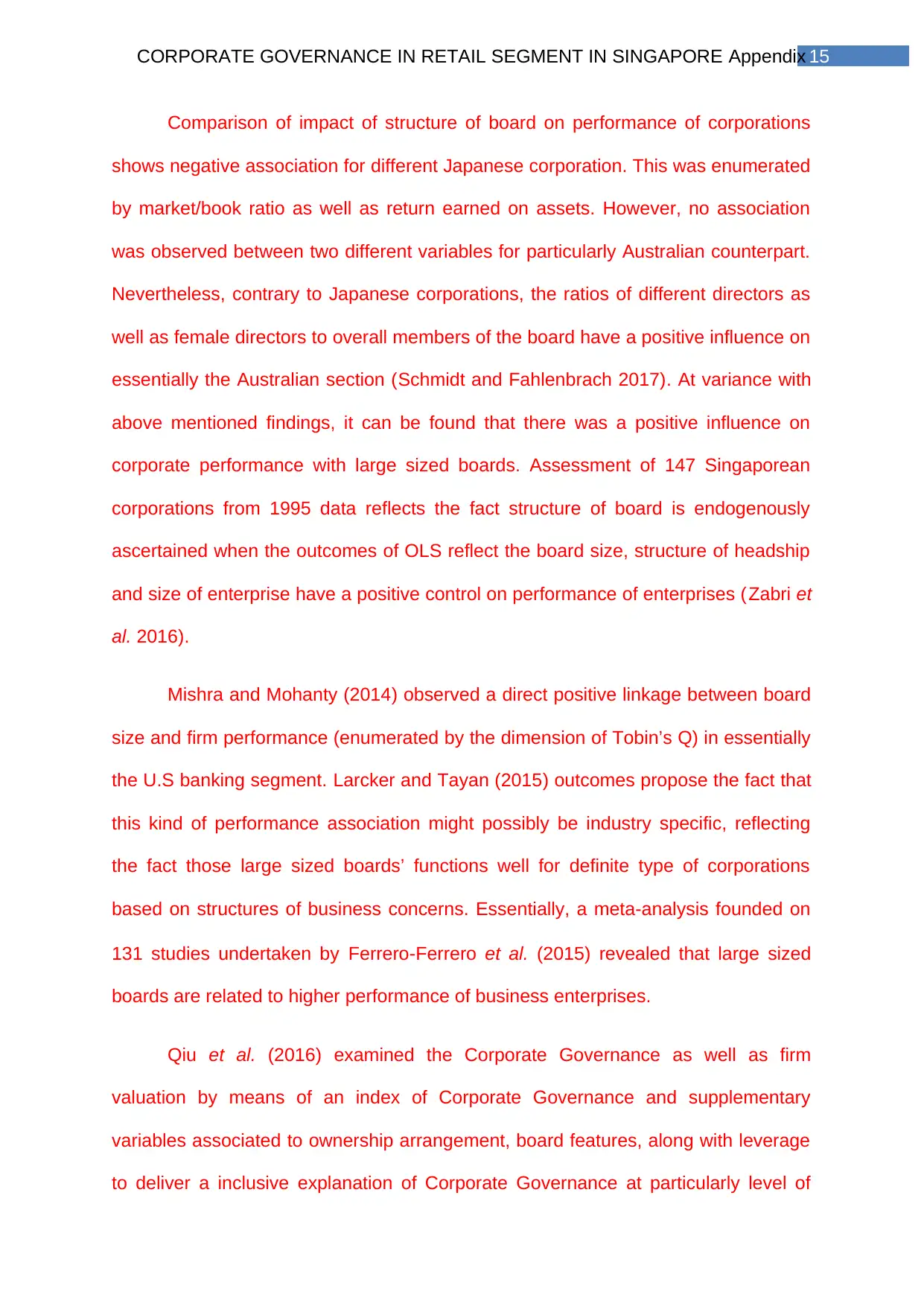
15CORPORATE GOVERNANCE IN RETAIL SEGMENT IN SINGAPORE Appendix
Comparison of impact of structure of board on performance of corporations
shows negative association for different Japanese corporation. This was enumerated
by market/book ratio as well as return earned on assets. However, no association
was observed between two different variables for particularly Australian counterpart.
Nevertheless, contrary to Japanese corporations, the ratios of different directors as
well as female directors to overall members of the board have a positive influence on
essentially the Australian section (Schmidt and Fahlenbrach 2017). At variance with
above mentioned findings, it can be found that there was a positive influence on
corporate performance with large sized boards. Assessment of 147 Singaporean
corporations from 1995 data reflects the fact structure of board is endogenously
ascertained when the outcomes of OLS reflect the board size, structure of headship
and size of enterprise have a positive control on performance of enterprises (Zabri et
al. 2016).
Mishra and Mohanty (2014) observed a direct positive linkage between board
size and firm performance (enumerated by the dimension of Tobin’s Q) in essentially
the U.S banking segment. Larcker and Tayan (2015) outcomes propose the fact that
this kind of performance association might possibly be industry specific, reflecting
the fact those large sized boards’ functions well for definite type of corporations
based on structures of business concerns. Essentially, a meta-analysis founded on
131 studies undertaken by Ferrero‐Ferrero et al. (2015) revealed that large sized
boards are related to higher performance of business enterprises.
Qiu et al. (2016) examined the Corporate Governance as well as firm
valuation by means of an index of Corporate Governance and supplementary
variables associated to ownership arrangement, board features, along with leverage
to deliver a inclusive explanation of Corporate Governance at particularly level of
Comparison of impact of structure of board on performance of corporations
shows negative association for different Japanese corporation. This was enumerated
by market/book ratio as well as return earned on assets. However, no association
was observed between two different variables for particularly Australian counterpart.
Nevertheless, contrary to Japanese corporations, the ratios of different directors as
well as female directors to overall members of the board have a positive influence on
essentially the Australian section (Schmidt and Fahlenbrach 2017). At variance with
above mentioned findings, it can be found that there was a positive influence on
corporate performance with large sized boards. Assessment of 147 Singaporean
corporations from 1995 data reflects the fact structure of board is endogenously
ascertained when the outcomes of OLS reflect the board size, structure of headship
and size of enterprise have a positive control on performance of enterprises (Zabri et
al. 2016).
Mishra and Mohanty (2014) observed a direct positive linkage between board
size and firm performance (enumerated by the dimension of Tobin’s Q) in essentially
the U.S banking segment. Larcker and Tayan (2015) outcomes propose the fact that
this kind of performance association might possibly be industry specific, reflecting
the fact those large sized boards’ functions well for definite type of corporations
based on structures of business concerns. Essentially, a meta-analysis founded on
131 studies undertaken by Ferrero‐Ferrero et al. (2015) revealed that large sized
boards are related to higher performance of business enterprises.
Qiu et al. (2016) examined the Corporate Governance as well as firm
valuation by means of an index of Corporate Governance and supplementary
variables associated to ownership arrangement, board features, along with leverage
to deliver a inclusive explanation of Corporate Governance at particularly level of
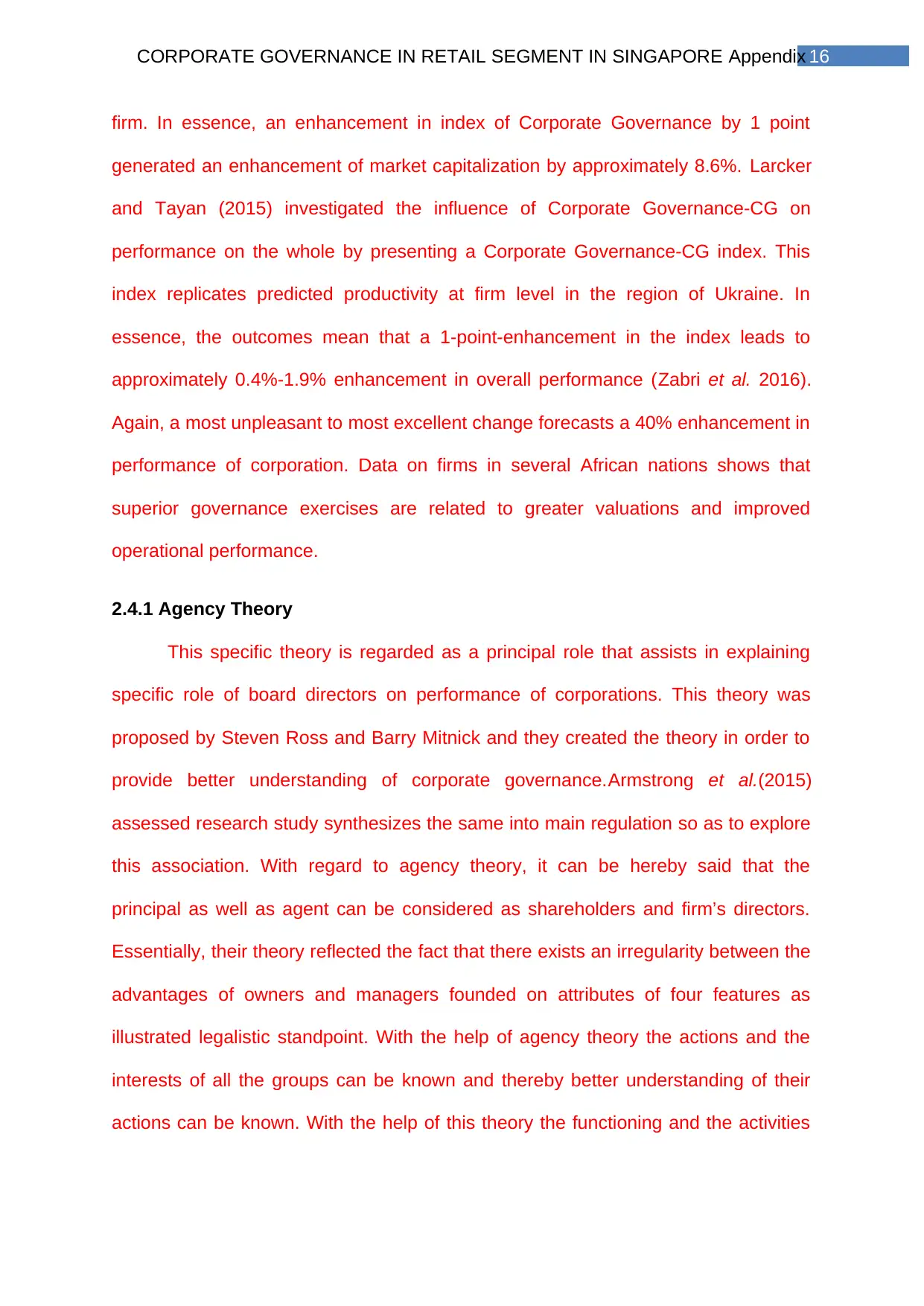
16CORPORATE GOVERNANCE IN RETAIL SEGMENT IN SINGAPORE Appendix
firm. In essence, an enhancement in index of Corporate Governance by 1 point
generated an enhancement of market capitalization by approximately 8.6%. Larcker
and Tayan (2015) investigated the influence of Corporate Governance-CG on
performance on the whole by presenting a Corporate Governance-CG index. This
index replicates predicted productivity at firm level in the region of Ukraine. In
essence, the outcomes mean that a 1-point-enhancement in the index leads to
approximately 0.4%-1.9% enhancement in overall performance (Zabri et al. 2016).
Again, a most unpleasant to most excellent change forecasts a 40% enhancement in
performance of corporation. Data on firms in several African nations shows that
superior governance exercises are related to greater valuations and improved
operational performance.
2.4.1 Agency Theory
This specific theory is regarded as a principal role that assists in explaining
specific role of board directors on performance of corporations. This theory was
proposed by Steven Ross and Barry Mitnick and they created the theory in order to
provide better understanding of corporate governance.Armstrong et al.(2015)
assessed research study synthesizes the same into main regulation so as to explore
this association. With regard to agency theory, it can be hereby said that the
principal as well as agent can be considered as shareholders and firm’s directors.
Essentially, their theory reflected the fact that there exists an irregularity between the
advantages of owners and managers founded on attributes of four features as
illustrated legalistic standpoint. With the help of agency theory the actions and the
interests of all the groups can be known and thereby better understanding of their
actions can be known. With the help of this theory the functioning and the activities
firm. In essence, an enhancement in index of Corporate Governance by 1 point
generated an enhancement of market capitalization by approximately 8.6%. Larcker
and Tayan (2015) investigated the influence of Corporate Governance-CG on
performance on the whole by presenting a Corporate Governance-CG index. This
index replicates predicted productivity at firm level in the region of Ukraine. In
essence, the outcomes mean that a 1-point-enhancement in the index leads to
approximately 0.4%-1.9% enhancement in overall performance (Zabri et al. 2016).
Again, a most unpleasant to most excellent change forecasts a 40% enhancement in
performance of corporation. Data on firms in several African nations shows that
superior governance exercises are related to greater valuations and improved
operational performance.
2.4.1 Agency Theory
This specific theory is regarded as a principal role that assists in explaining
specific role of board directors on performance of corporations. This theory was
proposed by Steven Ross and Barry Mitnick and they created the theory in order to
provide better understanding of corporate governance.Armstrong et al.(2015)
assessed research study synthesizes the same into main regulation so as to explore
this association. With regard to agency theory, it can be hereby said that the
principal as well as agent can be considered as shareholders and firm’s directors.
Essentially, their theory reflected the fact that there exists an irregularity between the
advantages of owners and managers founded on attributes of four features as
illustrated legalistic standpoint. With the help of agency theory the actions and the
interests of all the groups can be known and thereby better understanding of their
actions can be known. With the help of this theory the functioning and the activities
Secure Best Marks with AI Grader
Need help grading? Try our AI Grader for instant feedback on your assignments.
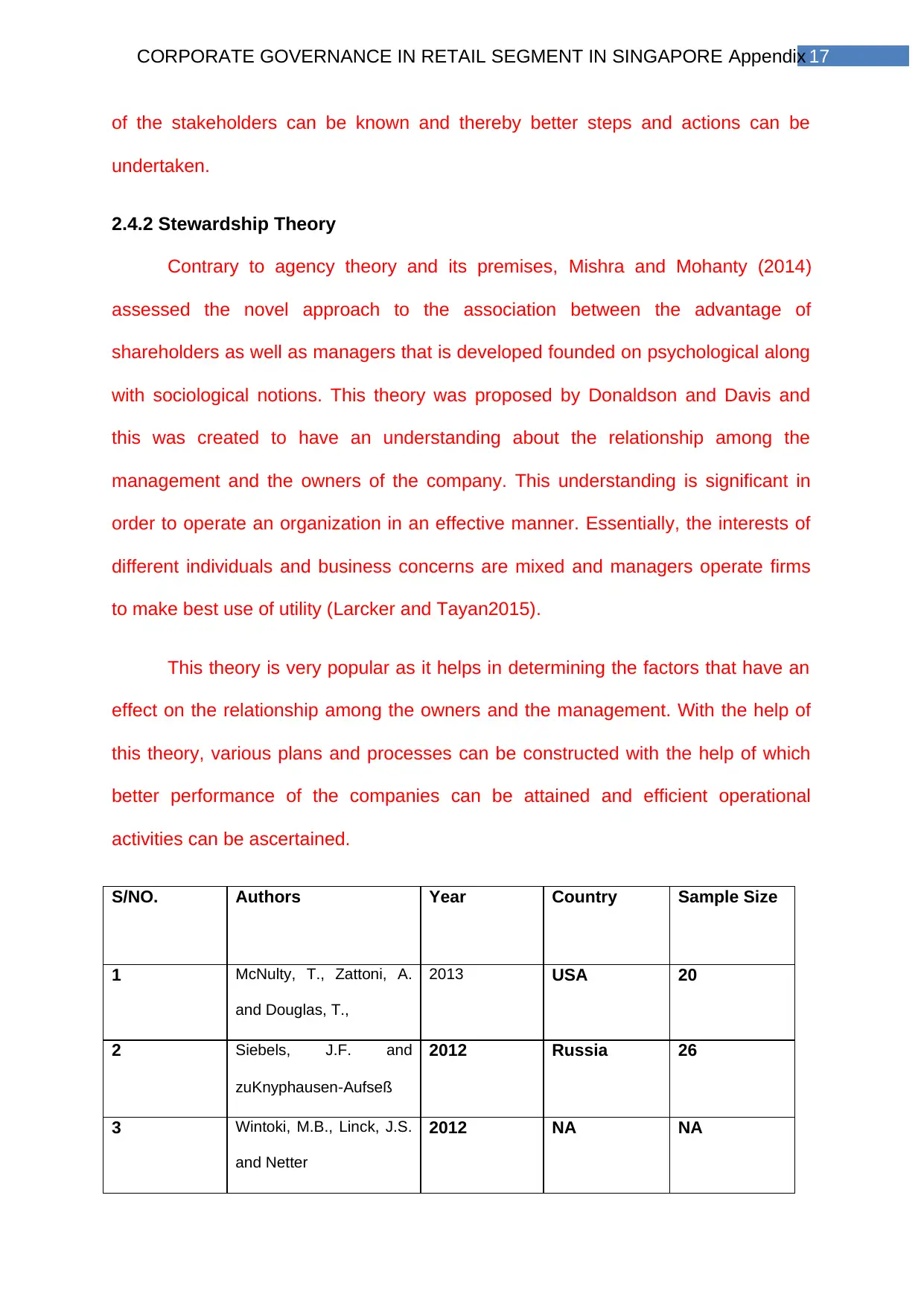
17CORPORATE GOVERNANCE IN RETAIL SEGMENT IN SINGAPORE Appendix
of the stakeholders can be known and thereby better steps and actions can be
undertaken.
2.4.2 Stewardship Theory
Contrary to agency theory and its premises, Mishra and Mohanty (2014)
assessed the novel approach to the association between the advantage of
shareholders as well as managers that is developed founded on psychological along
with sociological notions. This theory was proposed by Donaldson and Davis and
this was created to have an understanding about the relationship among the
management and the owners of the company. This understanding is significant in
order to operate an organization in an effective manner. Essentially, the interests of
different individuals and business concerns are mixed and managers operate firms
to make best use of utility (Larcker and Tayan2015).
This theory is very popular as it helps in determining the factors that have an
effect on the relationship among the owners and the management. With the help of
this theory, various plans and processes can be constructed with the help of which
better performance of the companies can be attained and efficient operational
activities can be ascertained.
S/NO. Authors Year Country Sample Size
1 McNulty, T., Zattoni, A.
and Douglas, T.,
2013 USA 20
2 Siebels, J.F. and
zuKnyphausen‐Aufseß
2012 Russia 26
3 Wintoki, M.B., Linck, J.S.
and Netter
2012 NA NA
of the stakeholders can be known and thereby better steps and actions can be
undertaken.
2.4.2 Stewardship Theory
Contrary to agency theory and its premises, Mishra and Mohanty (2014)
assessed the novel approach to the association between the advantage of
shareholders as well as managers that is developed founded on psychological along
with sociological notions. This theory was proposed by Donaldson and Davis and
this was created to have an understanding about the relationship among the
management and the owners of the company. This understanding is significant in
order to operate an organization in an effective manner. Essentially, the interests of
different individuals and business concerns are mixed and managers operate firms
to make best use of utility (Larcker and Tayan2015).
This theory is very popular as it helps in determining the factors that have an
effect on the relationship among the owners and the management. With the help of
this theory, various plans and processes can be constructed with the help of which
better performance of the companies can be attained and efficient operational
activities can be ascertained.
S/NO. Authors Year Country Sample Size
1 McNulty, T., Zattoni, A.
and Douglas, T.,
2013 USA 20
2 Siebels, J.F. and
zuKnyphausen‐Aufseß
2012 Russia 26
3 Wintoki, M.B., Linck, J.S.
and Netter
2012 NA NA
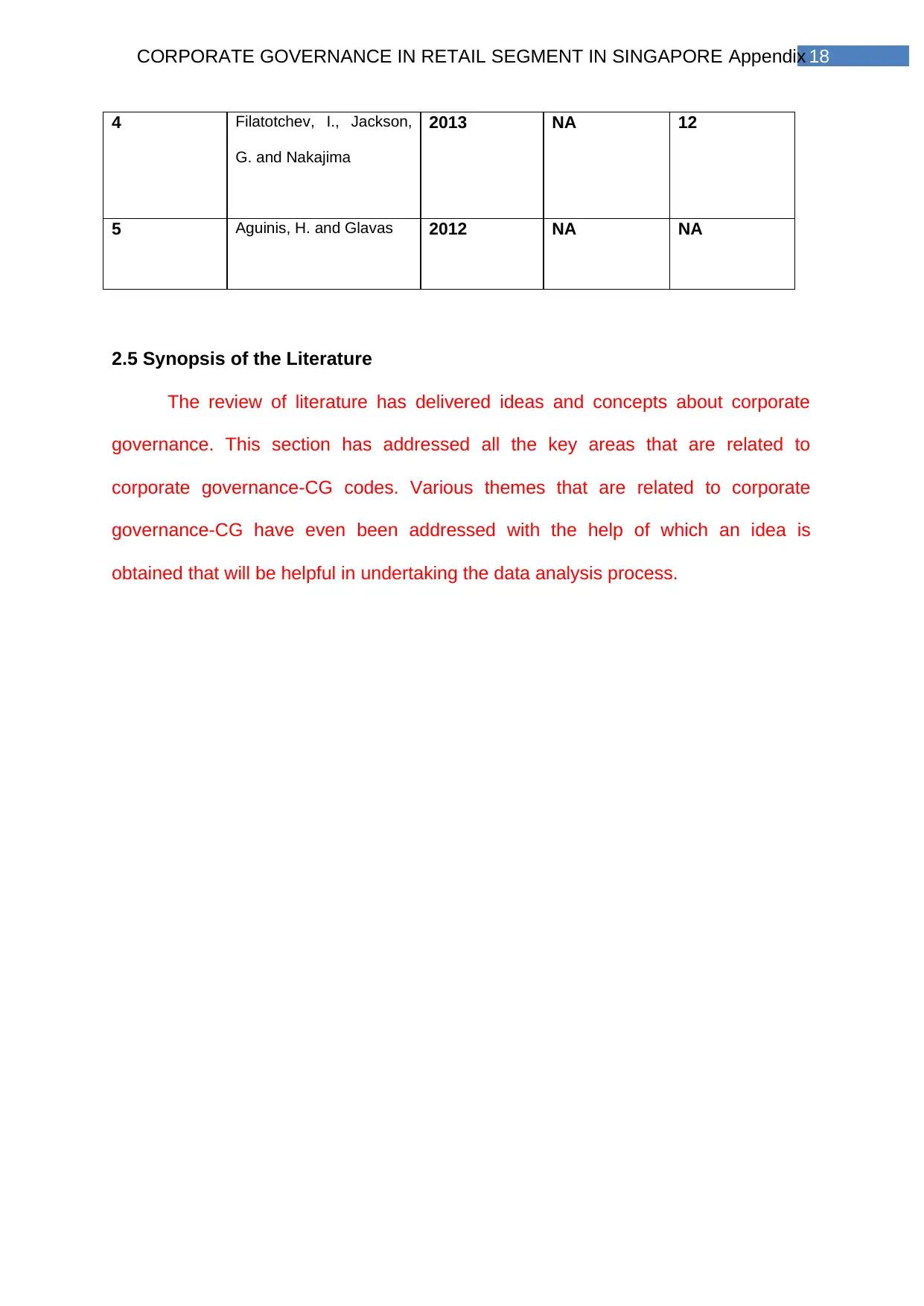
18CORPORATE GOVERNANCE IN RETAIL SEGMENT IN SINGAPORE Appendix
4 Filatotchev, I., Jackson,
G. and Nakajima
2013 NA 12
5 Aguinis, H. and Glavas 2012 NA NA
2.5 Synopsis of the Literature
The review of literature has delivered ideas and concepts about corporate
governance. This section has addressed all the key areas that are related to
corporate governance-CG codes. Various themes that are related to corporate
governance-CG have even been addressed with the help of which an idea is
obtained that will be helpful in undertaking the data analysis process.
4 Filatotchev, I., Jackson,
G. and Nakajima
2013 NA 12
5 Aguinis, H. and Glavas 2012 NA NA
2.5 Synopsis of the Literature
The review of literature has delivered ideas and concepts about corporate
governance. This section has addressed all the key areas that are related to
corporate governance-CG codes. Various themes that are related to corporate
governance-CG have even been addressed with the help of which an idea is
obtained that will be helpful in undertaking the data analysis process.
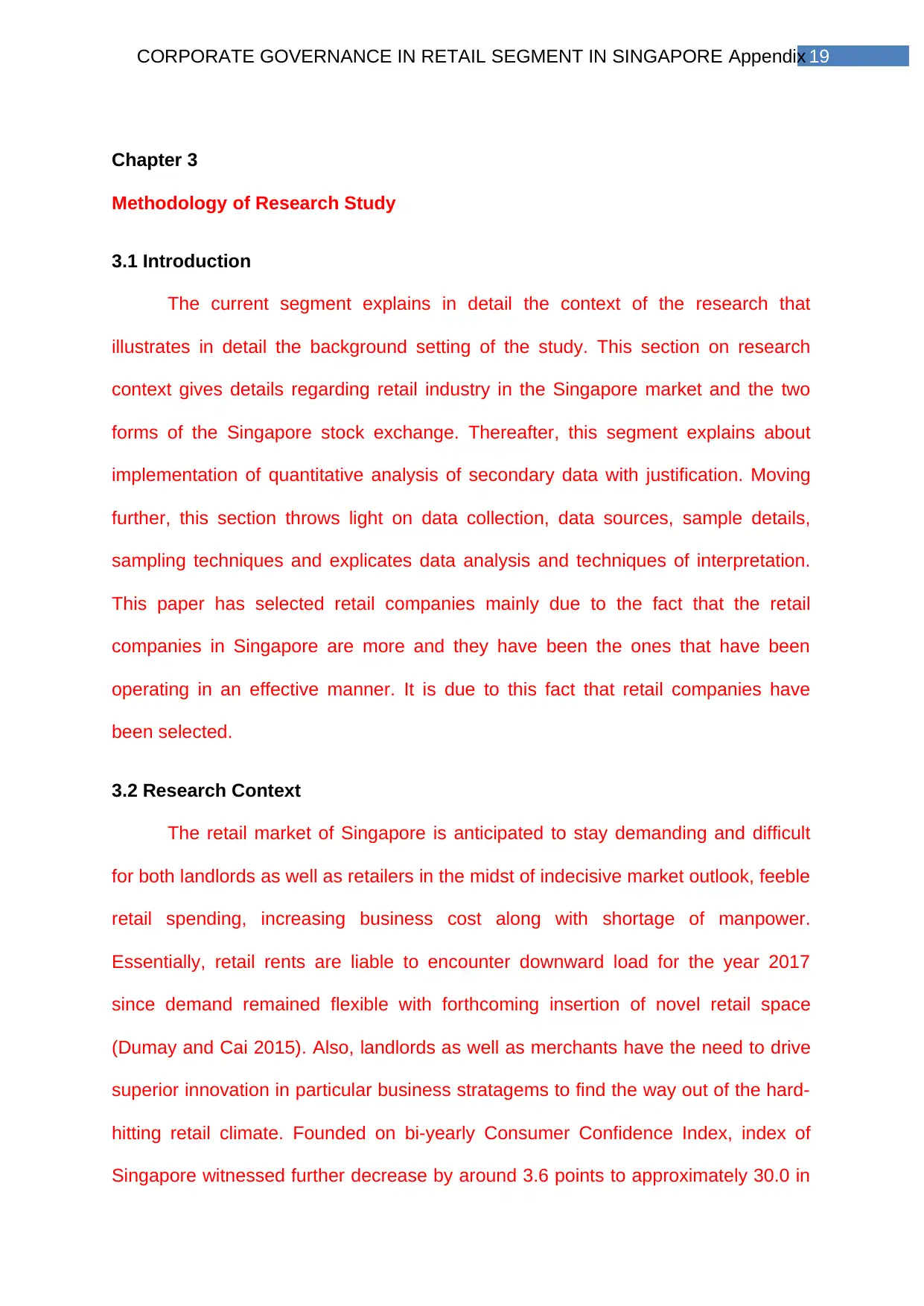
19CORPORATE GOVERNANCE IN RETAIL SEGMENT IN SINGAPORE Appendix
Chapter 3
Methodology of Research Study
3.1 Introduction
The current segment explains in detail the context of the research that
illustrates in detail the background setting of the study. This section on research
context gives details regarding retail industry in the Singapore market and the two
forms of the Singapore stock exchange. Thereafter, this segment explains about
implementation of quantitative analysis of secondary data with justification. Moving
further, this section throws light on data collection, data sources, sample details,
sampling techniques and explicates data analysis and techniques of interpretation.
This paper has selected retail companies mainly due to the fact that the retail
companies in Singapore are more and they have been the ones that have been
operating in an effective manner. It is due to this fact that retail companies have
been selected.
3.2 Research Context
The retail market of Singapore is anticipated to stay demanding and difficult
for both landlords as well as retailers in the midst of indecisive market outlook, feeble
retail spending, increasing business cost along with shortage of manpower.
Essentially, retail rents are liable to encounter downward load for the year 2017
since demand remained flexible with forthcoming insertion of novel retail space
(Dumay and Cai 2015). Also, landlords as well as merchants have the need to drive
superior innovation in particular business stratagems to find the way out of the hard-
hitting retail climate. Founded on bi-yearly Consumer Confidence Index, index of
Singapore witnessed further decrease by around 3.6 points to approximately 30.0 in
Chapter 3
Methodology of Research Study
3.1 Introduction
The current segment explains in detail the context of the research that
illustrates in detail the background setting of the study. This section on research
context gives details regarding retail industry in the Singapore market and the two
forms of the Singapore stock exchange. Thereafter, this segment explains about
implementation of quantitative analysis of secondary data with justification. Moving
further, this section throws light on data collection, data sources, sample details,
sampling techniques and explicates data analysis and techniques of interpretation.
This paper has selected retail companies mainly due to the fact that the retail
companies in Singapore are more and they have been the ones that have been
operating in an effective manner. It is due to this fact that retail companies have
been selected.
3.2 Research Context
The retail market of Singapore is anticipated to stay demanding and difficult
for both landlords as well as retailers in the midst of indecisive market outlook, feeble
retail spending, increasing business cost along with shortage of manpower.
Essentially, retail rents are liable to encounter downward load for the year 2017
since demand remained flexible with forthcoming insertion of novel retail space
(Dumay and Cai 2015). Also, landlords as well as merchants have the need to drive
superior innovation in particular business stratagems to find the way out of the hard-
hitting retail climate. Founded on bi-yearly Consumer Confidence Index, index of
Singapore witnessed further decrease by around 3.6 points to approximately 30.0 in
Paraphrase This Document
Need a fresh take? Get an instant paraphrase of this document with our AI Paraphraser
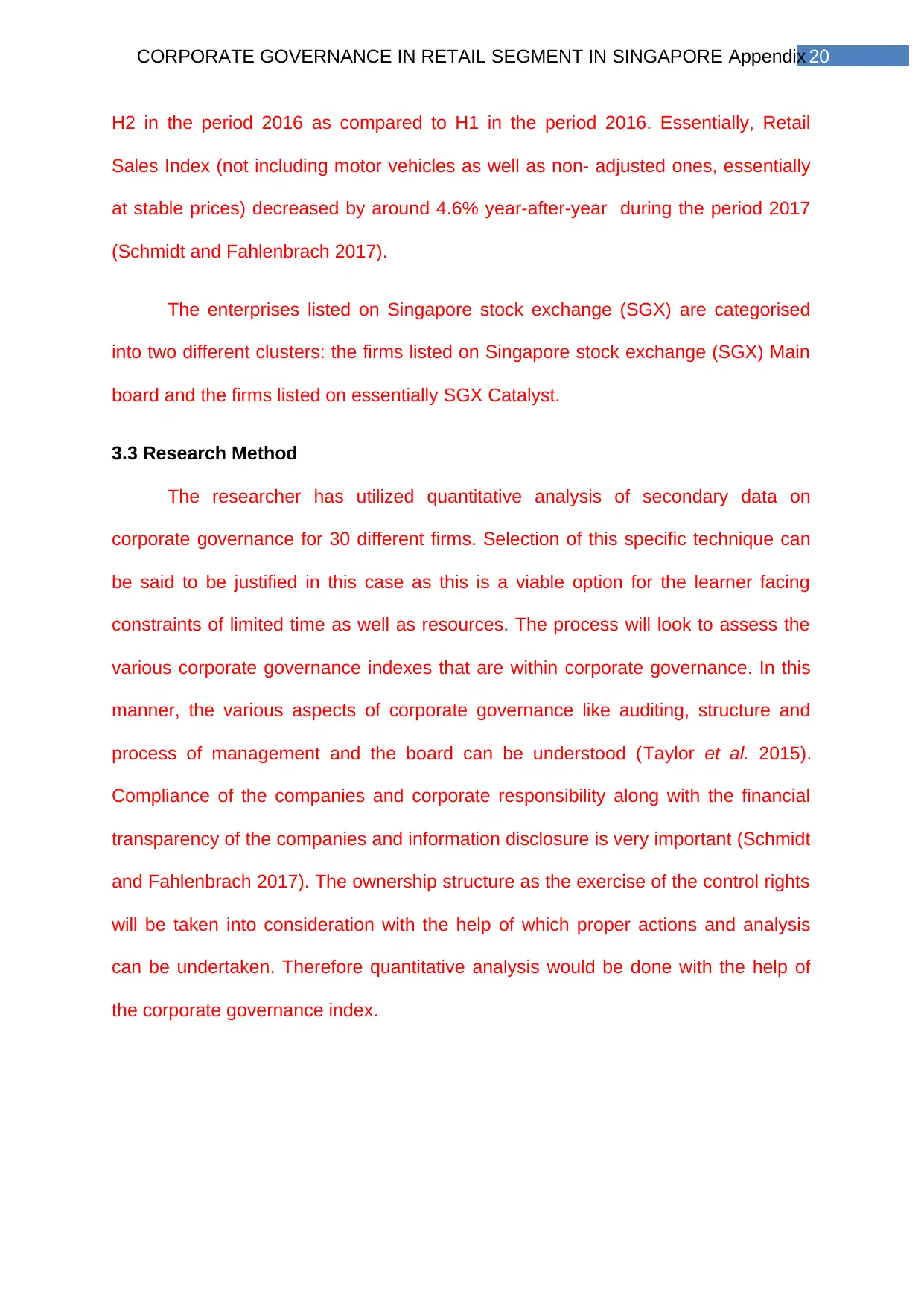
20CORPORATE GOVERNANCE IN RETAIL SEGMENT IN SINGAPORE Appendix
H2 in the period 2016 as compared to H1 in the period 2016. Essentially, Retail
Sales Index (not including motor vehicles as well as non- adjusted ones, essentially
at stable prices) decreased by around 4.6% year-after-year during the period 2017
(Schmidt and Fahlenbrach 2017).
The enterprises listed on Singapore stock exchange (SGX) are categorised
into two different clusters: the firms listed on Singapore stock exchange (SGX) Main
board and the firms listed on essentially SGX Catalyst.
3.3 Research Method
The researcher has utilized quantitative analysis of secondary data on
corporate governance for 30 different firms. Selection of this specific technique can
be said to be justified in this case as this is a viable option for the learner facing
constraints of limited time as well as resources. The process will look to assess the
various corporate governance indexes that are within corporate governance. In this
manner, the various aspects of corporate governance like auditing, structure and
process of management and the board can be understood (Taylor et al. 2015).
Compliance of the companies and corporate responsibility along with the financial
transparency of the companies and information disclosure is very important (Schmidt
and Fahlenbrach 2017). The ownership structure as the exercise of the control rights
will be taken into consideration with the help of which proper actions and analysis
can be undertaken. Therefore quantitative analysis would be done with the help of
the corporate governance index.
H2 in the period 2016 as compared to H1 in the period 2016. Essentially, Retail
Sales Index (not including motor vehicles as well as non- adjusted ones, essentially
at stable prices) decreased by around 4.6% year-after-year during the period 2017
(Schmidt and Fahlenbrach 2017).
The enterprises listed on Singapore stock exchange (SGX) are categorised
into two different clusters: the firms listed on Singapore stock exchange (SGX) Main
board and the firms listed on essentially SGX Catalyst.
3.3 Research Method
The researcher has utilized quantitative analysis of secondary data on
corporate governance for 30 different firms. Selection of this specific technique can
be said to be justified in this case as this is a viable option for the learner facing
constraints of limited time as well as resources. The process will look to assess the
various corporate governance indexes that are within corporate governance. In this
manner, the various aspects of corporate governance like auditing, structure and
process of management and the board can be understood (Taylor et al. 2015).
Compliance of the companies and corporate responsibility along with the financial
transparency of the companies and information disclosure is very important (Schmidt
and Fahlenbrach 2017). The ownership structure as the exercise of the control rights
will be taken into consideration with the help of which proper actions and analysis
can be undertaken. Therefore quantitative analysis would be done with the help of
the corporate governance index.
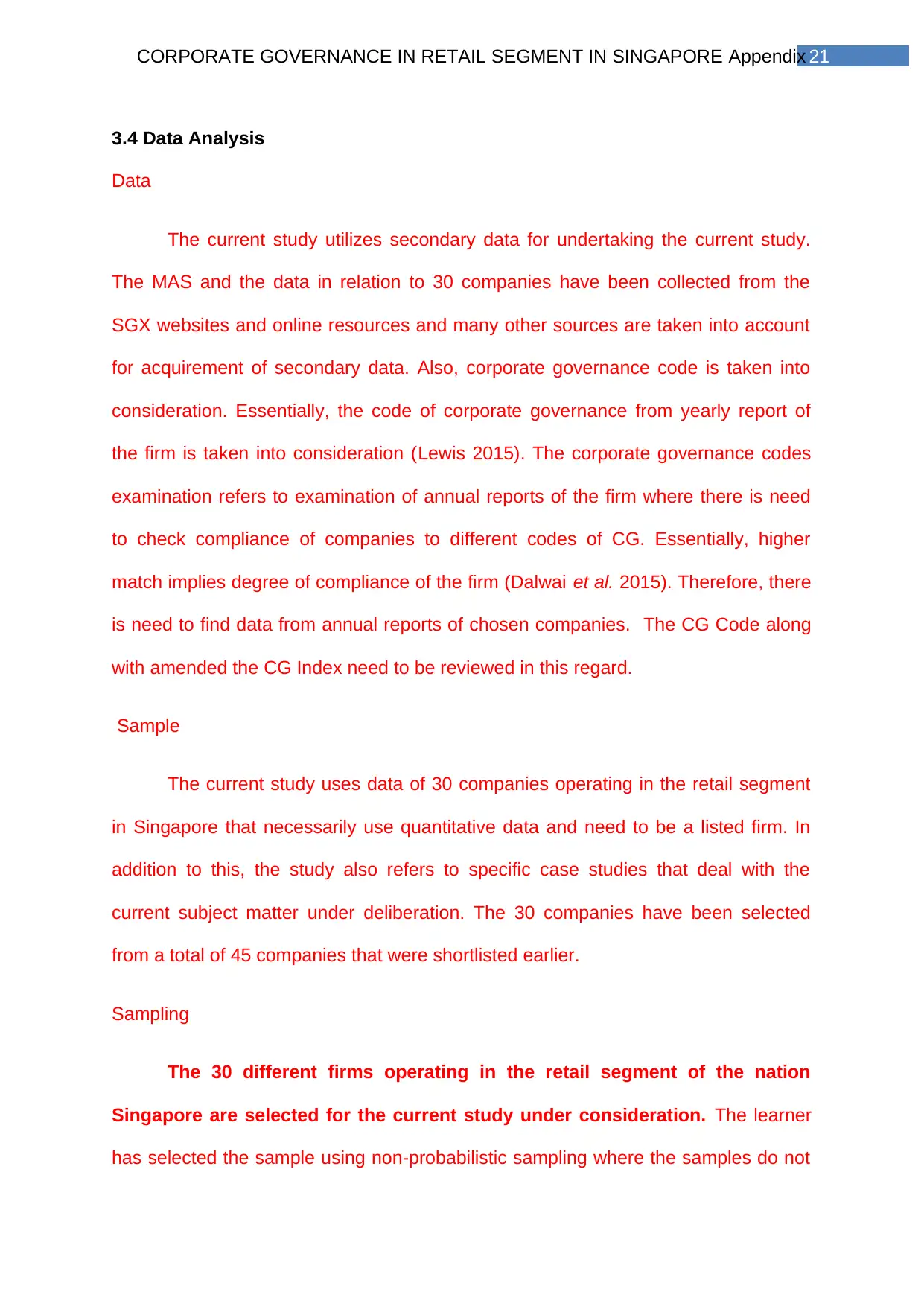
21CORPORATE GOVERNANCE IN RETAIL SEGMENT IN SINGAPORE Appendix
3.4 Data Analysis
Data
The current study utilizes secondary data for undertaking the current study.
The MAS and the data in relation to 30 companies have been collected from the
SGX websites and online resources and many other sources are taken into account
for acquirement of secondary data. Also, corporate governance code is taken into
consideration. Essentially, the code of corporate governance from yearly report of
the firm is taken into consideration (Lewis 2015). The corporate governance codes
examination refers to examination of annual reports of the firm where there is need
to check compliance of companies to different codes of CG. Essentially, higher
match implies degree of compliance of the firm (Dalwai et al. 2015). Therefore, there
is need to find data from annual reports of chosen companies. The CG Code along
with amended the CG Index need to be reviewed in this regard.
Sample
The current study uses data of 30 companies operating in the retail segment
in Singapore that necessarily use quantitative data and need to be a listed firm. In
addition to this, the study also refers to specific case studies that deal with the
current subject matter under deliberation. The 30 companies have been selected
from a total of 45 companies that were shortlisted earlier.
Sampling
The 30 different firms operating in the retail segment of the nation
Singapore are selected for the current study under consideration. The learner
has selected the sample using non-probabilistic sampling where the samples do not
3.4 Data Analysis
Data
The current study utilizes secondary data for undertaking the current study.
The MAS and the data in relation to 30 companies have been collected from the
SGX websites and online resources and many other sources are taken into account
for acquirement of secondary data. Also, corporate governance code is taken into
consideration. Essentially, the code of corporate governance from yearly report of
the firm is taken into consideration (Lewis 2015). The corporate governance codes
examination refers to examination of annual reports of the firm where there is need
to check compliance of companies to different codes of CG. Essentially, higher
match implies degree of compliance of the firm (Dalwai et al. 2015). Therefore, there
is need to find data from annual reports of chosen companies. The CG Code along
with amended the CG Index need to be reviewed in this regard.
Sample
The current study uses data of 30 companies operating in the retail segment
in Singapore that necessarily use quantitative data and need to be a listed firm. In
addition to this, the study also refers to specific case studies that deal with the
current subject matter under deliberation. The 30 companies have been selected
from a total of 45 companies that were shortlisted earlier.
Sampling
The 30 different firms operating in the retail segment of the nation
Singapore are selected for the current study under consideration. The learner
has selected the sample using non-probabilistic sampling where the samples do not
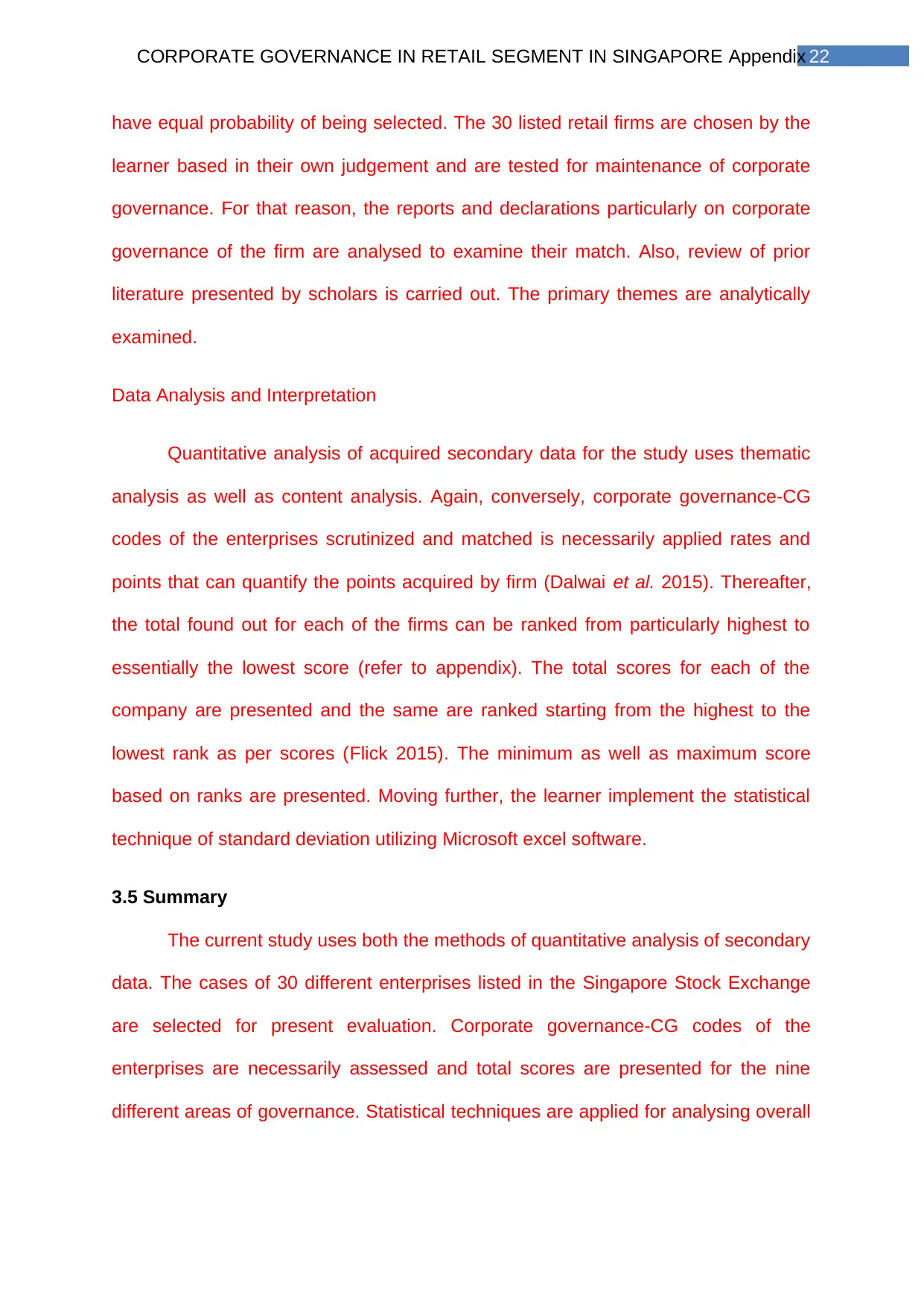
22CORPORATE GOVERNANCE IN RETAIL SEGMENT IN SINGAPORE Appendix
have equal probability of being selected. The 30 listed retail firms are chosen by the
learner based in their own judgement and are tested for maintenance of corporate
governance. For that reason, the reports and declarations particularly on corporate
governance of the firm are analysed to examine their match. Also, review of prior
literature presented by scholars is carried out. The primary themes are analytically
examined.
Data Analysis and Interpretation
Quantitative analysis of acquired secondary data for the study uses thematic
analysis as well as content analysis. Again, conversely, corporate governance-CG
codes of the enterprises scrutinized and matched is necessarily applied rates and
points that can quantify the points acquired by firm (Dalwai et al. 2015). Thereafter,
the total found out for each of the firms can be ranked from particularly highest to
essentially the lowest score (refer to appendix). The total scores for each of the
company are presented and the same are ranked starting from the highest to the
lowest rank as per scores (Flick 2015). The minimum as well as maximum score
based on ranks are presented. Moving further, the learner implement the statistical
technique of standard deviation utilizing Microsoft excel software.
3.5 Summary
The current study uses both the methods of quantitative analysis of secondary
data. The cases of 30 different enterprises listed in the Singapore Stock Exchange
are selected for present evaluation. Corporate governance-CG codes of the
enterprises are necessarily assessed and total scores are presented for the nine
different areas of governance. Statistical techniques are applied for analysing overall
have equal probability of being selected. The 30 listed retail firms are chosen by the
learner based in their own judgement and are tested for maintenance of corporate
governance. For that reason, the reports and declarations particularly on corporate
governance of the firm are analysed to examine their match. Also, review of prior
literature presented by scholars is carried out. The primary themes are analytically
examined.
Data Analysis and Interpretation
Quantitative analysis of acquired secondary data for the study uses thematic
analysis as well as content analysis. Again, conversely, corporate governance-CG
codes of the enterprises scrutinized and matched is necessarily applied rates and
points that can quantify the points acquired by firm (Dalwai et al. 2015). Thereafter,
the total found out for each of the firms can be ranked from particularly highest to
essentially the lowest score (refer to appendix). The total scores for each of the
company are presented and the same are ranked starting from the highest to the
lowest rank as per scores (Flick 2015). The minimum as well as maximum score
based on ranks are presented. Moving further, the learner implement the statistical
technique of standard deviation utilizing Microsoft excel software.
3.5 Summary
The current study uses both the methods of quantitative analysis of secondary
data. The cases of 30 different enterprises listed in the Singapore Stock Exchange
are selected for present evaluation. Corporate governance-CG codes of the
enterprises are necessarily assessed and total scores are presented for the nine
different areas of governance. Statistical techniques are applied for analysing overall
Secure Best Marks with AI Grader
Need help grading? Try our AI Grader for instant feedback on your assignments.
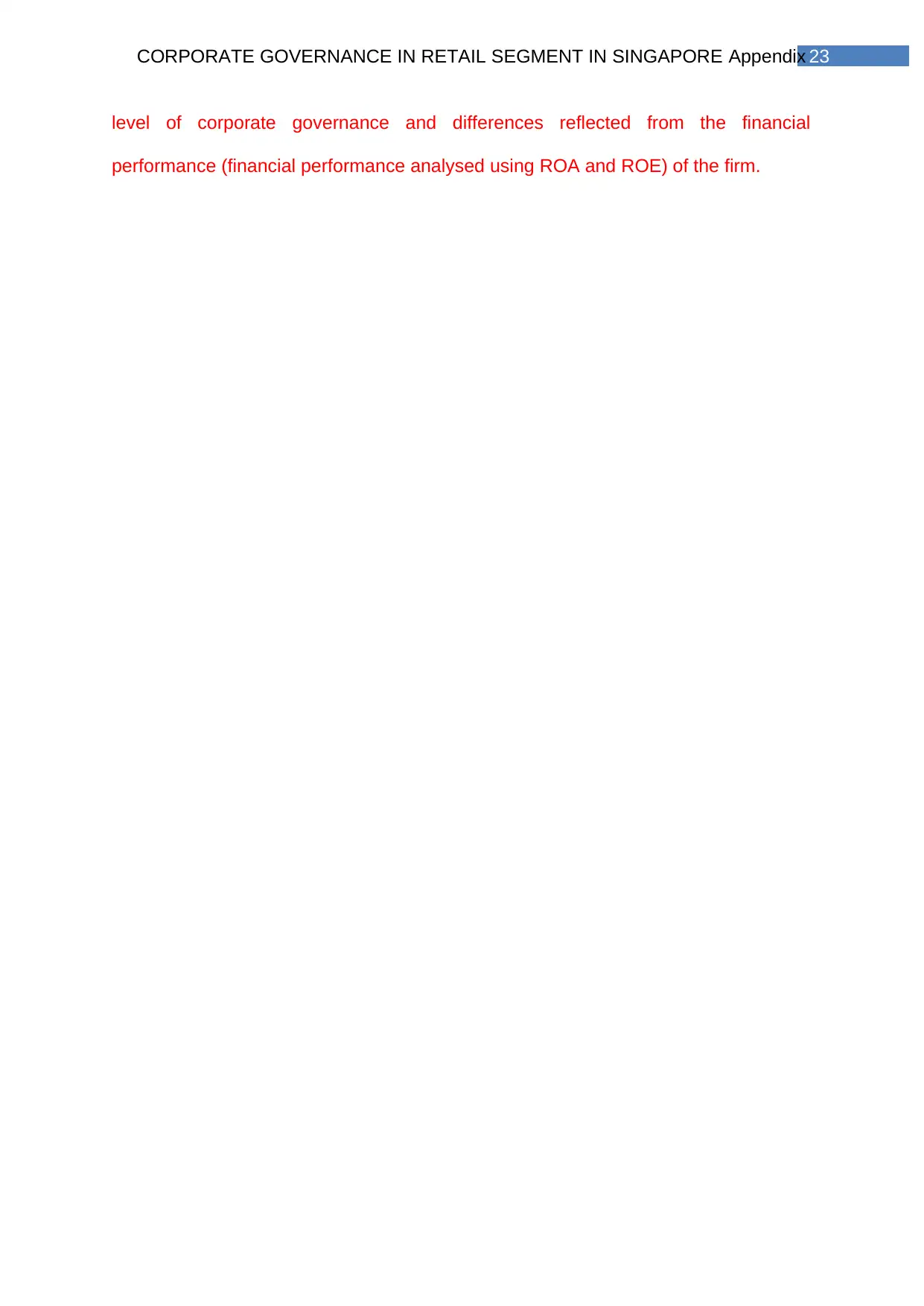
23CORPORATE GOVERNANCE IN RETAIL SEGMENT IN SINGAPORE Appendix
level of corporate governance and differences reflected from the financial
performance (financial performance analysed using ROA and ROE) of the firm.
level of corporate governance and differences reflected from the financial
performance (financial performance analysed using ROA and ROE) of the firm.
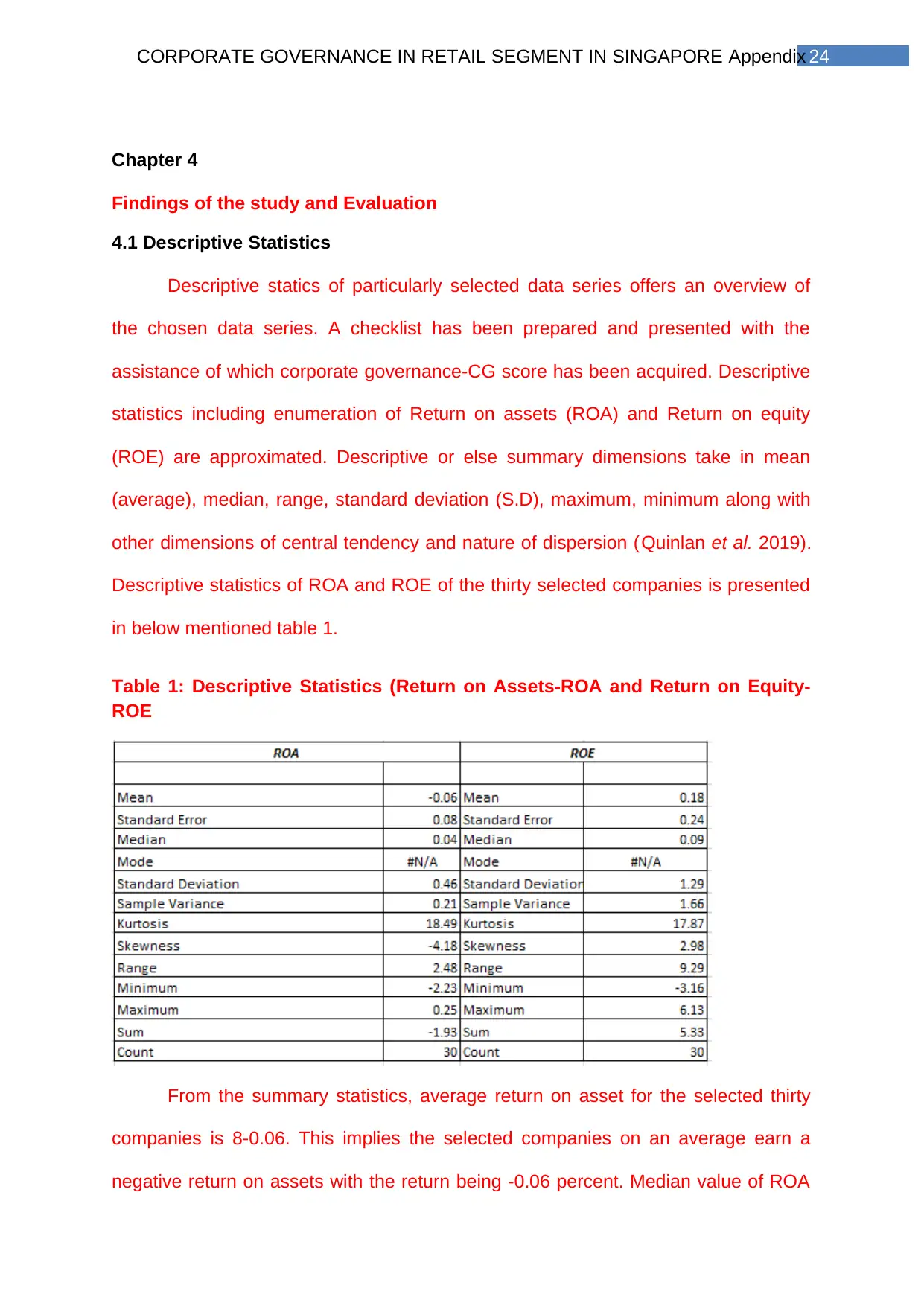
24CORPORATE GOVERNANCE IN RETAIL SEGMENT IN SINGAPORE Appendix
Chapter 4
Findings of the study and Evaluation
4.1 Descriptive Statistics
Descriptive statics of particularly selected data series offers an overview of
the chosen data series. A checklist has been prepared and presented with the
assistance of which corporate governance-CG score has been acquired. Descriptive
statistics including enumeration of Return on assets (ROA) and Return on equity
(ROE) are approximated. Descriptive or else summary dimensions take in mean
(average), median, range, standard deviation (S.D), maximum, minimum along with
other dimensions of central tendency and nature of dispersion (Quinlan et al. 2019).
Descriptive statistics of ROA and ROE of the thirty selected companies is presented
in below mentioned table 1.
Table 1: Descriptive Statistics (Return on Assets-ROA and Return on Equity-
ROE
From the summary statistics, average return on asset for the selected thirty
companies is 8-0.06. This implies the selected companies on an average earn a
negative return on assets with the return being -0.06 percent. Median value of ROA
Chapter 4
Findings of the study and Evaluation
4.1 Descriptive Statistics
Descriptive statics of particularly selected data series offers an overview of
the chosen data series. A checklist has been prepared and presented with the
assistance of which corporate governance-CG score has been acquired. Descriptive
statistics including enumeration of Return on assets (ROA) and Return on equity
(ROE) are approximated. Descriptive or else summary dimensions take in mean
(average), median, range, standard deviation (S.D), maximum, minimum along with
other dimensions of central tendency and nature of dispersion (Quinlan et al. 2019).
Descriptive statistics of ROA and ROE of the thirty selected companies is presented
in below mentioned table 1.
Table 1: Descriptive Statistics (Return on Assets-ROA and Return on Equity-
ROE
From the summary statistics, average return on asset for the selected thirty
companies is 8-0.06. This implies the selected companies on an average earn a
negative return on assets with the return being -0.06 percent. Median value of ROA
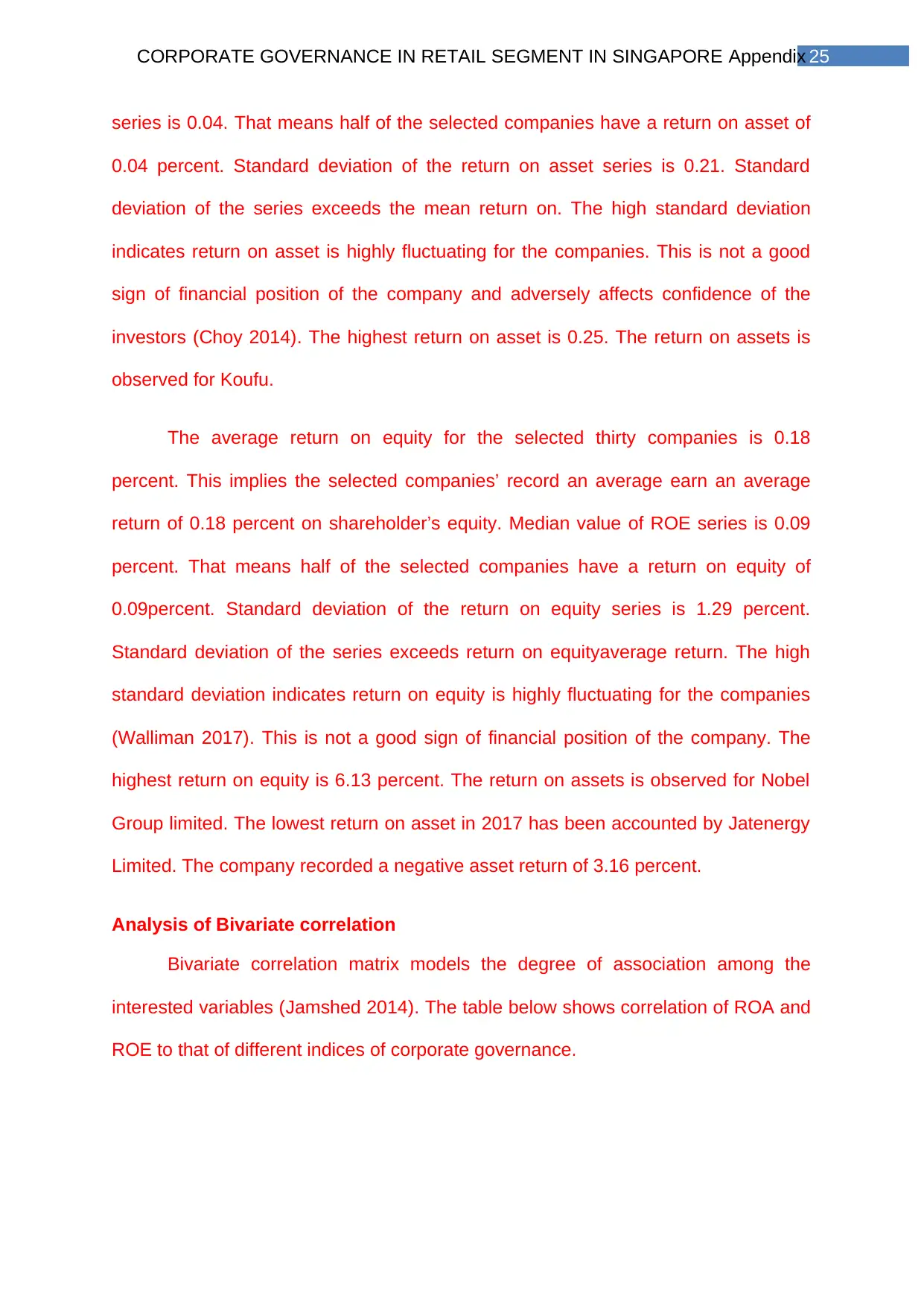
25CORPORATE GOVERNANCE IN RETAIL SEGMENT IN SINGAPORE Appendix
series is 0.04. That means half of the selected companies have a return on asset of
0.04 percent. Standard deviation of the return on asset series is 0.21. Standard
deviation of the series exceeds the mean return on. The high standard deviation
indicates return on asset is highly fluctuating for the companies. This is not a good
sign of financial position of the company and adversely affects confidence of the
investors (Choy 2014). The highest return on asset is 0.25. The return on assets is
observed for Koufu.
The average return on equity for the selected thirty companies is 0.18
percent. This implies the selected companies’ record an average earn an average
return of 0.18 percent on shareholder’s equity. Median value of ROE series is 0.09
percent. That means half of the selected companies have a return on equity of
0.09percent. Standard deviation of the return on equity series is 1.29 percent.
Standard deviation of the series exceeds return on equityaverage return. The high
standard deviation indicates return on equity is highly fluctuating for the companies
(Walliman 2017). This is not a good sign of financial position of the company. The
highest return on equity is 6.13 percent. The return on assets is observed for Nobel
Group limited. The lowest return on asset in 2017 has been accounted by Jatenergy
Limited. The company recorded a negative asset return of 3.16 percent.
Analysis of Bivariate correlation
Bivariate correlation matrix models the degree of association among the
interested variables (Jamshed 2014). The table below shows correlation of ROA and
ROE to that of different indices of corporate governance.
series is 0.04. That means half of the selected companies have a return on asset of
0.04 percent. Standard deviation of the return on asset series is 0.21. Standard
deviation of the series exceeds the mean return on. The high standard deviation
indicates return on asset is highly fluctuating for the companies. This is not a good
sign of financial position of the company and adversely affects confidence of the
investors (Choy 2014). The highest return on asset is 0.25. The return on assets is
observed for Koufu.
The average return on equity for the selected thirty companies is 0.18
percent. This implies the selected companies’ record an average earn an average
return of 0.18 percent on shareholder’s equity. Median value of ROE series is 0.09
percent. That means half of the selected companies have a return on equity of
0.09percent. Standard deviation of the return on equity series is 1.29 percent.
Standard deviation of the series exceeds return on equityaverage return. The high
standard deviation indicates return on equity is highly fluctuating for the companies
(Walliman 2017). This is not a good sign of financial position of the company. The
highest return on equity is 6.13 percent. The return on assets is observed for Nobel
Group limited. The lowest return on asset in 2017 has been accounted by Jatenergy
Limited. The company recorded a negative asset return of 3.16 percent.
Analysis of Bivariate correlation
Bivariate correlation matrix models the degree of association among the
interested variables (Jamshed 2014). The table below shows correlation of ROA and
ROE to that of different indices of corporate governance.
Paraphrase This Document
Need a fresh take? Get an instant paraphrase of this document with our AI Paraphraser
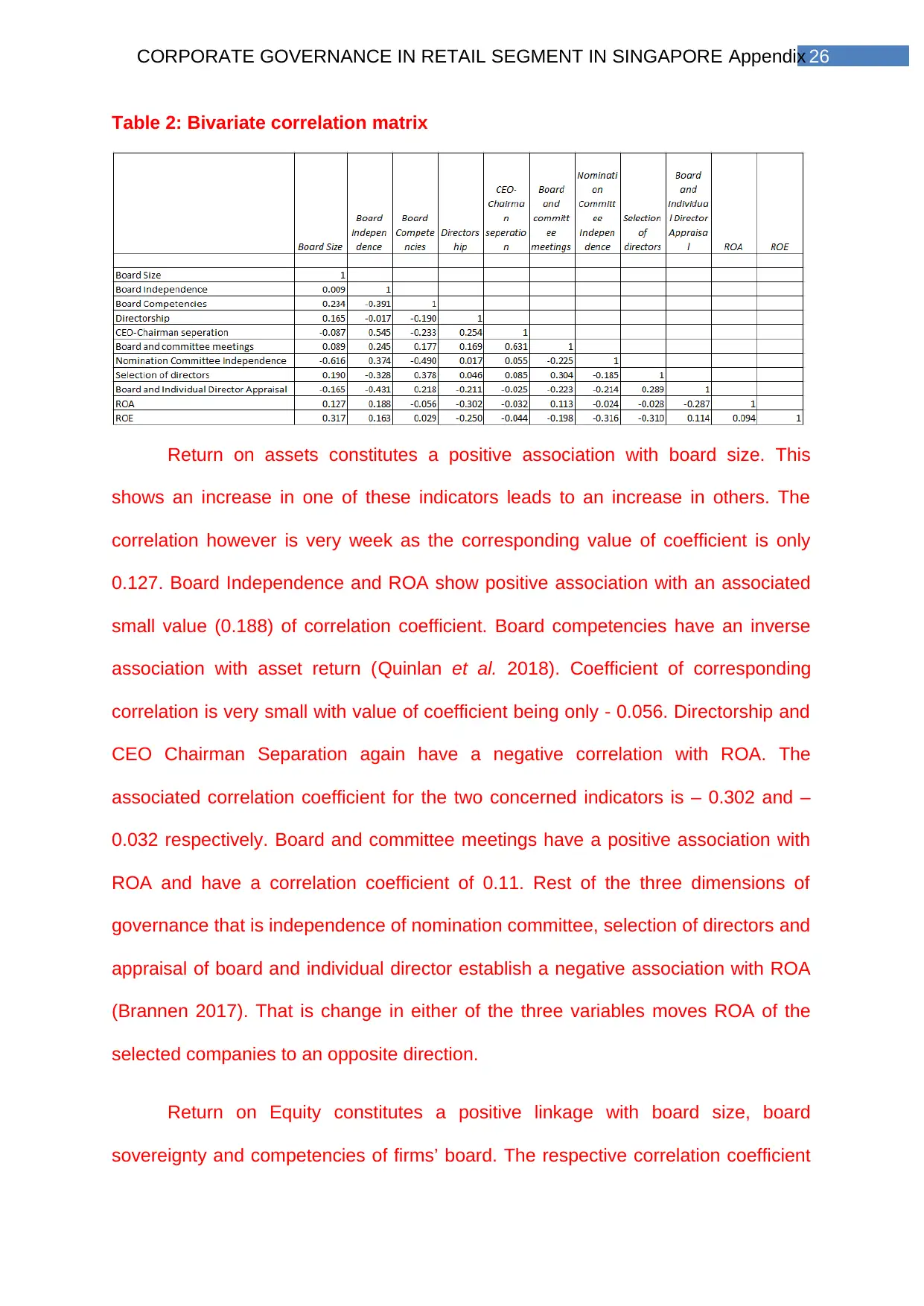
26CORPORATE GOVERNANCE IN RETAIL SEGMENT IN SINGAPORE Appendix
Table 2: Bivariate correlation matrix
Return on assets constitutes a positive association with board size. This
shows an increase in one of these indicators leads to an increase in others. The
correlation however is very week as the corresponding value of coefficient is only
0.127. Board Independence and ROA show positive association with an associated
small value (0.188) of correlation coefficient. Board competencies have an inverse
association with asset return (Quinlan et al. 2018). Coefficient of corresponding
correlation is very small with value of coefficient being only - 0.056. Directorship and
CEO Chairman Separation again have a negative correlation with ROA. The
associated correlation coefficient for the two concerned indicators is – 0.302 and –
0.032 respectively. Board and committee meetings have a positive association with
ROA and have a correlation coefficient of 0.11. Rest of the three dimensions of
governance that is independence of nomination committee, selection of directors and
appraisal of board and individual director establish a negative association with ROA
(Brannen 2017). That is change in either of the three variables moves ROA of the
selected companies to an opposite direction.
Return on Equity constitutes a positive linkage with board size, board
sovereignty and competencies of firms’ board. The respective correlation coefficient
Table 2: Bivariate correlation matrix
Return on assets constitutes a positive association with board size. This
shows an increase in one of these indicators leads to an increase in others. The
correlation however is very week as the corresponding value of coefficient is only
0.127. Board Independence and ROA show positive association with an associated
small value (0.188) of correlation coefficient. Board competencies have an inverse
association with asset return (Quinlan et al. 2018). Coefficient of corresponding
correlation is very small with value of coefficient being only - 0.056. Directorship and
CEO Chairman Separation again have a negative correlation with ROA. The
associated correlation coefficient for the two concerned indicators is – 0.302 and –
0.032 respectively. Board and committee meetings have a positive association with
ROA and have a correlation coefficient of 0.11. Rest of the three dimensions of
governance that is independence of nomination committee, selection of directors and
appraisal of board and individual director establish a negative association with ROA
(Brannen 2017). That is change in either of the three variables moves ROA of the
selected companies to an opposite direction.
Return on Equity constitutes a positive linkage with board size, board
sovereignty and competencies of firms’ board. The respective correlation coefficient
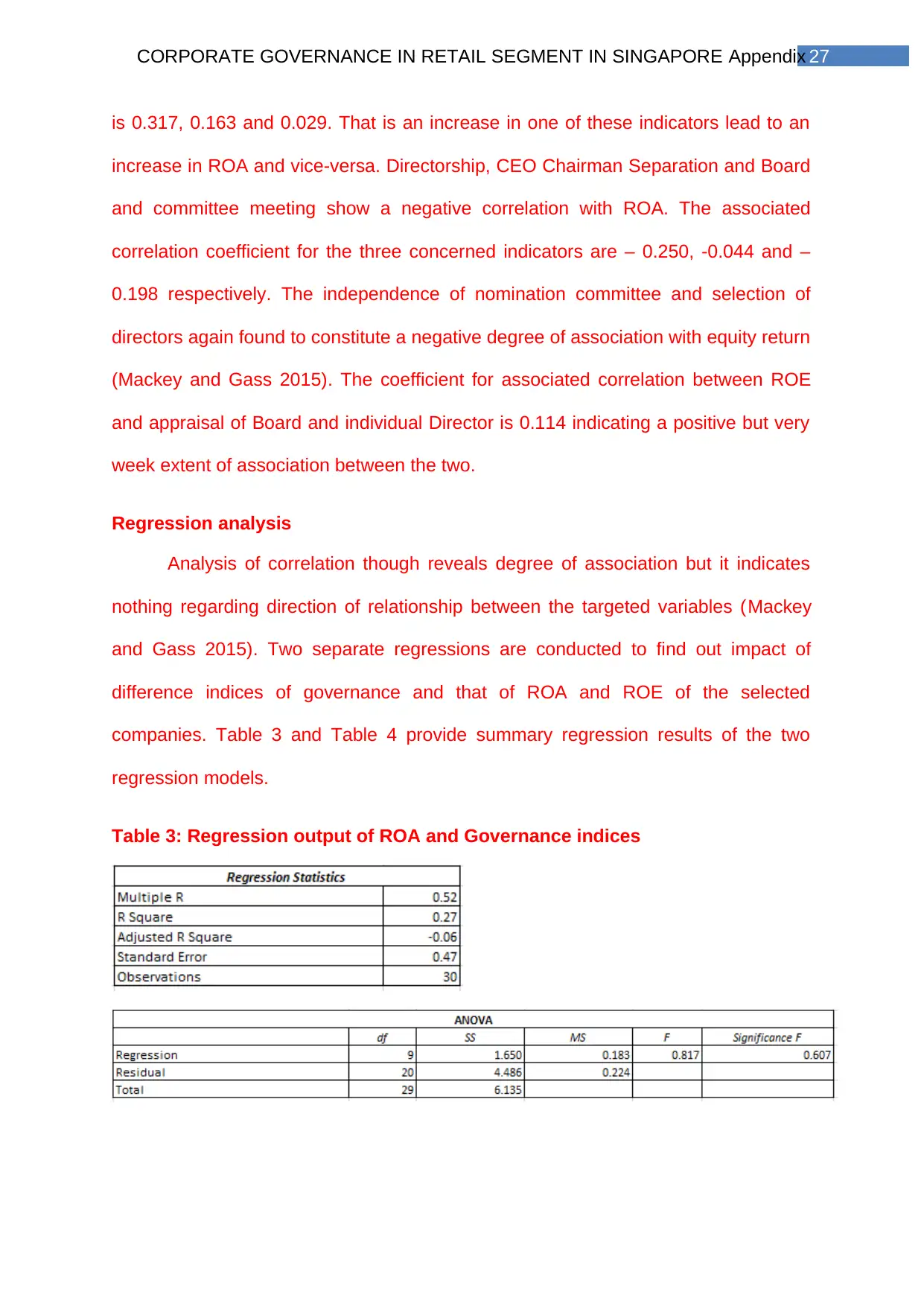
27CORPORATE GOVERNANCE IN RETAIL SEGMENT IN SINGAPORE Appendix
is 0.317, 0.163 and 0.029. That is an increase in one of these indicators lead to an
increase in ROA and vice-versa. Directorship, CEO Chairman Separation and Board
and committee meeting show a negative correlation with ROA. The associated
correlation coefficient for the three concerned indicators are – 0.250, -0.044 and –
0.198 respectively. The independence of nomination committee and selection of
directors again found to constitute a negative degree of association with equity return
(Mackey and Gass 2015). The coefficient for associated correlation between ROE
and appraisal of Board and individual Director is 0.114 indicating a positive but very
week extent of association between the two.
Regression analysis
Analysis of correlation though reveals degree of association but it indicates
nothing regarding direction of relationship between the targeted variables (Mackey
and Gass 2015). Two separate regressions are conducted to find out impact of
difference indices of governance and that of ROA and ROE of the selected
companies. Table 3 and Table 4 provide summary regression results of the two
regression models.
Table 3: Regression output of ROA and Governance indices
is 0.317, 0.163 and 0.029. That is an increase in one of these indicators lead to an
increase in ROA and vice-versa. Directorship, CEO Chairman Separation and Board
and committee meeting show a negative correlation with ROA. The associated
correlation coefficient for the three concerned indicators are – 0.250, -0.044 and –
0.198 respectively. The independence of nomination committee and selection of
directors again found to constitute a negative degree of association with equity return
(Mackey and Gass 2015). The coefficient for associated correlation between ROE
and appraisal of Board and individual Director is 0.114 indicating a positive but very
week extent of association between the two.
Regression analysis
Analysis of correlation though reveals degree of association but it indicates
nothing regarding direction of relationship between the targeted variables (Mackey
and Gass 2015). Two separate regressions are conducted to find out impact of
difference indices of governance and that of ROA and ROE of the selected
companies. Table 3 and Table 4 provide summary regression results of the two
regression models.
Table 3: Regression output of ROA and Governance indices
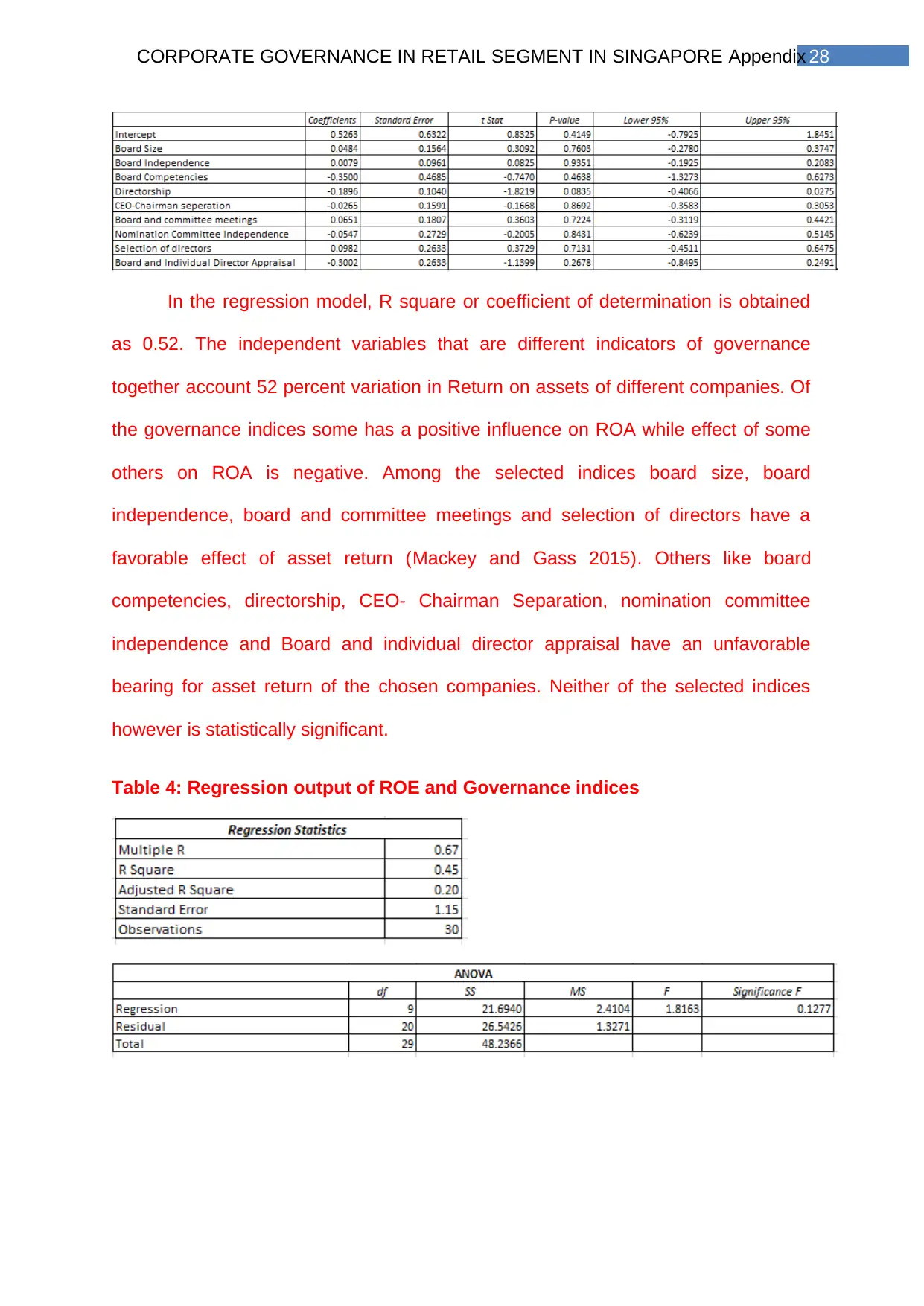
28CORPORATE GOVERNANCE IN RETAIL SEGMENT IN SINGAPORE Appendix
In the regression model, R square or coefficient of determination is obtained
as 0.52. The independent variables that are different indicators of governance
together account 52 percent variation in Return on assets of different companies. Of
the governance indices some has a positive influence on ROA while effect of some
others on ROA is negative. Among the selected indices board size, board
independence, board and committee meetings and selection of directors have a
favorable effect of asset return (Mackey and Gass 2015). Others like board
competencies, directorship, CEO- Chairman Separation, nomination committee
independence and Board and individual director appraisal have an unfavorable
bearing for asset return of the chosen companies. Neither of the selected indices
however is statistically significant.
Table 4: Regression output of ROE and Governance indices
In the regression model, R square or coefficient of determination is obtained
as 0.52. The independent variables that are different indicators of governance
together account 52 percent variation in Return on assets of different companies. Of
the governance indices some has a positive influence on ROA while effect of some
others on ROA is negative. Among the selected indices board size, board
independence, board and committee meetings and selection of directors have a
favorable effect of asset return (Mackey and Gass 2015). Others like board
competencies, directorship, CEO- Chairman Separation, nomination committee
independence and Board and individual director appraisal have an unfavorable
bearing for asset return of the chosen companies. Neither of the selected indices
however is statistically significant.
Table 4: Regression output of ROE and Governance indices
Secure Best Marks with AI Grader
Need help grading? Try our AI Grader for instant feedback on your assignments.
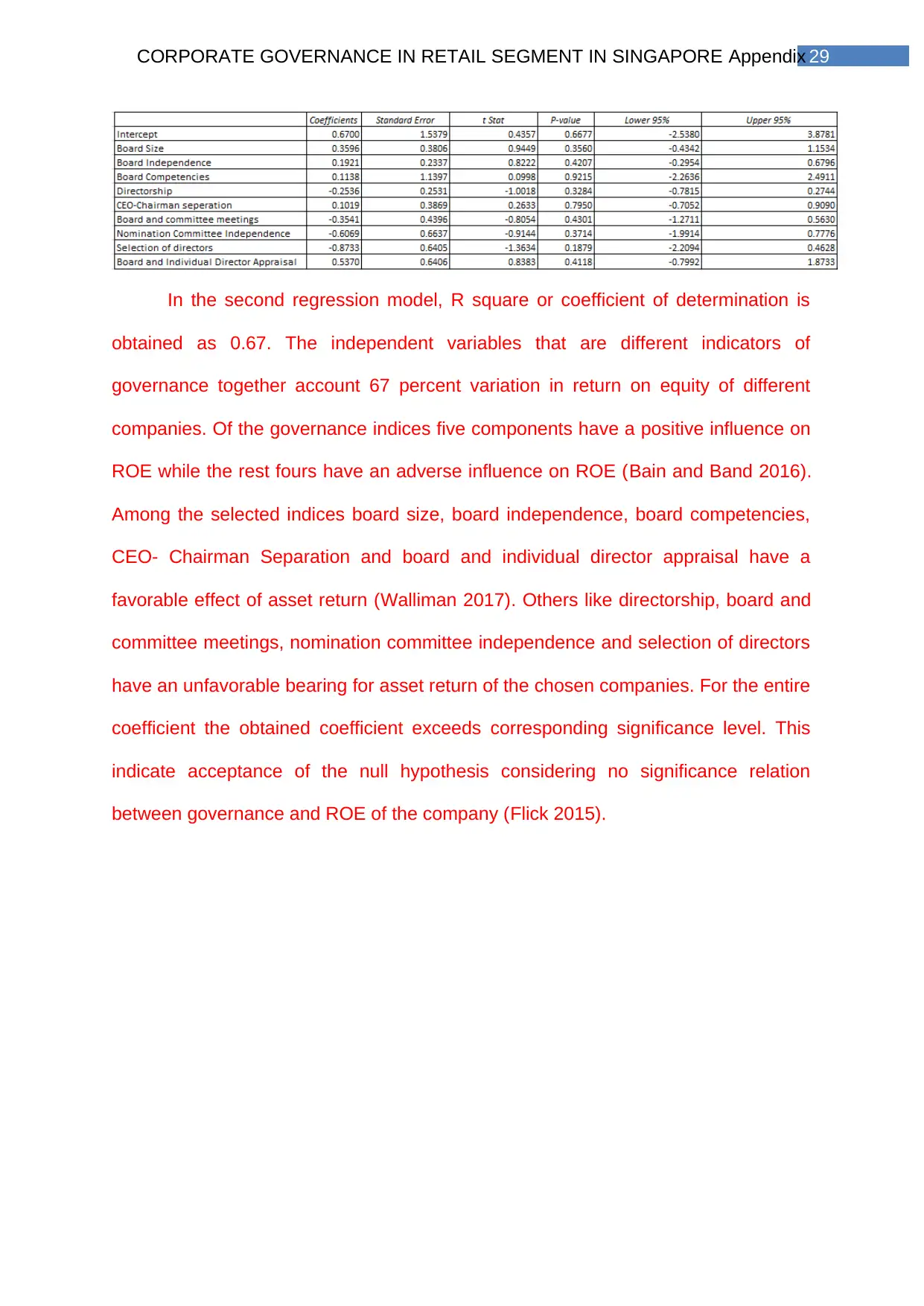
29CORPORATE GOVERNANCE IN RETAIL SEGMENT IN SINGAPORE Appendix
In the second regression model, R square or coefficient of determination is
obtained as 0.67. The independent variables that are different indicators of
governance together account 67 percent variation in return on equity of different
companies. Of the governance indices five components have a positive influence on
ROE while the rest fours have an adverse influence on ROE (Bain and Band 2016).
Among the selected indices board size, board independence, board competencies,
CEO- Chairman Separation and board and individual director appraisal have a
favorable effect of asset return (Walliman 2017). Others like directorship, board and
committee meetings, nomination committee independence and selection of directors
have an unfavorable bearing for asset return of the chosen companies. For the entire
coefficient the obtained coefficient exceeds corresponding significance level. This
indicate acceptance of the null hypothesis considering no significance relation
between governance and ROE of the company (Flick 2015).
In the second regression model, R square or coefficient of determination is
obtained as 0.67. The independent variables that are different indicators of
governance together account 67 percent variation in return on equity of different
companies. Of the governance indices five components have a positive influence on
ROE while the rest fours have an adverse influence on ROE (Bain and Band 2016).
Among the selected indices board size, board independence, board competencies,
CEO- Chairman Separation and board and individual director appraisal have a
favorable effect of asset return (Walliman 2017). Others like directorship, board and
committee meetings, nomination committee independence and selection of directors
have an unfavorable bearing for asset return of the chosen companies. For the entire
coefficient the obtained coefficient exceeds corresponding significance level. This
indicate acceptance of the null hypothesis considering no significance relation
between governance and ROE of the company (Flick 2015).
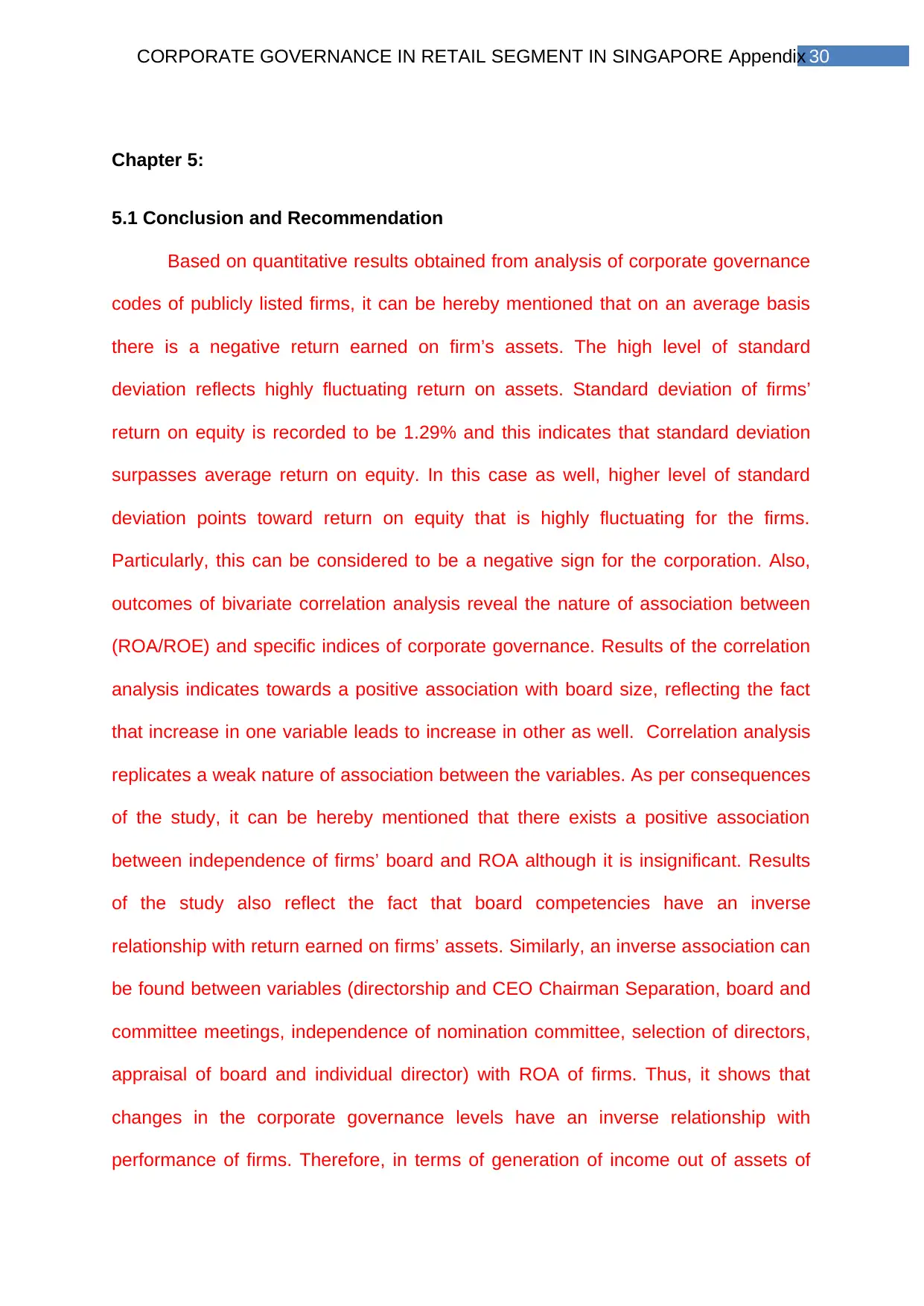
30CORPORATE GOVERNANCE IN RETAIL SEGMENT IN SINGAPORE Appendix
Chapter 5:
5.1 Conclusion and Recommendation
Based on quantitative results obtained from analysis of corporate governance
codes of publicly listed firms, it can be hereby mentioned that on an average basis
there is a negative return earned on firm’s assets. The high level of standard
deviation reflects highly fluctuating return on assets. Standard deviation of firms’
return on equity is recorded to be 1.29% and this indicates that standard deviation
surpasses average return on equity. In this case as well, higher level of standard
deviation points toward return on equity that is highly fluctuating for the firms.
Particularly, this can be considered to be a negative sign for the corporation. Also,
outcomes of bivariate correlation analysis reveal the nature of association between
(ROA/ROE) and specific indices of corporate governance. Results of the correlation
analysis indicates towards a positive association with board size, reflecting the fact
that increase in one variable leads to increase in other as well. Correlation analysis
replicates a weak nature of association between the variables. As per consequences
of the study, it can be hereby mentioned that there exists a positive association
between independence of firms’ board and ROA although it is insignificant. Results
of the study also reflect the fact that board competencies have an inverse
relationship with return earned on firms’ assets. Similarly, an inverse association can
be found between variables (directorship and CEO Chairman Separation, board and
committee meetings, independence of nomination committee, selection of directors,
appraisal of board and individual director) with ROA of firms. Thus, it shows that
changes in the corporate governance levels have an inverse relationship with
performance of firms. Therefore, in terms of generation of income out of assets of
Chapter 5:
5.1 Conclusion and Recommendation
Based on quantitative results obtained from analysis of corporate governance
codes of publicly listed firms, it can be hereby mentioned that on an average basis
there is a negative return earned on firm’s assets. The high level of standard
deviation reflects highly fluctuating return on assets. Standard deviation of firms’
return on equity is recorded to be 1.29% and this indicates that standard deviation
surpasses average return on equity. In this case as well, higher level of standard
deviation points toward return on equity that is highly fluctuating for the firms.
Particularly, this can be considered to be a negative sign for the corporation. Also,
outcomes of bivariate correlation analysis reveal the nature of association between
(ROA/ROE) and specific indices of corporate governance. Results of the correlation
analysis indicates towards a positive association with board size, reflecting the fact
that increase in one variable leads to increase in other as well. Correlation analysis
replicates a weak nature of association between the variables. As per consequences
of the study, it can be hereby mentioned that there exists a positive association
between independence of firms’ board and ROA although it is insignificant. Results
of the study also reflect the fact that board competencies have an inverse
relationship with return earned on firms’ assets. Similarly, an inverse association can
be found between variables (directorship and CEO Chairman Separation, board and
committee meetings, independence of nomination committee, selection of directors,
appraisal of board and individual director) with ROA of firms. Thus, it shows that
changes in the corporate governance levels have an inverse relationship with
performance of firms. Therefore, in terms of generation of income out of assets of
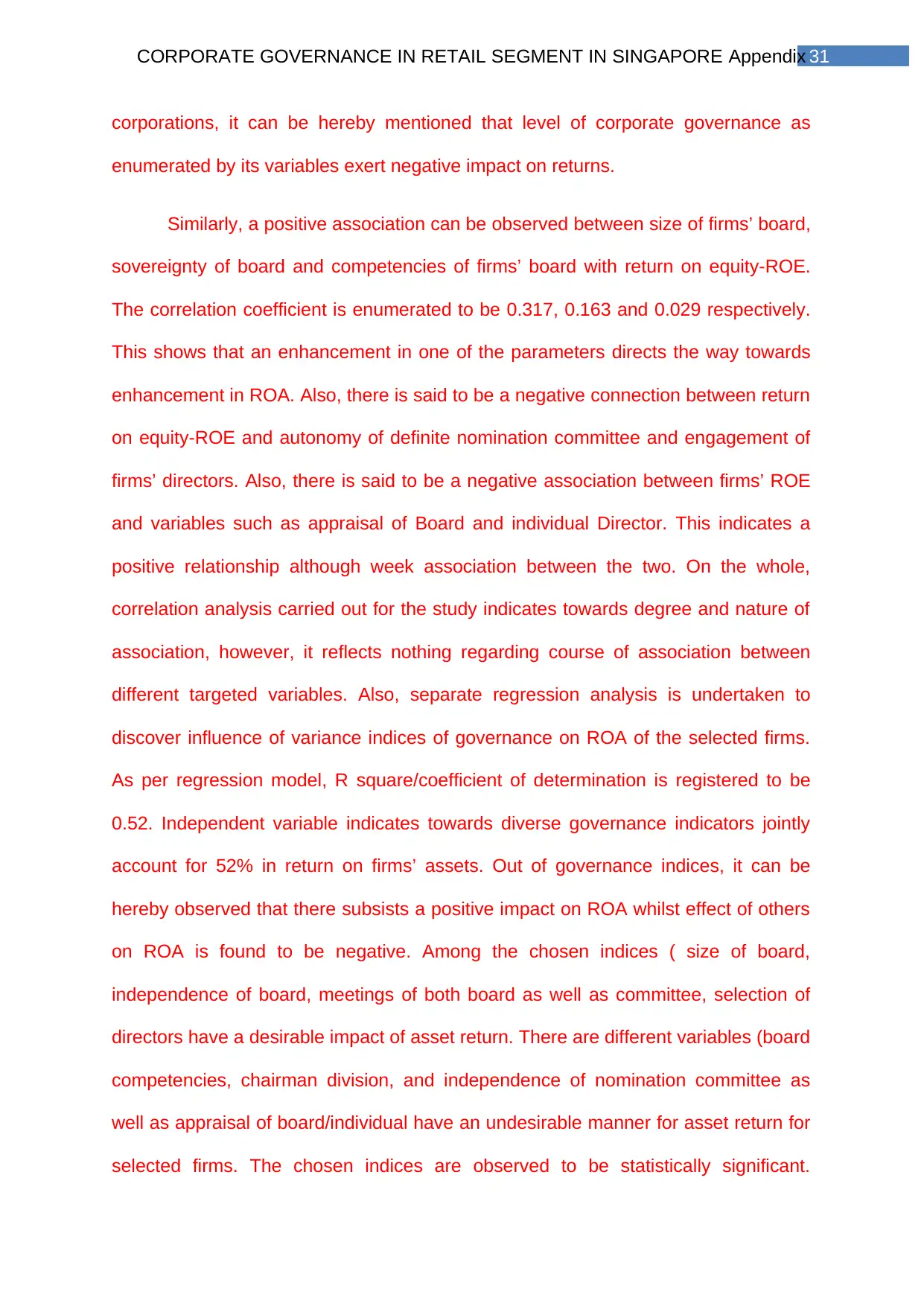
31CORPORATE GOVERNANCE IN RETAIL SEGMENT IN SINGAPORE Appendix
corporations, it can be hereby mentioned that level of corporate governance as
enumerated by its variables exert negative impact on returns.
Similarly, a positive association can be observed between size of firms’ board,
sovereignty of board and competencies of firms’ board with return on equity-ROE.
The correlation coefficient is enumerated to be 0.317, 0.163 and 0.029 respectively.
This shows that an enhancement in one of the parameters directs the way towards
enhancement in ROA. Also, there is said to be a negative connection between return
on equity-ROE and autonomy of definite nomination committee and engagement of
firms’ directors. Also, there is said to be a negative association between firms’ ROE
and variables such as appraisal of Board and individual Director. This indicates a
positive relationship although week association between the two. On the whole,
correlation analysis carried out for the study indicates towards degree and nature of
association, however, it reflects nothing regarding course of association between
different targeted variables. Also, separate regression analysis is undertaken to
discover influence of variance indices of governance on ROA of the selected firms.
As per regression model, R square/coefficient of determination is registered to be
0.52. Independent variable indicates towards diverse governance indicators jointly
account for 52% in return on firms’ assets. Out of governance indices, it can be
hereby observed that there subsists a positive impact on ROA whilst effect of others
on ROA is found to be negative. Among the chosen indices ( size of board,
independence of board, meetings of both board as well as committee, selection of
directors have a desirable impact of asset return. There are different variables (board
competencies, chairman division, and independence of nomination committee as
well as appraisal of board/individual have an undesirable manner for asset return for
selected firms. The chosen indices are observed to be statistically significant.
corporations, it can be hereby mentioned that level of corporate governance as
enumerated by its variables exert negative impact on returns.
Similarly, a positive association can be observed between size of firms’ board,
sovereignty of board and competencies of firms’ board with return on equity-ROE.
The correlation coefficient is enumerated to be 0.317, 0.163 and 0.029 respectively.
This shows that an enhancement in one of the parameters directs the way towards
enhancement in ROA. Also, there is said to be a negative connection between return
on equity-ROE and autonomy of definite nomination committee and engagement of
firms’ directors. Also, there is said to be a negative association between firms’ ROE
and variables such as appraisal of Board and individual Director. This indicates a
positive relationship although week association between the two. On the whole,
correlation analysis carried out for the study indicates towards degree and nature of
association, however, it reflects nothing regarding course of association between
different targeted variables. Also, separate regression analysis is undertaken to
discover influence of variance indices of governance on ROA of the selected firms.
As per regression model, R square/coefficient of determination is registered to be
0.52. Independent variable indicates towards diverse governance indicators jointly
account for 52% in return on firms’ assets. Out of governance indices, it can be
hereby observed that there subsists a positive impact on ROA whilst effect of others
on ROA is found to be negative. Among the chosen indices ( size of board,
independence of board, meetings of both board as well as committee, selection of
directors have a desirable impact of asset return. There are different variables (board
competencies, chairman division, and independence of nomination committee as
well as appraisal of board/individual have an undesirable manner for asset return for
selected firms. The chosen indices are observed to be statistically significant.
Paraphrase This Document
Need a fresh take? Get an instant paraphrase of this document with our AI Paraphraser
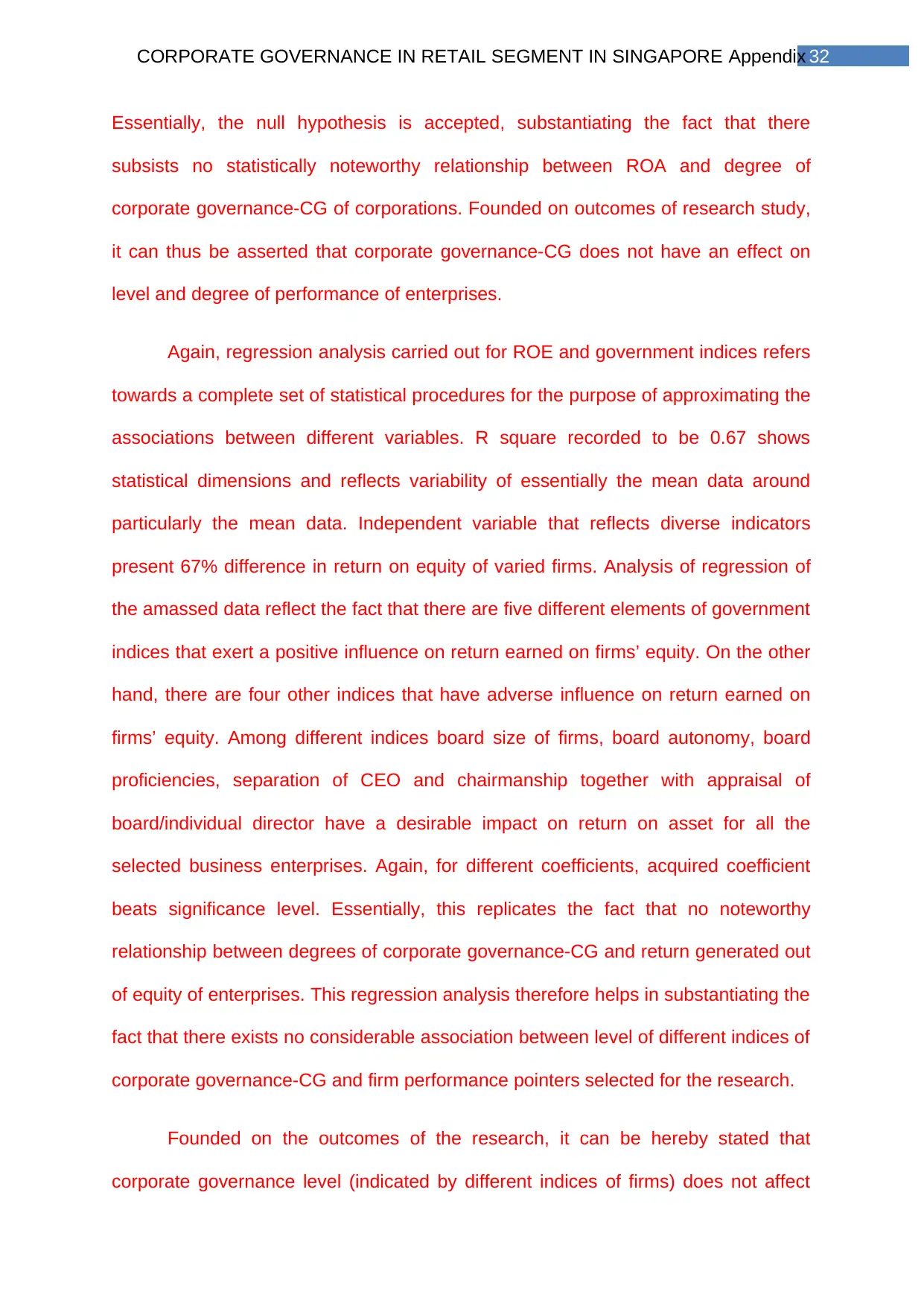
32CORPORATE GOVERNANCE IN RETAIL SEGMENT IN SINGAPORE Appendix
Essentially, the null hypothesis is accepted, substantiating the fact that there
subsists no statistically noteworthy relationship between ROA and degree of
corporate governance-CG of corporations. Founded on outcomes of research study,
it can thus be asserted that corporate governance-CG does not have an effect on
level and degree of performance of enterprises.
Again, regression analysis carried out for ROE and government indices refers
towards a complete set of statistical procedures for the purpose of approximating the
associations between different variables. R square recorded to be 0.67 shows
statistical dimensions and reflects variability of essentially the mean data around
particularly the mean data. Independent variable that reflects diverse indicators
present 67% difference in return on equity of varied firms. Analysis of regression of
the amassed data reflect the fact that there are five different elements of government
indices that exert a positive influence on return earned on firms’ equity. On the other
hand, there are four other indices that have adverse influence on return earned on
firms’ equity. Among different indices board size of firms, board autonomy, board
proficiencies, separation of CEO and chairmanship together with appraisal of
board/individual director have a desirable impact on return on asset for all the
selected business enterprises. Again, for different coefficients, acquired coefficient
beats significance level. Essentially, this replicates the fact that no noteworthy
relationship between degrees of corporate governance-CG and return generated out
of equity of enterprises. This regression analysis therefore helps in substantiating the
fact that there exists no considerable association between level of different indices of
corporate governance-CG and firm performance pointers selected for the research.
Founded on the outcomes of the research, it can be hereby stated that
corporate governance level (indicated by different indices of firms) does not affect
Essentially, the null hypothesis is accepted, substantiating the fact that there
subsists no statistically noteworthy relationship between ROA and degree of
corporate governance-CG of corporations. Founded on outcomes of research study,
it can thus be asserted that corporate governance-CG does not have an effect on
level and degree of performance of enterprises.
Again, regression analysis carried out for ROE and government indices refers
towards a complete set of statistical procedures for the purpose of approximating the
associations between different variables. R square recorded to be 0.67 shows
statistical dimensions and reflects variability of essentially the mean data around
particularly the mean data. Independent variable that reflects diverse indicators
present 67% difference in return on equity of varied firms. Analysis of regression of
the amassed data reflect the fact that there are five different elements of government
indices that exert a positive influence on return earned on firms’ equity. On the other
hand, there are four other indices that have adverse influence on return earned on
firms’ equity. Among different indices board size of firms, board autonomy, board
proficiencies, separation of CEO and chairmanship together with appraisal of
board/individual director have a desirable impact on return on asset for all the
selected business enterprises. Again, for different coefficients, acquired coefficient
beats significance level. Essentially, this replicates the fact that no noteworthy
relationship between degrees of corporate governance-CG and return generated out
of equity of enterprises. This regression analysis therefore helps in substantiating the
fact that there exists no considerable association between level of different indices of
corporate governance-CG and firm performance pointers selected for the research.
Founded on the outcomes of the research, it can be hereby stated that
corporate governance level (indicated by different indices of firms) does not affect
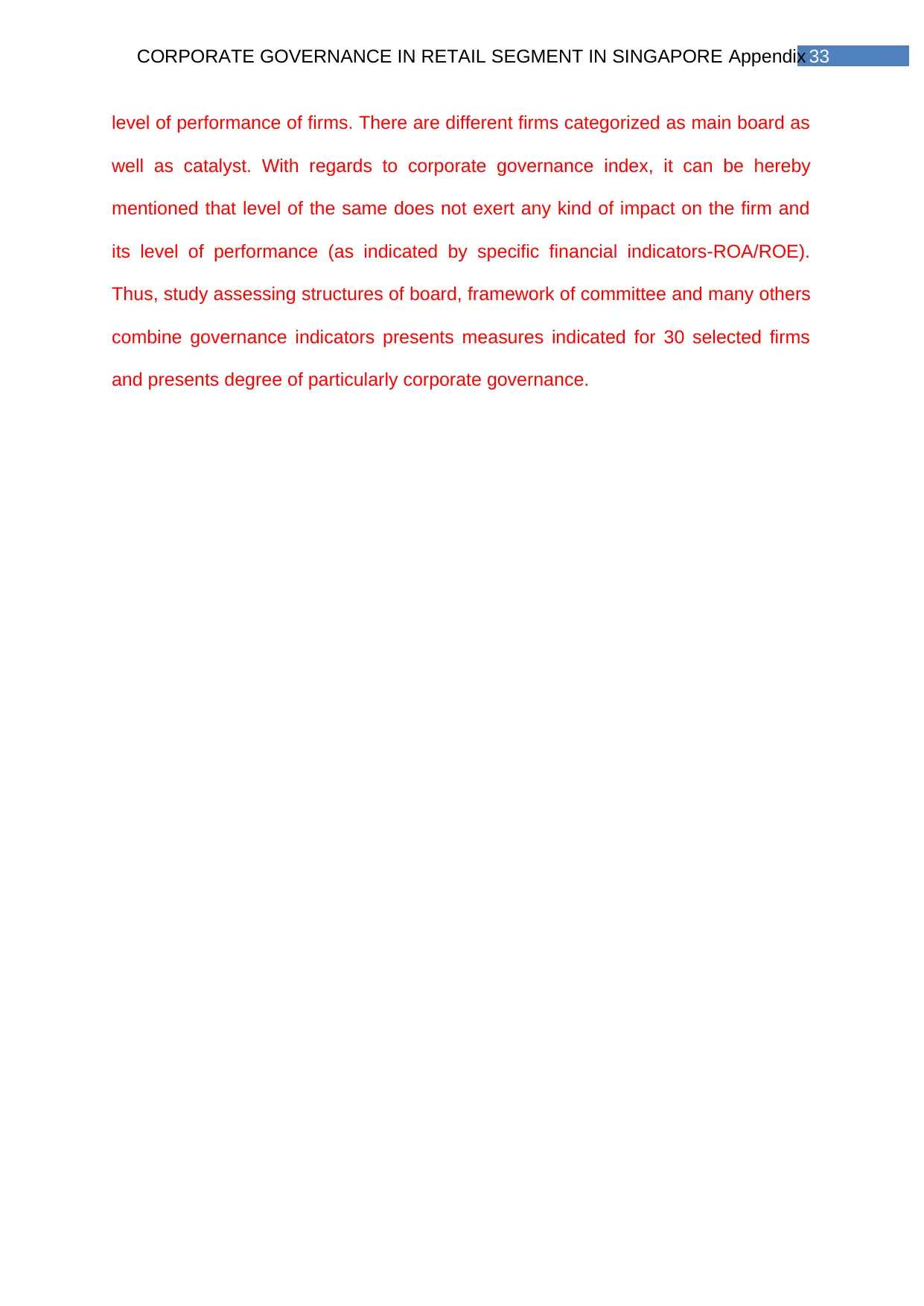
33CORPORATE GOVERNANCE IN RETAIL SEGMENT IN SINGAPORE Appendix
level of performance of firms. There are different firms categorized as main board as
well as catalyst. With regards to corporate governance index, it can be hereby
mentioned that level of the same does not exert any kind of impact on the firm and
its level of performance (as indicated by specific financial indicators-ROA/ROE).
Thus, study assessing structures of board, framework of committee and many others
combine governance indicators presents measures indicated for 30 selected firms
and presents degree of particularly corporate governance.
level of performance of firms. There are different firms categorized as main board as
well as catalyst. With regards to corporate governance index, it can be hereby
mentioned that level of the same does not exert any kind of impact on the firm and
its level of performance (as indicated by specific financial indicators-ROA/ROE).
Thus, study assessing structures of board, framework of committee and many others
combine governance indicators presents measures indicated for 30 selected firms
and presents degree of particularly corporate governance.
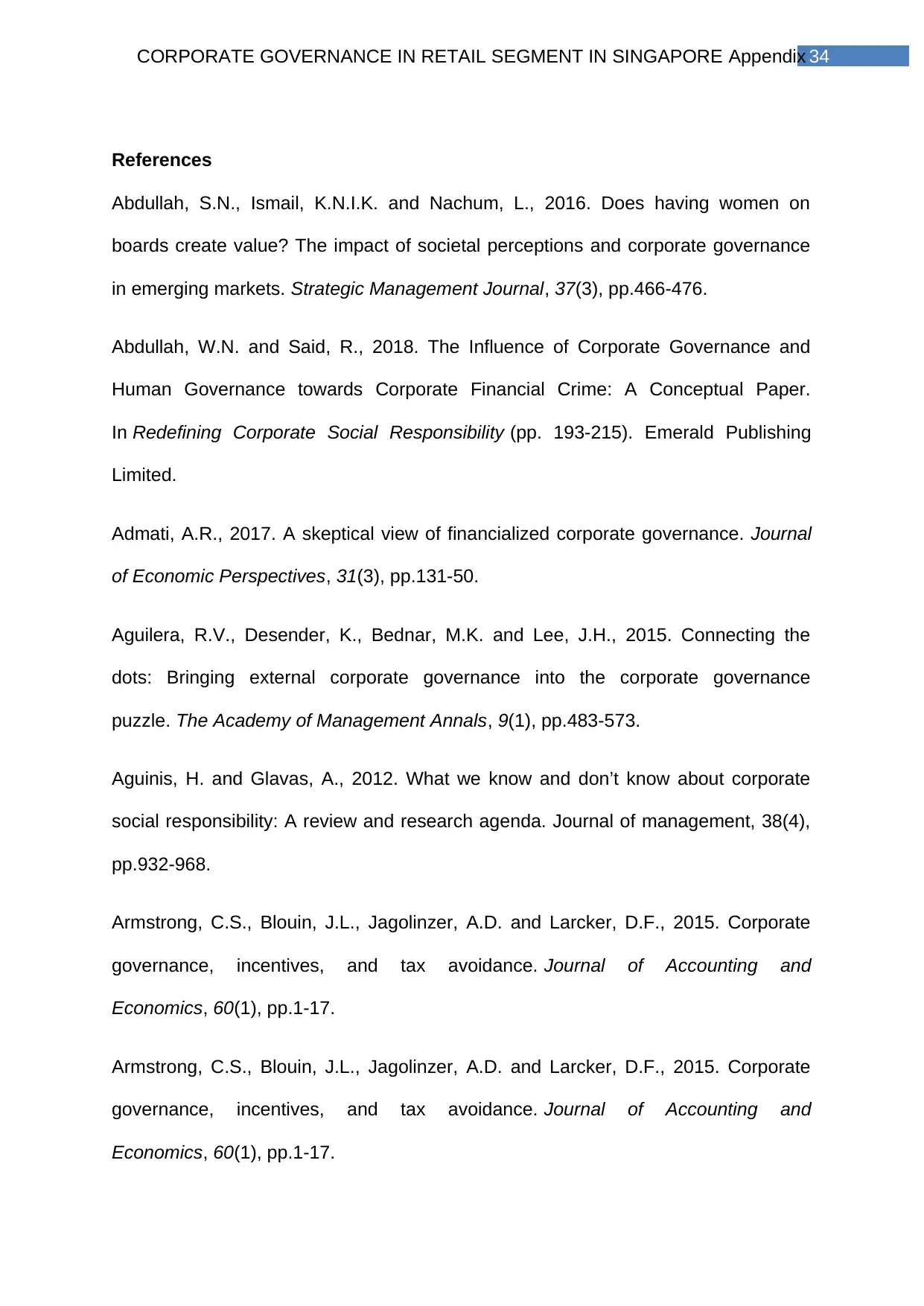
34CORPORATE GOVERNANCE IN RETAIL SEGMENT IN SINGAPORE Appendix
References
Abdullah, S.N., Ismail, K.N.I.K. and Nachum, L., 2016. Does having women on
boards create value? The impact of societal perceptions and corporate governance
in emerging markets. Strategic Management Journal, 37(3), pp.466-476.
Abdullah, W.N. and Said, R., 2018. The Influence of Corporate Governance and
Human Governance towards Corporate Financial Crime: A Conceptual Paper.
In Redefining Corporate Social Responsibility (pp. 193-215). Emerald Publishing
Limited.
Admati, A.R., 2017. A skeptical view of financialized corporate governance. Journal
of Economic Perspectives, 31(3), pp.131-50.
Aguilera, R.V., Desender, K., Bednar, M.K. and Lee, J.H., 2015. Connecting the
dots: Bringing external corporate governance into the corporate governance
puzzle. The Academy of Management Annals, 9(1), pp.483-573.
Aguinis, H. and Glavas, A., 2012. What we know and don’t know about corporate
social responsibility: A review and research agenda. Journal of management, 38(4),
pp.932-968.
Armstrong, C.S., Blouin, J.L., Jagolinzer, A.D. and Larcker, D.F., 2015. Corporate
governance, incentives, and tax avoidance. Journal of Accounting and
Economics, 60(1), pp.1-17.
Armstrong, C.S., Blouin, J.L., Jagolinzer, A.D. and Larcker, D.F., 2015. Corporate
governance, incentives, and tax avoidance. Journal of Accounting and
Economics, 60(1), pp.1-17.
References
Abdullah, S.N., Ismail, K.N.I.K. and Nachum, L., 2016. Does having women on
boards create value? The impact of societal perceptions and corporate governance
in emerging markets. Strategic Management Journal, 37(3), pp.466-476.
Abdullah, W.N. and Said, R., 2018. The Influence of Corporate Governance and
Human Governance towards Corporate Financial Crime: A Conceptual Paper.
In Redefining Corporate Social Responsibility (pp. 193-215). Emerald Publishing
Limited.
Admati, A.R., 2017. A skeptical view of financialized corporate governance. Journal
of Economic Perspectives, 31(3), pp.131-50.
Aguilera, R.V., Desender, K., Bednar, M.K. and Lee, J.H., 2015. Connecting the
dots: Bringing external corporate governance into the corporate governance
puzzle. The Academy of Management Annals, 9(1), pp.483-573.
Aguinis, H. and Glavas, A., 2012. What we know and don’t know about corporate
social responsibility: A review and research agenda. Journal of management, 38(4),
pp.932-968.
Armstrong, C.S., Blouin, J.L., Jagolinzer, A.D. and Larcker, D.F., 2015. Corporate
governance, incentives, and tax avoidance. Journal of Accounting and
Economics, 60(1), pp.1-17.
Armstrong, C.S., Blouin, J.L., Jagolinzer, A.D. and Larcker, D.F., 2015. Corporate
governance, incentives, and tax avoidance. Journal of Accounting and
Economics, 60(1), pp.1-17.
Secure Best Marks with AI Grader
Need help grading? Try our AI Grader for instant feedback on your assignments.
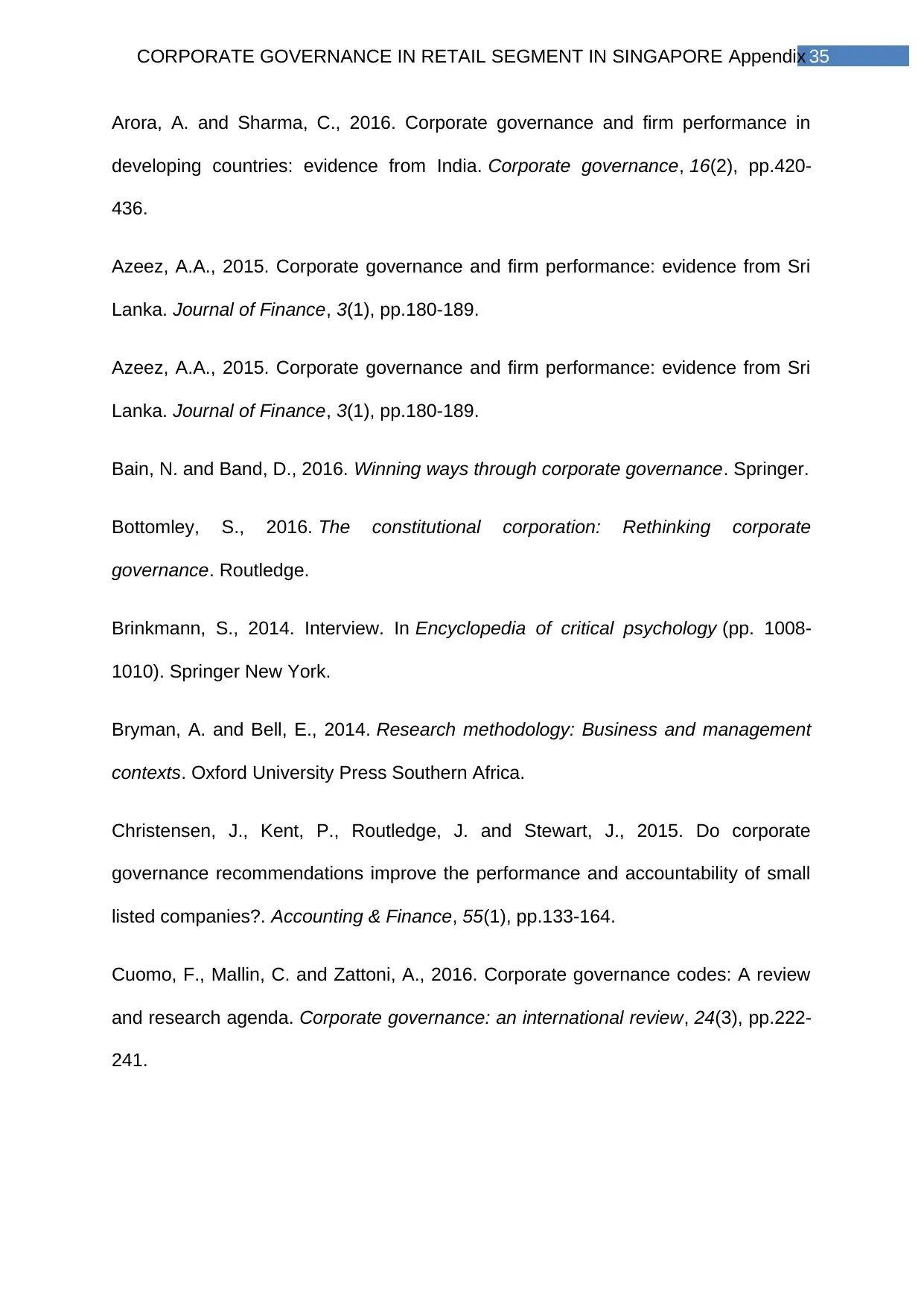
35CORPORATE GOVERNANCE IN RETAIL SEGMENT IN SINGAPORE Appendix
Arora, A. and Sharma, C., 2016. Corporate governance and firm performance in
developing countries: evidence from India. Corporate governance, 16(2), pp.420-
436.
Azeez, A.A., 2015. Corporate governance and firm performance: evidence from Sri
Lanka. Journal of Finance, 3(1), pp.180-189.
Azeez, A.A., 2015. Corporate governance and firm performance: evidence from Sri
Lanka. Journal of Finance, 3(1), pp.180-189.
Bain, N. and Band, D., 2016. Winning ways through corporate governance. Springer.
Bottomley, S., 2016. The constitutional corporation: Rethinking corporate
governance. Routledge.
Brinkmann, S., 2014. Interview. In Encyclopedia of critical psychology (pp. 1008-
1010). Springer New York.
Bryman, A. and Bell, E., 2014. Research methodology: Business and management
contexts. Oxford University Press Southern Africa.
Christensen, J., Kent, P., Routledge, J. and Stewart, J., 2015. Do corporate
governance recommendations improve the performance and accountability of small
listed companies?. Accounting & Finance, 55(1), pp.133-164.
Cuomo, F., Mallin, C. and Zattoni, A., 2016. Corporate governance codes: A review
and research agenda. Corporate governance: an international review, 24(3), pp.222-
241.
Arora, A. and Sharma, C., 2016. Corporate governance and firm performance in
developing countries: evidence from India. Corporate governance, 16(2), pp.420-
436.
Azeez, A.A., 2015. Corporate governance and firm performance: evidence from Sri
Lanka. Journal of Finance, 3(1), pp.180-189.
Azeez, A.A., 2015. Corporate governance and firm performance: evidence from Sri
Lanka. Journal of Finance, 3(1), pp.180-189.
Bain, N. and Band, D., 2016. Winning ways through corporate governance. Springer.
Bottomley, S., 2016. The constitutional corporation: Rethinking corporate
governance. Routledge.
Brinkmann, S., 2014. Interview. In Encyclopedia of critical psychology (pp. 1008-
1010). Springer New York.
Bryman, A. and Bell, E., 2014. Research methodology: Business and management
contexts. Oxford University Press Southern Africa.
Christensen, J., Kent, P., Routledge, J. and Stewart, J., 2015. Do corporate
governance recommendations improve the performance and accountability of small
listed companies?. Accounting & Finance, 55(1), pp.133-164.
Cuomo, F., Mallin, C. and Zattoni, A., 2016. Corporate governance codes: A review
and research agenda. Corporate governance: an international review, 24(3), pp.222-
241.
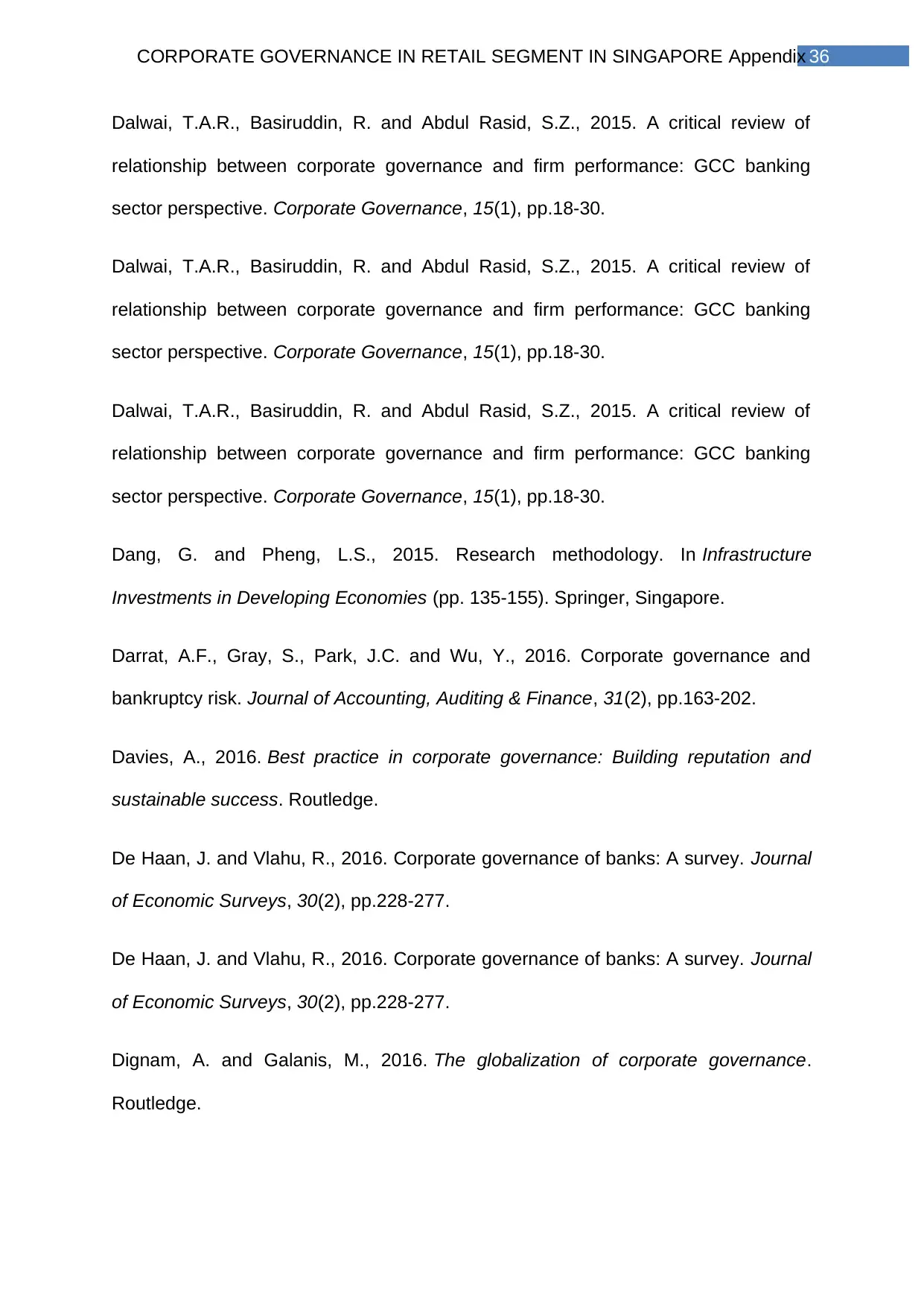
36CORPORATE GOVERNANCE IN RETAIL SEGMENT IN SINGAPORE Appendix
Dalwai, T.A.R., Basiruddin, R. and Abdul Rasid, S.Z., 2015. A critical review of
relationship between corporate governance and firm performance: GCC banking
sector perspective. Corporate Governance, 15(1), pp.18-30.
Dalwai, T.A.R., Basiruddin, R. and Abdul Rasid, S.Z., 2015. A critical review of
relationship between corporate governance and firm performance: GCC banking
sector perspective. Corporate Governance, 15(1), pp.18-30.
Dalwai, T.A.R., Basiruddin, R. and Abdul Rasid, S.Z., 2015. A critical review of
relationship between corporate governance and firm performance: GCC banking
sector perspective. Corporate Governance, 15(1), pp.18-30.
Dang, G. and Pheng, L.S., 2015. Research methodology. In Infrastructure
Investments in Developing Economies (pp. 135-155). Springer, Singapore.
Darrat, A.F., Gray, S., Park, J.C. and Wu, Y., 2016. Corporate governance and
bankruptcy risk. Journal of Accounting, Auditing & Finance, 31(2), pp.163-202.
Davies, A., 2016. Best practice in corporate governance: Building reputation and
sustainable success. Routledge.
De Haan, J. and Vlahu, R., 2016. Corporate governance of banks: A survey. Journal
of Economic Surveys, 30(2), pp.228-277.
De Haan, J. and Vlahu, R., 2016. Corporate governance of banks: A survey. Journal
of Economic Surveys, 30(2), pp.228-277.
Dignam, A. and Galanis, M., 2016. The globalization of corporate governance.
Routledge.
Dalwai, T.A.R., Basiruddin, R. and Abdul Rasid, S.Z., 2015. A critical review of
relationship between corporate governance and firm performance: GCC banking
sector perspective. Corporate Governance, 15(1), pp.18-30.
Dalwai, T.A.R., Basiruddin, R. and Abdul Rasid, S.Z., 2015. A critical review of
relationship between corporate governance and firm performance: GCC banking
sector perspective. Corporate Governance, 15(1), pp.18-30.
Dalwai, T.A.R., Basiruddin, R. and Abdul Rasid, S.Z., 2015. A critical review of
relationship between corporate governance and firm performance: GCC banking
sector perspective. Corporate Governance, 15(1), pp.18-30.
Dang, G. and Pheng, L.S., 2015. Research methodology. In Infrastructure
Investments in Developing Economies (pp. 135-155). Springer, Singapore.
Darrat, A.F., Gray, S., Park, J.C. and Wu, Y., 2016. Corporate governance and
bankruptcy risk. Journal of Accounting, Auditing & Finance, 31(2), pp.163-202.
Davies, A., 2016. Best practice in corporate governance: Building reputation and
sustainable success. Routledge.
De Haan, J. and Vlahu, R., 2016. Corporate governance of banks: A survey. Journal
of Economic Surveys, 30(2), pp.228-277.
De Haan, J. and Vlahu, R., 2016. Corporate governance of banks: A survey. Journal
of Economic Surveys, 30(2), pp.228-277.
Dignam, A. and Galanis, M., 2016. The globalization of corporate governance.
Routledge.
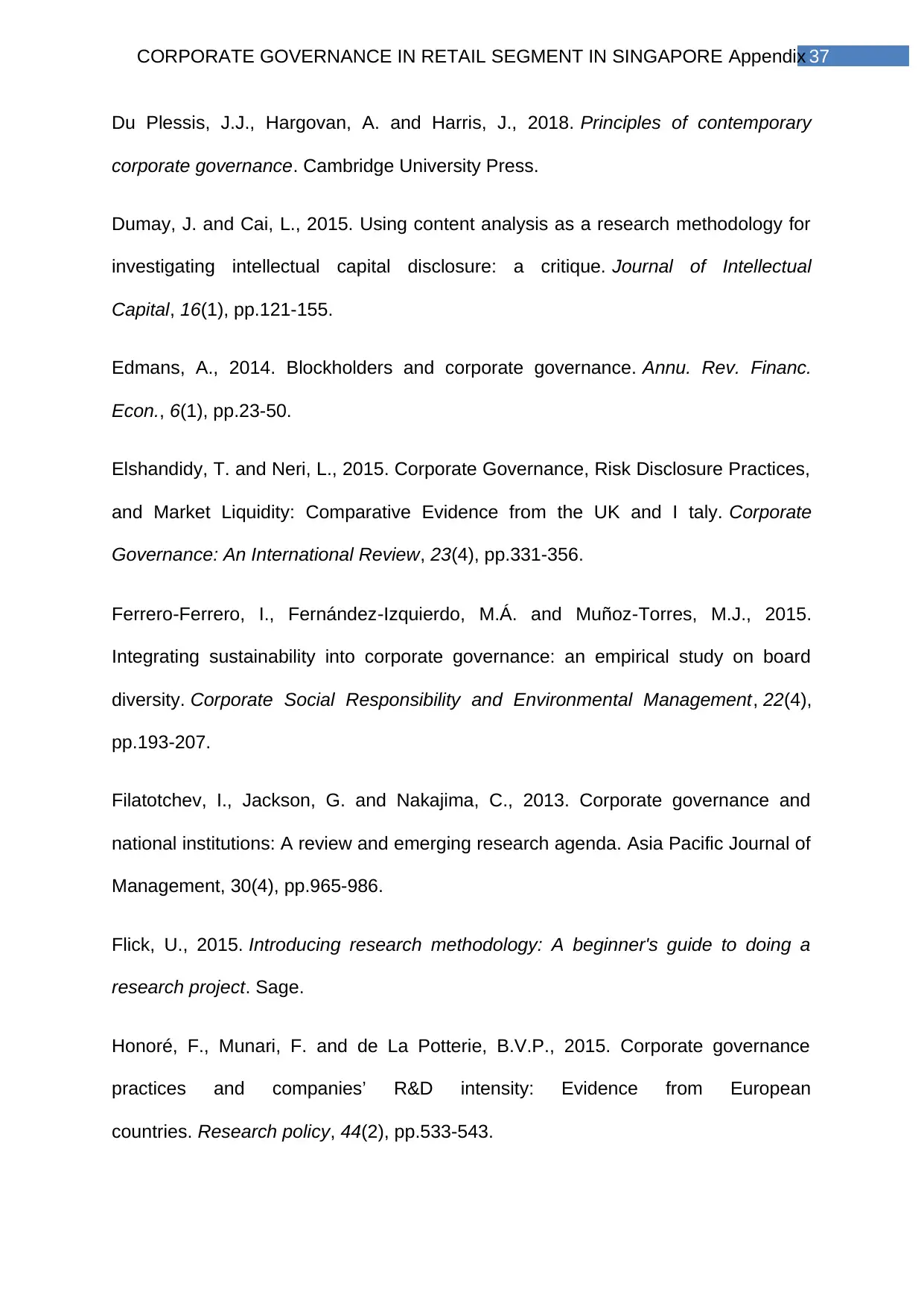
37CORPORATE GOVERNANCE IN RETAIL SEGMENT IN SINGAPORE Appendix
Du Plessis, J.J., Hargovan, A. and Harris, J., 2018. Principles of contemporary
corporate governance. Cambridge University Press.
Dumay, J. and Cai, L., 2015. Using content analysis as a research methodology for
investigating intellectual capital disclosure: a critique. Journal of Intellectual
Capital, 16(1), pp.121-155.
Edmans, A., 2014. Blockholders and corporate governance. Annu. Rev. Financ.
Econ., 6(1), pp.23-50.
Elshandidy, T. and Neri, L., 2015. Corporate Governance, Risk Disclosure Practices,
and Market Liquidity: Comparative Evidence from the UK and I taly. Corporate
Governance: An International Review, 23(4), pp.331-356.
Ferrero‐Ferrero, I., Fernández‐Izquierdo, M.Á. and Muñoz‐Torres, M.J., 2015.
Integrating sustainability into corporate governance: an empirical study on board
diversity. Corporate Social Responsibility and Environmental Management, 22(4),
pp.193-207.
Filatotchev, I., Jackson, G. and Nakajima, C., 2013. Corporate governance and
national institutions: A review and emerging research agenda. Asia Pacific Journal of
Management, 30(4), pp.965-986.
Flick, U., 2015. Introducing research methodology: A beginner's guide to doing a
research project. Sage.
Honoré, F., Munari, F. and de La Potterie, B.V.P., 2015. Corporate governance
practices and companies’ R&D intensity: Evidence from European
countries. Research policy, 44(2), pp.533-543.
Du Plessis, J.J., Hargovan, A. and Harris, J., 2018. Principles of contemporary
corporate governance. Cambridge University Press.
Dumay, J. and Cai, L., 2015. Using content analysis as a research methodology for
investigating intellectual capital disclosure: a critique. Journal of Intellectual
Capital, 16(1), pp.121-155.
Edmans, A., 2014. Blockholders and corporate governance. Annu. Rev. Financ.
Econ., 6(1), pp.23-50.
Elshandidy, T. and Neri, L., 2015. Corporate Governance, Risk Disclosure Practices,
and Market Liquidity: Comparative Evidence from the UK and I taly. Corporate
Governance: An International Review, 23(4), pp.331-356.
Ferrero‐Ferrero, I., Fernández‐Izquierdo, M.Á. and Muñoz‐Torres, M.J., 2015.
Integrating sustainability into corporate governance: an empirical study on board
diversity. Corporate Social Responsibility and Environmental Management, 22(4),
pp.193-207.
Filatotchev, I., Jackson, G. and Nakajima, C., 2013. Corporate governance and
national institutions: A review and emerging research agenda. Asia Pacific Journal of
Management, 30(4), pp.965-986.
Flick, U., 2015. Introducing research methodology: A beginner's guide to doing a
research project. Sage.
Honoré, F., Munari, F. and de La Potterie, B.V.P., 2015. Corporate governance
practices and companies’ R&D intensity: Evidence from European
countries. Research policy, 44(2), pp.533-543.
Paraphrase This Document
Need a fresh take? Get an instant paraphrase of this document with our AI Paraphraser
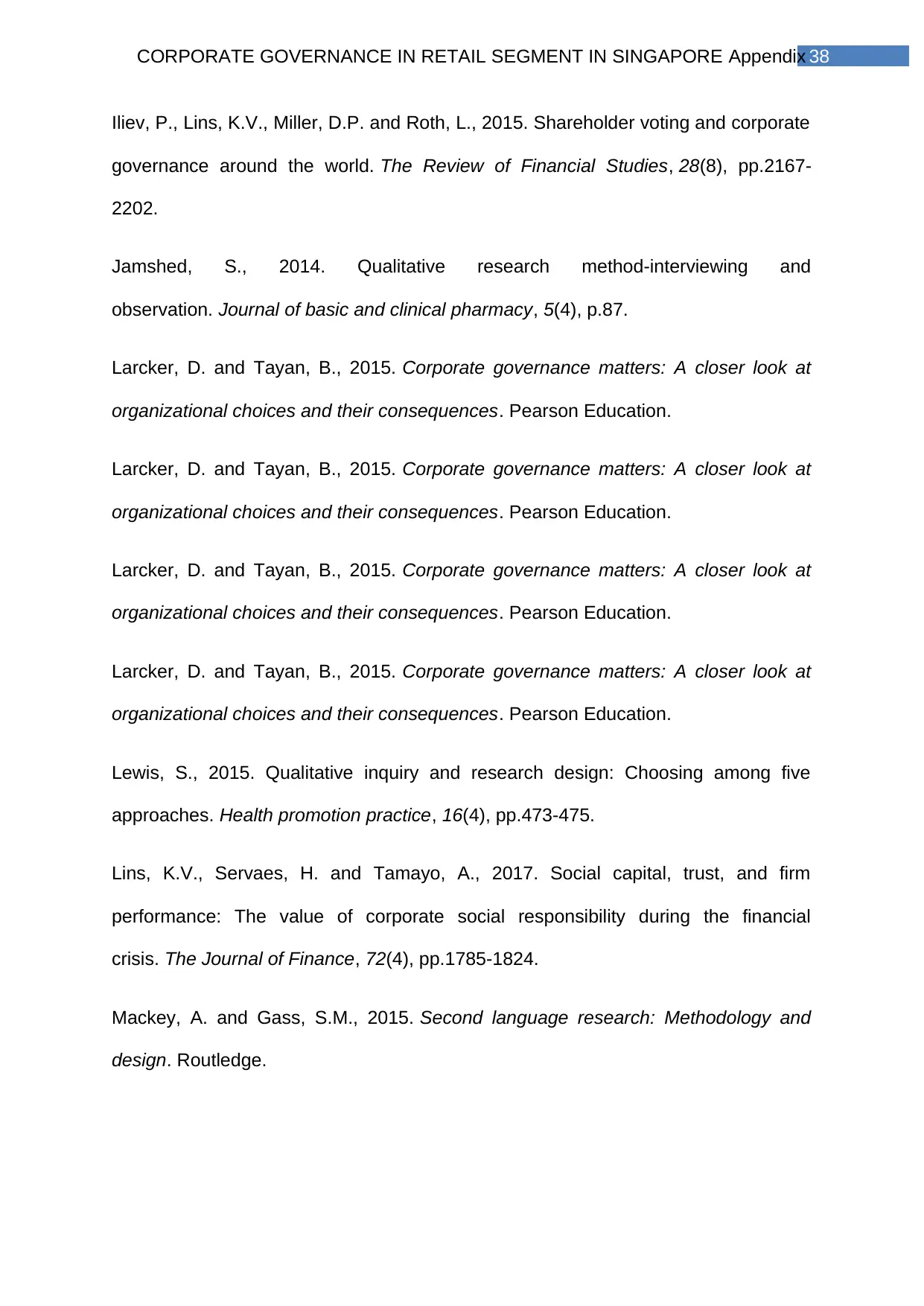
38CORPORATE GOVERNANCE IN RETAIL SEGMENT IN SINGAPORE Appendix
Iliev, P., Lins, K.V., Miller, D.P. and Roth, L., 2015. Shareholder voting and corporate
governance around the world. The Review of Financial Studies, 28(8), pp.2167-
2202.
Jamshed, S., 2014. Qualitative research method-interviewing and
observation. Journal of basic and clinical pharmacy, 5(4), p.87.
Larcker, D. and Tayan, B., 2015. Corporate governance matters: A closer look at
organizational choices and their consequences. Pearson Education.
Larcker, D. and Tayan, B., 2015. Corporate governance matters: A closer look at
organizational choices and their consequences. Pearson Education.
Larcker, D. and Tayan, B., 2015. Corporate governance matters: A closer look at
organizational choices and their consequences. Pearson Education.
Larcker, D. and Tayan, B., 2015. Corporate governance matters: A closer look at
organizational choices and their consequences. Pearson Education.
Lewis, S., 2015. Qualitative inquiry and research design: Choosing among five
approaches. Health promotion practice, 16(4), pp.473-475.
Lins, K.V., Servaes, H. and Tamayo, A., 2017. Social capital, trust, and firm
performance: The value of corporate social responsibility during the financial
crisis. The Journal of Finance, 72(4), pp.1785-1824.
Mackey, A. and Gass, S.M., 2015. Second language research: Methodology and
design. Routledge.
Iliev, P., Lins, K.V., Miller, D.P. and Roth, L., 2015. Shareholder voting and corporate
governance around the world. The Review of Financial Studies, 28(8), pp.2167-
2202.
Jamshed, S., 2014. Qualitative research method-interviewing and
observation. Journal of basic and clinical pharmacy, 5(4), p.87.
Larcker, D. and Tayan, B., 2015. Corporate governance matters: A closer look at
organizational choices and their consequences. Pearson Education.
Larcker, D. and Tayan, B., 2015. Corporate governance matters: A closer look at
organizational choices and their consequences. Pearson Education.
Larcker, D. and Tayan, B., 2015. Corporate governance matters: A closer look at
organizational choices and their consequences. Pearson Education.
Larcker, D. and Tayan, B., 2015. Corporate governance matters: A closer look at
organizational choices and their consequences. Pearson Education.
Lewis, S., 2015. Qualitative inquiry and research design: Choosing among five
approaches. Health promotion practice, 16(4), pp.473-475.
Lins, K.V., Servaes, H. and Tamayo, A., 2017. Social capital, trust, and firm
performance: The value of corporate social responsibility during the financial
crisis. The Journal of Finance, 72(4), pp.1785-1824.
Mackey, A. and Gass, S.M., 2015. Second language research: Methodology and
design. Routledge.
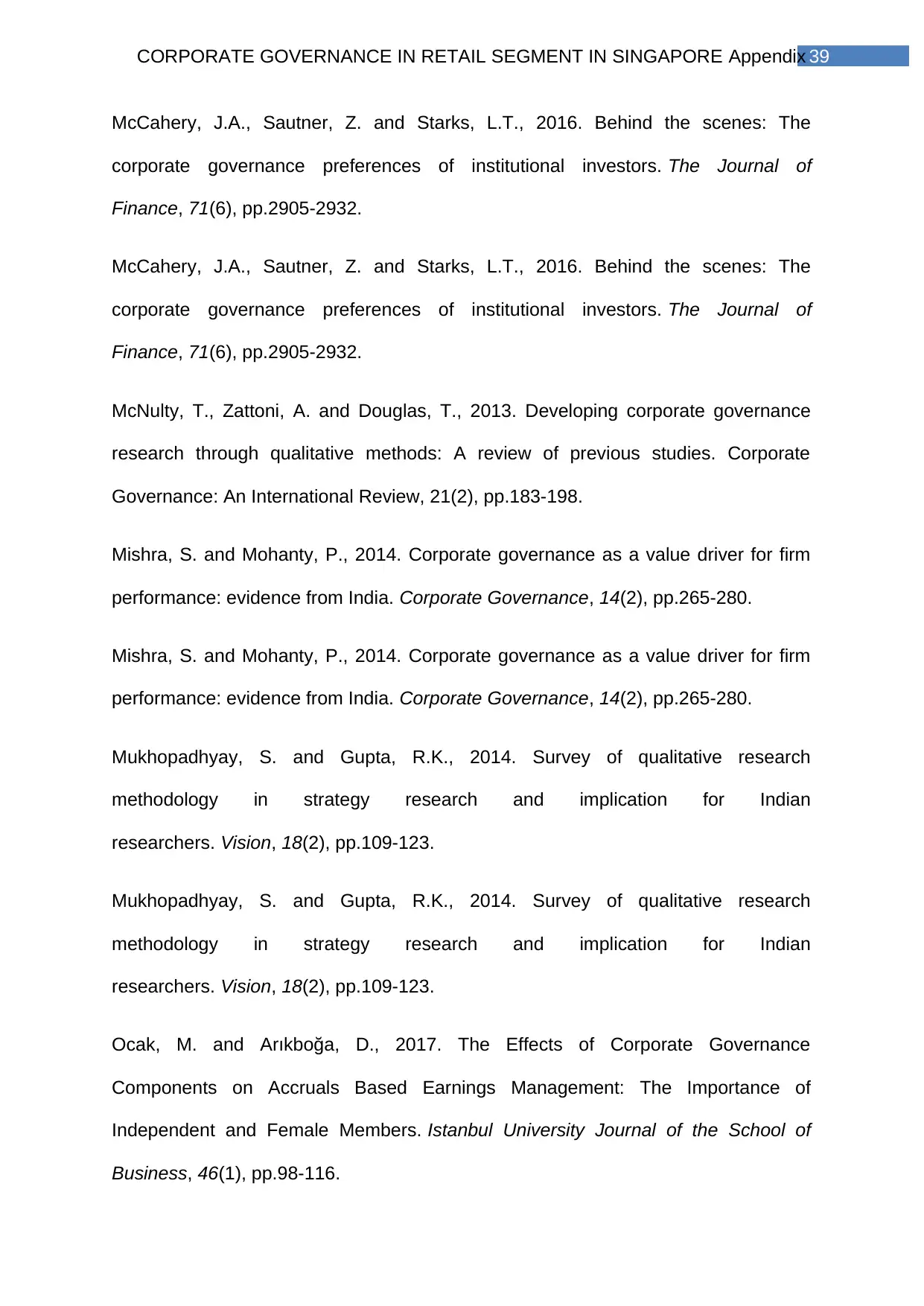
39CORPORATE GOVERNANCE IN RETAIL SEGMENT IN SINGAPORE Appendix
McCahery, J.A., Sautner, Z. and Starks, L.T., 2016. Behind the scenes: The
corporate governance preferences of institutional investors. The Journal of
Finance, 71(6), pp.2905-2932.
McCahery, J.A., Sautner, Z. and Starks, L.T., 2016. Behind the scenes: The
corporate governance preferences of institutional investors. The Journal of
Finance, 71(6), pp.2905-2932.
McNulty, T., Zattoni, A. and Douglas, T., 2013. Developing corporate governance
research through qualitative methods: A review of previous studies. Corporate
Governance: An International Review, 21(2), pp.183-198.
Mishra, S. and Mohanty, P., 2014. Corporate governance as a value driver for firm
performance: evidence from India. Corporate Governance, 14(2), pp.265-280.
Mishra, S. and Mohanty, P., 2014. Corporate governance as a value driver for firm
performance: evidence from India. Corporate Governance, 14(2), pp.265-280.
Mukhopadhyay, S. and Gupta, R.K., 2014. Survey of qualitative research
methodology in strategy research and implication for Indian
researchers. Vision, 18(2), pp.109-123.
Mukhopadhyay, S. and Gupta, R.K., 2014. Survey of qualitative research
methodology in strategy research and implication for Indian
researchers. Vision, 18(2), pp.109-123.
Ocak, M. and Arıkboğa, D., 2017. The Effects of Corporate Governance
Components on Accruals Based Earnings Management: The Importance of
Independent and Female Members. Istanbul University Journal of the School of
Business, 46(1), pp.98-116.
McCahery, J.A., Sautner, Z. and Starks, L.T., 2016. Behind the scenes: The
corporate governance preferences of institutional investors. The Journal of
Finance, 71(6), pp.2905-2932.
McCahery, J.A., Sautner, Z. and Starks, L.T., 2016. Behind the scenes: The
corporate governance preferences of institutional investors. The Journal of
Finance, 71(6), pp.2905-2932.
McNulty, T., Zattoni, A. and Douglas, T., 2013. Developing corporate governance
research through qualitative methods: A review of previous studies. Corporate
Governance: An International Review, 21(2), pp.183-198.
Mishra, S. and Mohanty, P., 2014. Corporate governance as a value driver for firm
performance: evidence from India. Corporate Governance, 14(2), pp.265-280.
Mishra, S. and Mohanty, P., 2014. Corporate governance as a value driver for firm
performance: evidence from India. Corporate Governance, 14(2), pp.265-280.
Mukhopadhyay, S. and Gupta, R.K., 2014. Survey of qualitative research
methodology in strategy research and implication for Indian
researchers. Vision, 18(2), pp.109-123.
Mukhopadhyay, S. and Gupta, R.K., 2014. Survey of qualitative research
methodology in strategy research and implication for Indian
researchers. Vision, 18(2), pp.109-123.
Ocak, M. and Arıkboğa, D., 2017. The Effects of Corporate Governance
Components on Accruals Based Earnings Management: The Importance of
Independent and Female Members. Istanbul University Journal of the School of
Business, 46(1), pp.98-116.
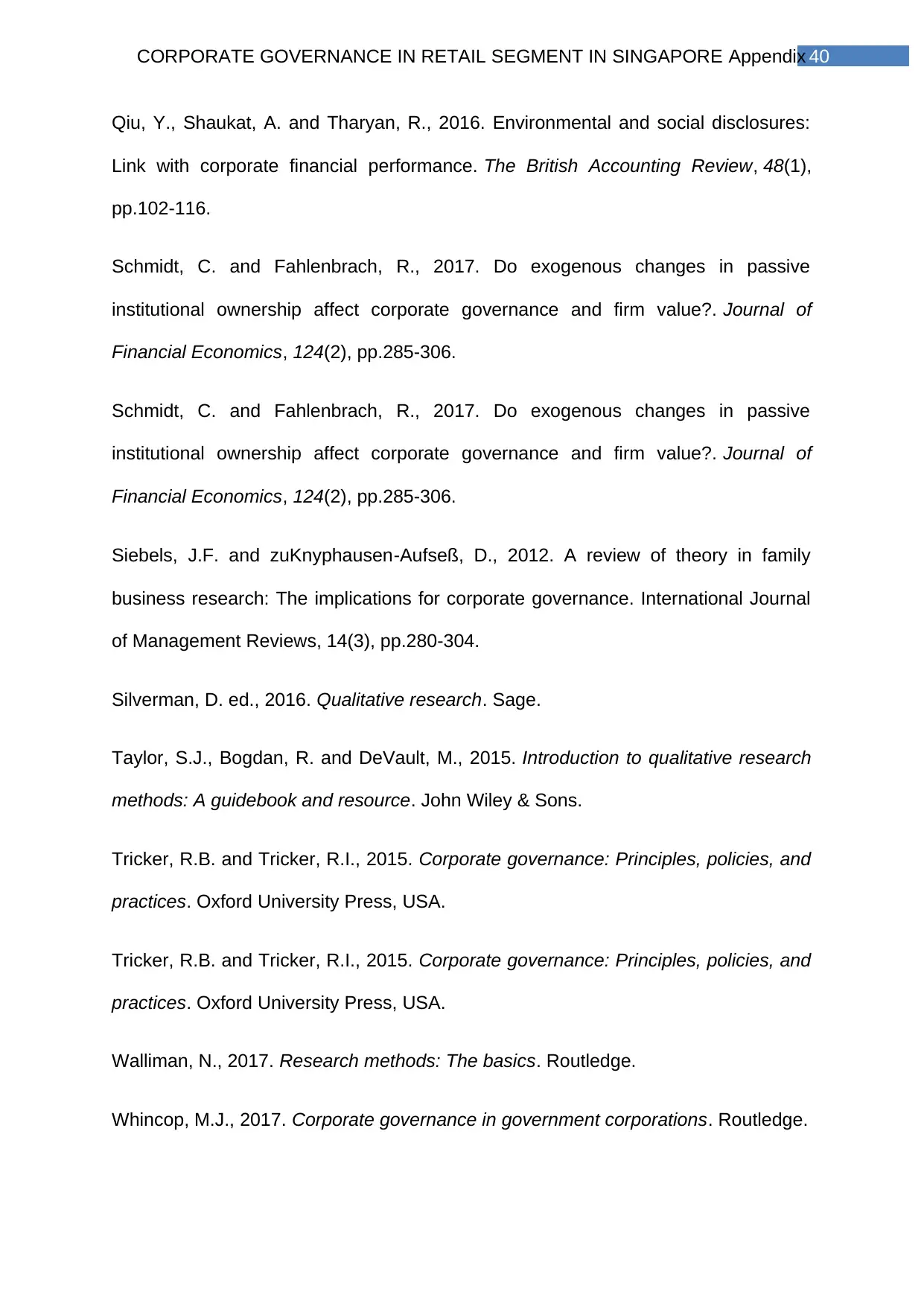
40CORPORATE GOVERNANCE IN RETAIL SEGMENT IN SINGAPORE Appendix
Qiu, Y., Shaukat, A. and Tharyan, R., 2016. Environmental and social disclosures:
Link with corporate financial performance. The British Accounting Review, 48(1),
pp.102-116.
Schmidt, C. and Fahlenbrach, R., 2017. Do exogenous changes in passive
institutional ownership affect corporate governance and firm value?. Journal of
Financial Economics, 124(2), pp.285-306.
Schmidt, C. and Fahlenbrach, R., 2017. Do exogenous changes in passive
institutional ownership affect corporate governance and firm value?. Journal of
Financial Economics, 124(2), pp.285-306.
Siebels, J.F. and zuKnyphausen‐Aufseß, D., 2012. A review of theory in family
business research: The implications for corporate governance. International Journal
of Management Reviews, 14(3), pp.280-304.
Silverman, D. ed., 2016. Qualitative research. Sage.
Taylor, S.J., Bogdan, R. and DeVault, M., 2015. Introduction to qualitative research
methods: A guidebook and resource. John Wiley & Sons.
Tricker, R.B. and Tricker, R.I., 2015. Corporate governance: Principles, policies, and
practices. Oxford University Press, USA.
Tricker, R.B. and Tricker, R.I., 2015. Corporate governance: Principles, policies, and
practices. Oxford University Press, USA.
Walliman, N., 2017. Research methods: The basics. Routledge.
Whincop, M.J., 2017. Corporate governance in government corporations. Routledge.
Qiu, Y., Shaukat, A. and Tharyan, R., 2016. Environmental and social disclosures:
Link with corporate financial performance. The British Accounting Review, 48(1),
pp.102-116.
Schmidt, C. and Fahlenbrach, R., 2017. Do exogenous changes in passive
institutional ownership affect corporate governance and firm value?. Journal of
Financial Economics, 124(2), pp.285-306.
Schmidt, C. and Fahlenbrach, R., 2017. Do exogenous changes in passive
institutional ownership affect corporate governance and firm value?. Journal of
Financial Economics, 124(2), pp.285-306.
Siebels, J.F. and zuKnyphausen‐Aufseß, D., 2012. A review of theory in family
business research: The implications for corporate governance. International Journal
of Management Reviews, 14(3), pp.280-304.
Silverman, D. ed., 2016. Qualitative research. Sage.
Taylor, S.J., Bogdan, R. and DeVault, M., 2015. Introduction to qualitative research
methods: A guidebook and resource. John Wiley & Sons.
Tricker, R.B. and Tricker, R.I., 2015. Corporate governance: Principles, policies, and
practices. Oxford University Press, USA.
Tricker, R.B. and Tricker, R.I., 2015. Corporate governance: Principles, policies, and
practices. Oxford University Press, USA.
Walliman, N., 2017. Research methods: The basics. Routledge.
Whincop, M.J., 2017. Corporate governance in government corporations. Routledge.
Secure Best Marks with AI Grader
Need help grading? Try our AI Grader for instant feedback on your assignments.
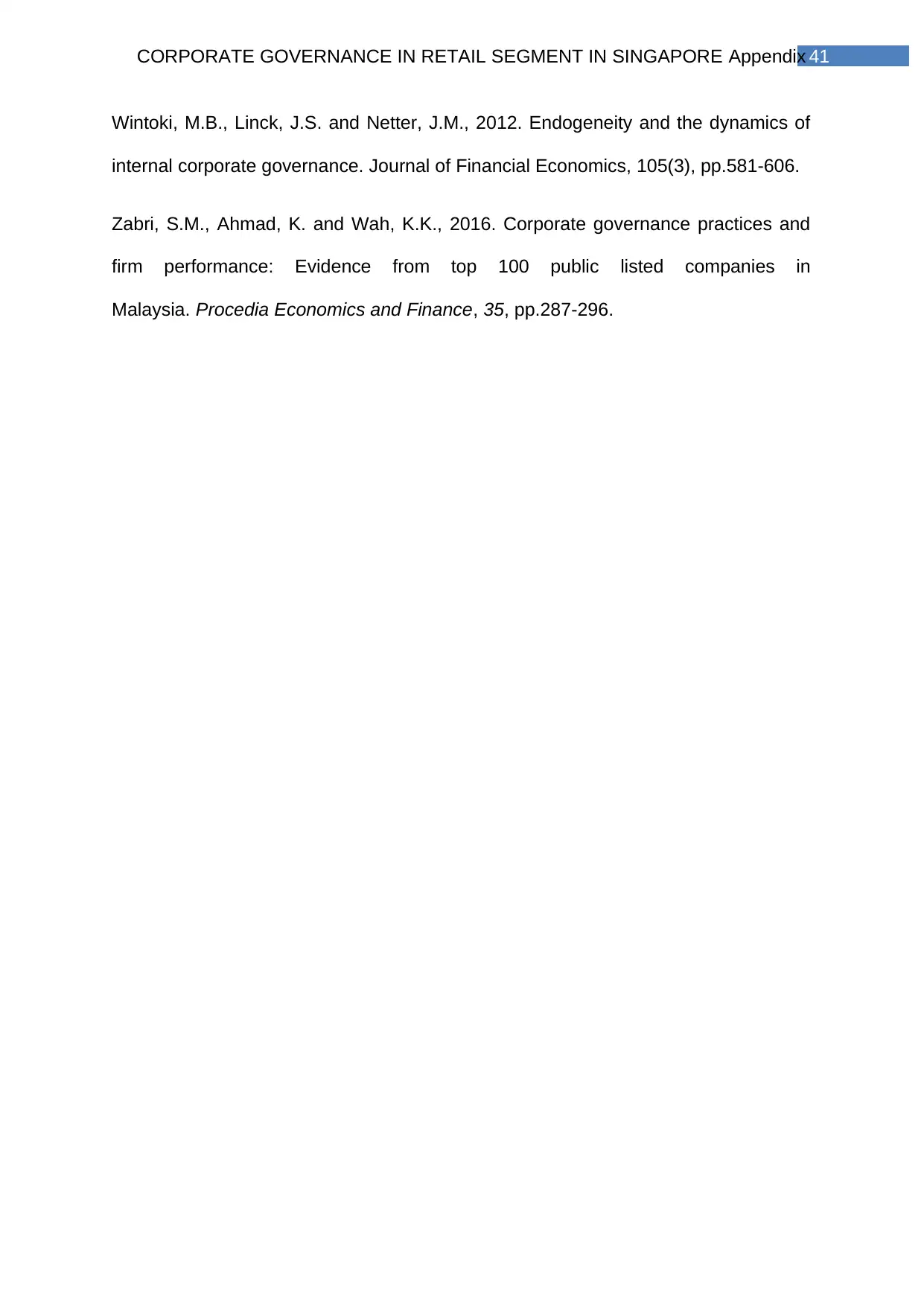
41CORPORATE GOVERNANCE IN RETAIL SEGMENT IN SINGAPORE Appendix
Wintoki, M.B., Linck, J.S. and Netter, J.M., 2012. Endogeneity and the dynamics of
internal corporate governance. Journal of Financial Economics, 105(3), pp.581-606.
Zabri, S.M., Ahmad, K. and Wah, K.K., 2016. Corporate governance practices and
firm performance: Evidence from top 100 public listed companies in
Malaysia. Procedia Economics and Finance, 35, pp.287-296.
Wintoki, M.B., Linck, J.S. and Netter, J.M., 2012. Endogeneity and the dynamics of
internal corporate governance. Journal of Financial Economics, 105(3), pp.581-606.
Zabri, S.M., Ahmad, K. and Wah, K.K., 2016. Corporate governance practices and
firm performance: Evidence from top 100 public listed companies in
Malaysia. Procedia Economics and Finance, 35, pp.287-296.
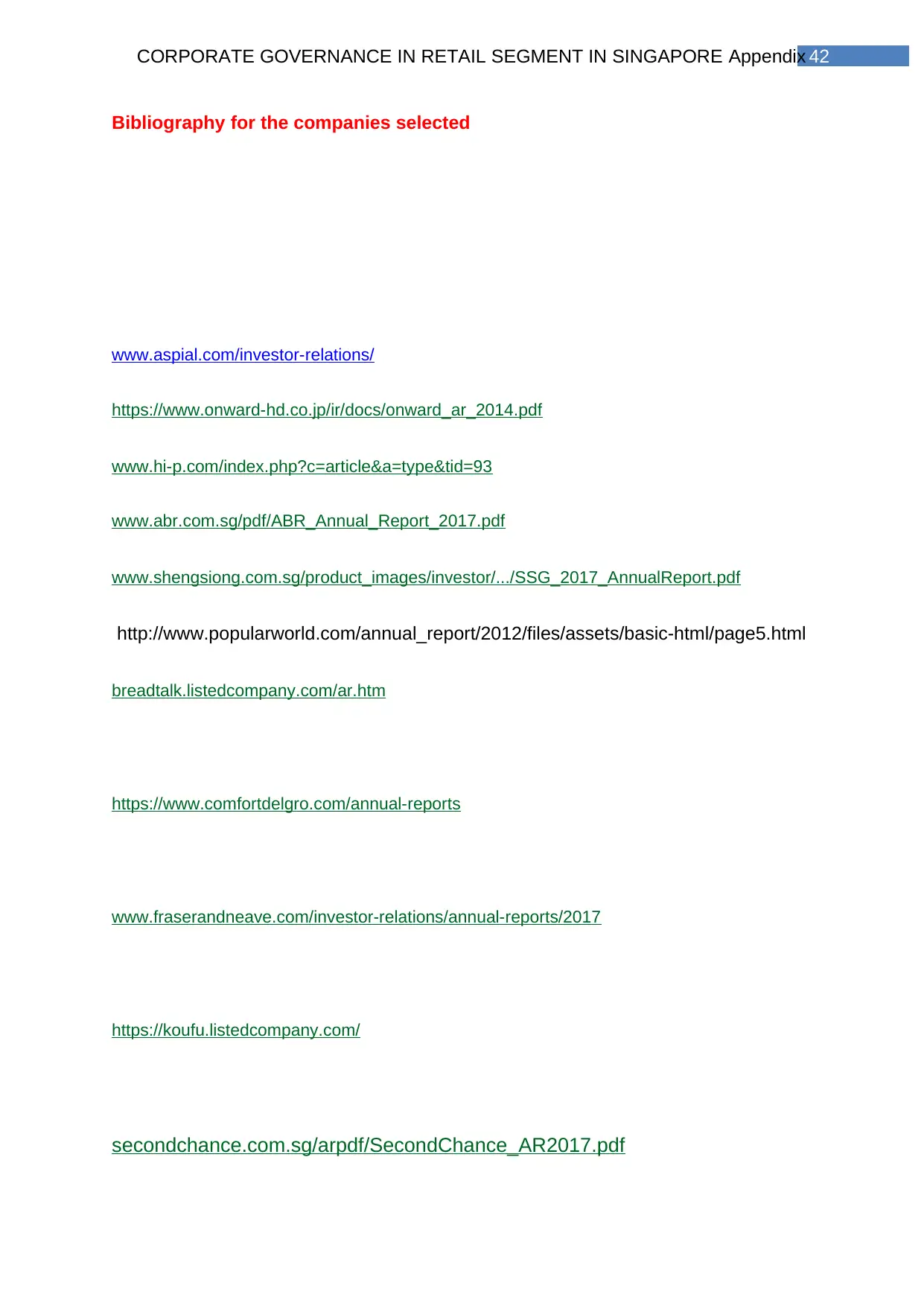
42CORPORATE GOVERNANCE IN RETAIL SEGMENT IN SINGAPORE Appendix
Bibliography for the companies selected
www.aspial.com/investor-relations/
https://www.onward-hd.co.jp/ir/docs/onward_ar_2014.pdf
www.hi-p.com/index.php?c=article&a=type&tid=93
www.abr.com.sg/pdf/ABR_Annual_Report_2017.pdf
www.shengsiong.com.sg/product_images/investor/.../SSG_2017_AnnualReport.pdf
http://www.popularworld.com/annual_report/2012/files/assets/basic-html/page5.html
breadtalk.listedcompany.com/ar.htm
https://www.comfortdelgro.com/annual-reports
www.fraserandneave.com/investor-relations/annual-reports/2017
https://koufu.listedcompany.com/
secondchance.com.sg/arpdf/SecondChance_AR2017.pdf
Bibliography for the companies selected
www.aspial.com/investor-relations/
https://www.onward-hd.co.jp/ir/docs/onward_ar_2014.pdf
www.hi-p.com/index.php?c=article&a=type&tid=93
www.abr.com.sg/pdf/ABR_Annual_Report_2017.pdf
www.shengsiong.com.sg/product_images/investor/.../SSG_2017_AnnualReport.pdf
http://www.popularworld.com/annual_report/2012/files/assets/basic-html/page5.html
breadtalk.listedcompany.com/ar.htm
https://www.comfortdelgro.com/annual-reports
www.fraserandneave.com/investor-relations/annual-reports/2017
https://koufu.listedcompany.com/
secondchance.com.sg/arpdf/SecondChance_AR2017.pdf
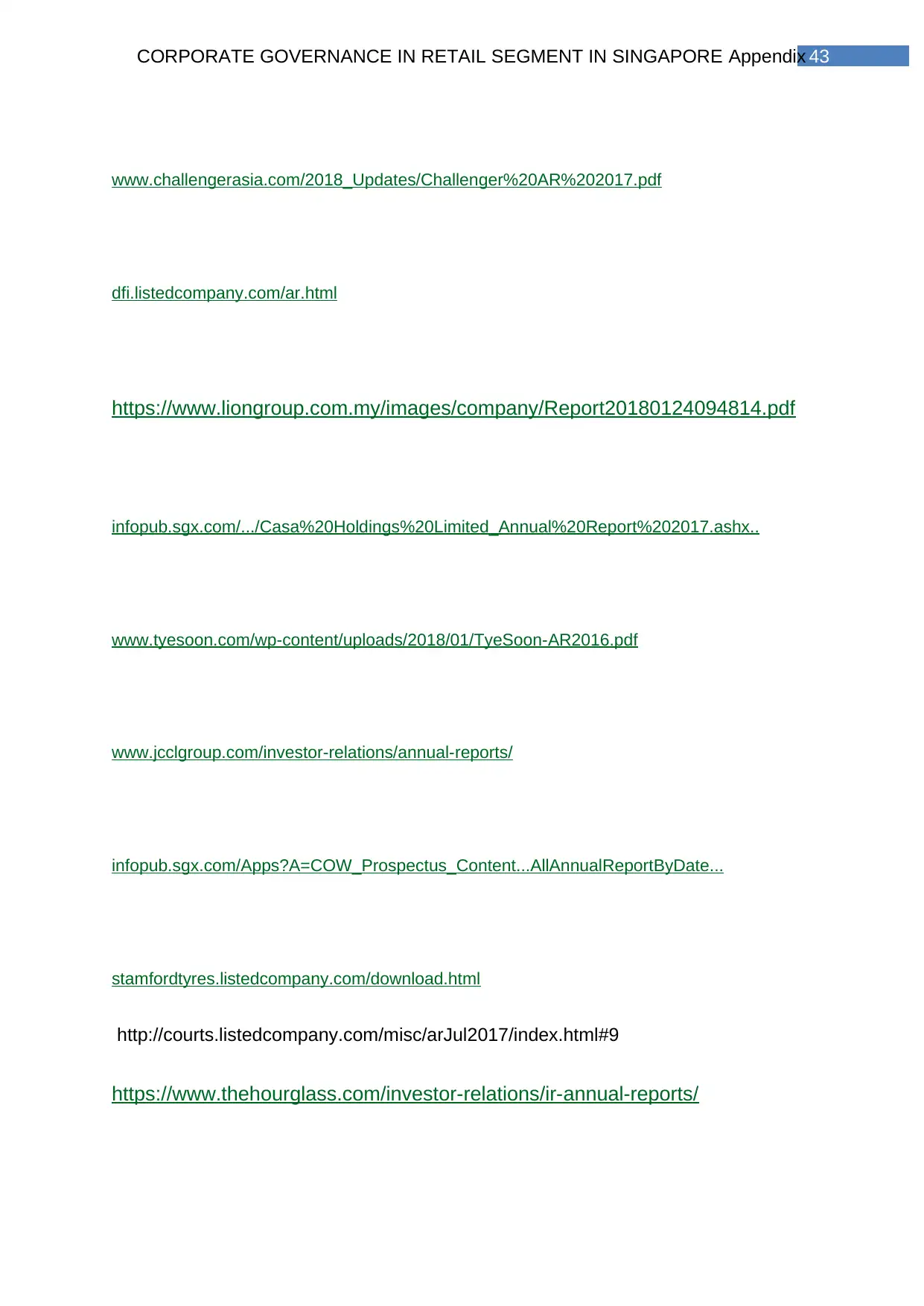
43CORPORATE GOVERNANCE IN RETAIL SEGMENT IN SINGAPORE Appendix
www.challengerasia.com/2018_Updates/Challenger%20AR%202017.pdf
dfi.listedcompany.com/ar.html
https://www.liongroup.com.my/images/company/Report20180124094814.pdf
infopub.sgx.com/.../Casa%20Holdings%20Limited_Annual%20Report%202017.ashx..
www.tyesoon.com/wp-content/uploads/2018/01/TyeSoon-AR2016.pdf
www.jcclgroup.com/investor-relations/annual-reports/
infopub.sgx.com/Apps?A=COW_Prospectus_Content...AllAnnualReportByDate...
stamfordtyres.listedcompany.com/download.html
http://courts.listedcompany.com/misc/arJul2017/index.html#9
https://www.thehourglass.com/investor-relations/ir-annual-reports/
www.challengerasia.com/2018_Updates/Challenger%20AR%202017.pdf
dfi.listedcompany.com/ar.html
https://www.liongroup.com.my/images/company/Report20180124094814.pdf
infopub.sgx.com/.../Casa%20Holdings%20Limited_Annual%20Report%202017.ashx..
www.tyesoon.com/wp-content/uploads/2018/01/TyeSoon-AR2016.pdf
www.jcclgroup.com/investor-relations/annual-reports/
infopub.sgx.com/Apps?A=COW_Prospectus_Content...AllAnnualReportByDate...
stamfordtyres.listedcompany.com/download.html
http://courts.listedcompany.com/misc/arJul2017/index.html#9
https://www.thehourglass.com/investor-relations/ir-annual-reports/
Paraphrase This Document
Need a fresh take? Get an instant paraphrase of this document with our AI Paraphraser
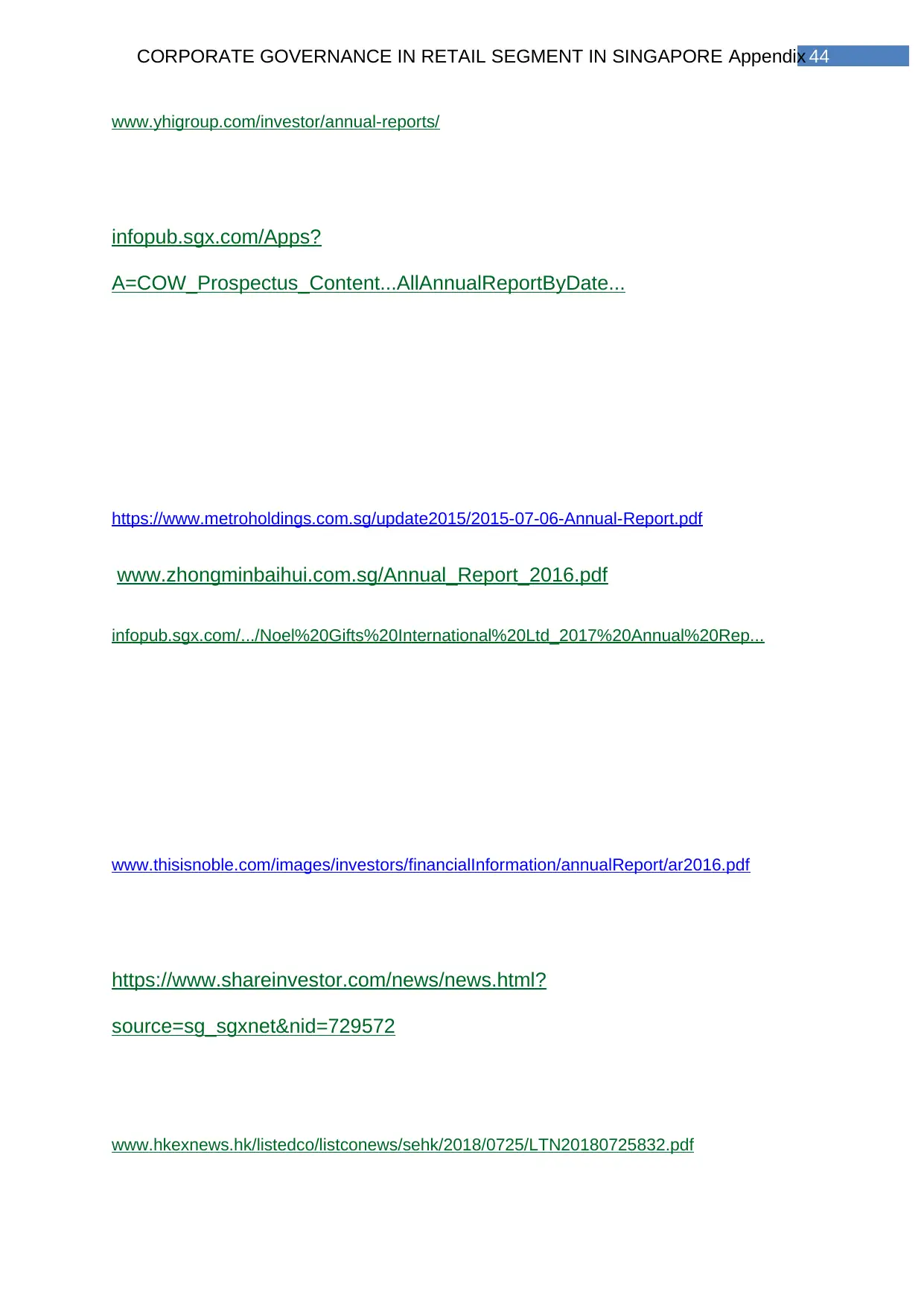
44CORPORATE GOVERNANCE IN RETAIL SEGMENT IN SINGAPORE Appendix
www.yhigroup.com/investor/annual-reports/
infopub.sgx.com/Apps?
A=COW_Prospectus_Content...AllAnnualReportByDate...
https://www.metroholdings.com.sg/update2015/2015-07-06-Annual-Report.pdf
www.zhongminbaihui.com.sg/Annual_Report_2016.pdf
infopub.sgx.com/.../Noel%20Gifts%20International%20Ltd_2017%20Annual%20Rep...
www.thisisnoble.com/images/investors/financialInformation/annualReport/ar2016.pdf
https://www.shareinvestor.com/news/news.html?
source=sg_sgxnet&nid=729572
www.hkexnews.hk/listedco/listconews/sehk/2018/0725/LTN20180725832.pdf
www.yhigroup.com/investor/annual-reports/
infopub.sgx.com/Apps?
A=COW_Prospectus_Content...AllAnnualReportByDate...
https://www.metroholdings.com.sg/update2015/2015-07-06-Annual-Report.pdf
www.zhongminbaihui.com.sg/Annual_Report_2016.pdf
infopub.sgx.com/.../Noel%20Gifts%20International%20Ltd_2017%20Annual%20Rep...
www.thisisnoble.com/images/investors/financialInformation/annualReport/ar2016.pdf
https://www.shareinvestor.com/news/news.html?
source=sg_sgxnet&nid=729572
www.hkexnews.hk/listedco/listconews/sehk/2018/0725/LTN20180725832.pdf

45CORPORATE GOVERNANCE IN RETAIL SEGMENT IN SINGAPORE Appendix
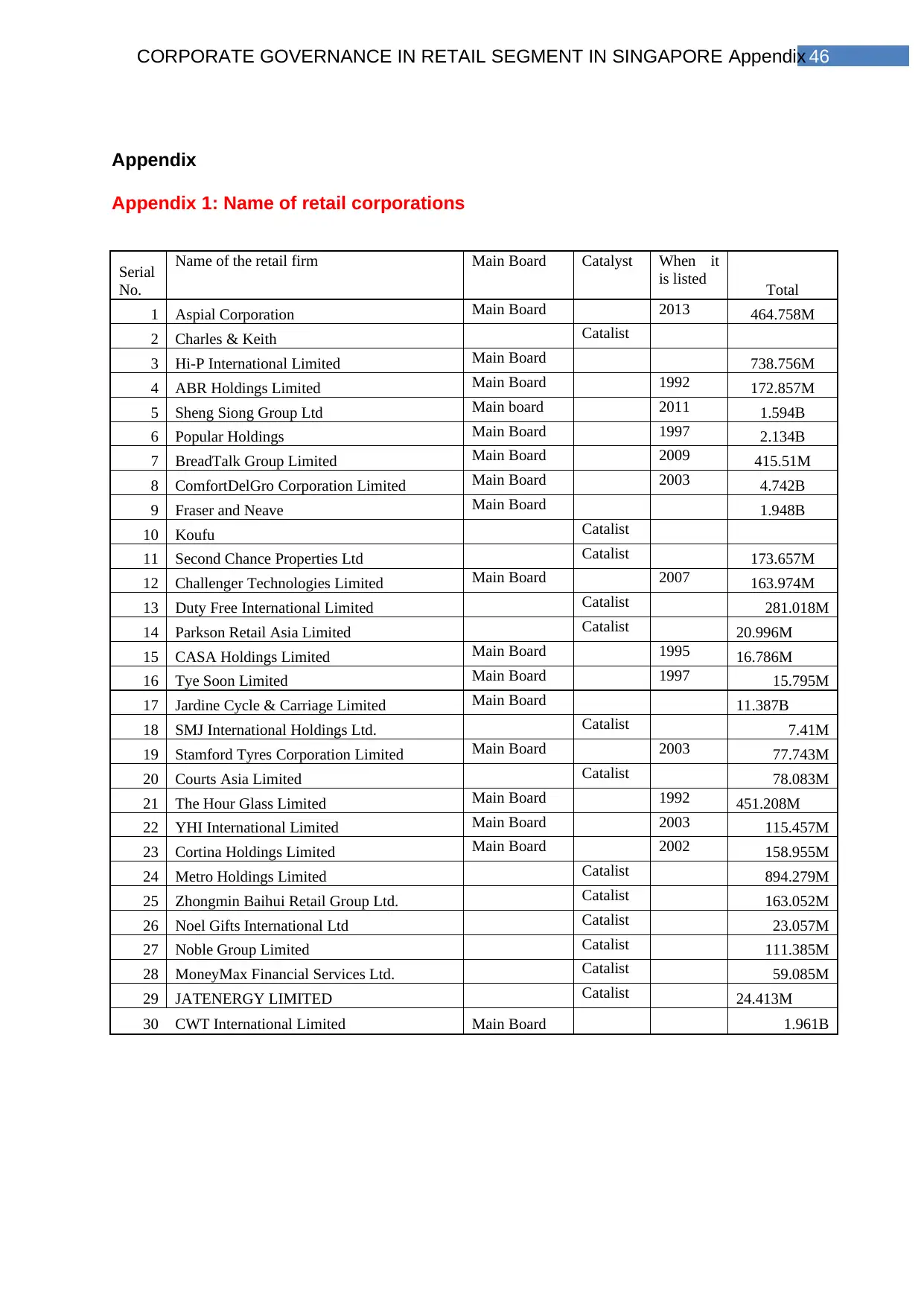
46CORPORATE GOVERNANCE IN RETAIL SEGMENT IN SINGAPORE Appendix
Appendix
Appendix 1: Name of retail corporations
Serial
No.
Name of the retail firm Main Board Catalyst When it
is listed Total
1 Aspial Corporation Main Board 2013 464.758M
2 Charles & Keith Catalist
3 Hi-P International Limited Main Board 738.756M
4 ABR Holdings Limited Main Board 1992 172.857M
5 Sheng Siong Group Ltd Main board 2011 1.594B
6 Popular Holdings Main Board 1997 2.134B
7 BreadTalk Group Limited Main Board 2009 415.51M
8 ComfortDelGro Corporation Limited Main Board 2003 4.742B
9 Fraser and Neave Main Board 1.948B
10 Koufu Catalist
11 Second Chance Properties Ltd Catalist 173.657M
12 Challenger Technologies Limited Main Board 2007 163.974M
13 Duty Free International Limited Catalist 281.018M
14 Parkson Retail Asia Limited Catalist 20.996M
15 CASA Holdings Limited Main Board 1995 16.786M
16 Tye Soon Limited Main Board 1997 15.795M
17 Jardine Cycle & Carriage Limited Main Board 11.387B
18 SMJ International Holdings Ltd. Catalist 7.41M
19 Stamford Tyres Corporation Limited Main Board 2003 77.743M
20 Courts Asia Limited Catalist 78.083M
21 The Hour Glass Limited Main Board 1992 451.208M
22 YHI International Limited Main Board 2003 115.457M
23 Cortina Holdings Limited Main Board 2002 158.955M
24 Metro Holdings Limited Catalist 894.279M
25 Zhongmin Baihui Retail Group Ltd. Catalist 163.052M
26 Noel Gifts International Ltd Catalist 23.057M
27 Noble Group Limited Catalist 111.385M
28 MoneyMax Financial Services Ltd. Catalist 59.085M
29 JATENERGY LIMITED Catalist 24.413M
30 CWT International Limited Main Board 1.961B
Appendix
Appendix 1: Name of retail corporations
Serial
No.
Name of the retail firm Main Board Catalyst When it
is listed Total
1 Aspial Corporation Main Board 2013 464.758M
2 Charles & Keith Catalist
3 Hi-P International Limited Main Board 738.756M
4 ABR Holdings Limited Main Board 1992 172.857M
5 Sheng Siong Group Ltd Main board 2011 1.594B
6 Popular Holdings Main Board 1997 2.134B
7 BreadTalk Group Limited Main Board 2009 415.51M
8 ComfortDelGro Corporation Limited Main Board 2003 4.742B
9 Fraser and Neave Main Board 1.948B
10 Koufu Catalist
11 Second Chance Properties Ltd Catalist 173.657M
12 Challenger Technologies Limited Main Board 2007 163.974M
13 Duty Free International Limited Catalist 281.018M
14 Parkson Retail Asia Limited Catalist 20.996M
15 CASA Holdings Limited Main Board 1995 16.786M
16 Tye Soon Limited Main Board 1997 15.795M
17 Jardine Cycle & Carriage Limited Main Board 11.387B
18 SMJ International Holdings Ltd. Catalist 7.41M
19 Stamford Tyres Corporation Limited Main Board 2003 77.743M
20 Courts Asia Limited Catalist 78.083M
21 The Hour Glass Limited Main Board 1992 451.208M
22 YHI International Limited Main Board 2003 115.457M
23 Cortina Holdings Limited Main Board 2002 158.955M
24 Metro Holdings Limited Catalist 894.279M
25 Zhongmin Baihui Retail Group Ltd. Catalist 163.052M
26 Noel Gifts International Ltd Catalist 23.057M
27 Noble Group Limited Catalist 111.385M
28 MoneyMax Financial Services Ltd. Catalist 59.085M
29 JATENERGY LIMITED Catalist 24.413M
30 CWT International Limited Main Board 1.961B
Secure Best Marks with AI Grader
Need help grading? Try our AI Grader for instant feedback on your assignments.
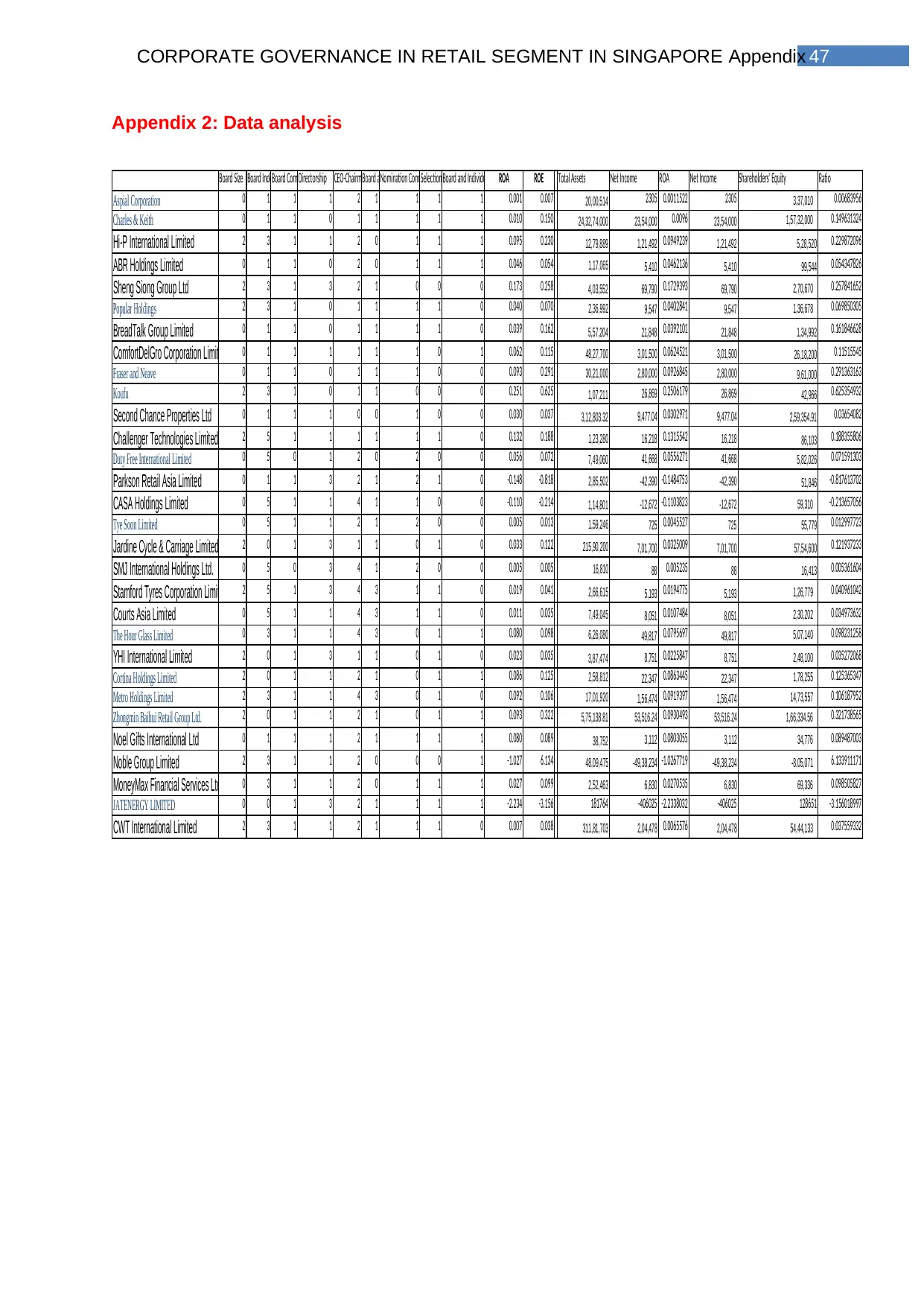
47CORPORATE GOVERNANCE IN RETAIL SEGMENT IN SINGAPORE Appendix
Appendix 2: Data analysis
Board Size Board IndependenceBoard CompetenciesDirectorship CEO-Chairman seperationBoard and committee meetingsNomination Committee IndependenceSelection of directorsBoard and Individual Director AppraisalROA ROE Total Assets Net Income ROA Net Income Shareholders' Equity Ratio
Aspial Corporation 0 1 1 1 2 1 1 1 1 0.001 0.007 20,00,514 2305 0.0011522 2305 3,37,010 0.00683956
Charles & Keith 0 1 1 0 1 1 1 1 1 0.010 0.150 24,32,74,000 23,54,000 0.0096 23,54,000 1,57,32,000 0.149631324
Hi-P International Limited 2 3 1 1 2 0 1 1 1 0.095 0.230 12,79,889 1,21,492 0.0949239 1,21,492 5,28,520 0.229872096
ABR Holdings Limited 0 1 1 0 2 0 1 1 1 0.046 0.054 1,17,065 5,410 0.0462136 5,410 99,544 0.054347826
Sheng Siong Group Ltd 2 3 1 3 2 1 0 0 0 0.173 0.258 4,03,552 69,790 0.1729393 69,790 2,70,670 0.257841652
Popular Holdings 2 3 1 0 1 1 1 1 0 0.040 0.070 2,36,992 9,547 0.0402841 9,547 1,36,678 0.069850305
BreadTalk Group Limited 0 1 1 0 1 1 1 1 0 0.039 0.162 5,57,204 21,848 0.0392101 21,848 1,34,992 0.161846628
ComfortDelGro Corporation Limited 0 1 1 1 1 1 1 0 1 0.062 0.115 48,27,700 3,01,500 0.0624521 3,01,500 26,18,200 0.11515545
Fraser and Neave 0 1 1 0 1 1 1 0 0 0.093 0.291 30,21,000 2,80,000 0.0926845 2,80,000 9,61,000 0.291363163
Koufu 2 3 1 0 1 1 0 0 0 0.251 0.625 1,07,211 26,869 0.2506179 26,869 42,966 0.625354932
Second Chance Properties Ltd 0 1 1 1 0 0 1 0 0 0.030 0.037 3,12,803.32 9,477.04 0.0302971 9,477.04 2,59,354.91 0.03654082
Challenger Technologies Limited 2 5 1 1 1 1 1 1 0 0.132 0.188 1,23,280 16,218 0.1315542 16,218 86,103 0.188355806
Duty Free International Limited 0 5 0 1 2 0 2 0 0 0.056 0.072 7,49,060 41,668 0.0556271 41,668 5,82,026 0.071591303
Parkson Retail Asia Limited 0 1 1 3 2 1 2 1 0 -0.148 -0.818 2,85,502 -42,390 -0.1484753 -42,390 51,846 -0.817613702
CASA Holdings Limited 0 5 1 1 4 1 1 0 0 -0.110 -0.214 1,14,801 -12,672 -0.1103823 -12,672 59,310 -0.213657056
Tye Soon Limited 0 5 1 1 2 1 2 0 0 0.005 0.013 1,59,246 725 0.0045527 725 55,779 0.012997723
Jardine Cycle & Carriage Limited 2 0 1 3 1 1 0 1 0 0.033 0.122 215,90,200 7,01,700 0.0325009 7,01,700 57,54,600 0.121937233
SMJ International Holdings Ltd. 0 5 0 3 4 1 2 0 0 0.005 0.005 16,810 88 0.005235 88 16,413 0.005361604
Stamford Tyres Corporation Limited 2 5 1 3 4 3 1 1 0 0.019 0.041 2,66,615 5,193 0.0194775 5,193 1,26,779 0.040961042
Courts Asia Limited 0 5 1 1 4 3 1 1 0 0.011 0.035 7,49,045 8,051 0.0107484 8,051 2,30,202 0.034973632
The Hour Glass Limited 0 3 1 1 4 3 0 1 1 0.080 0.098 6,26,080 49,817 0.0795697 49,817 5,07,140 0.098231258
YHI International Limited 2 0 1 3 1 1 0 1 0 0.023 0.035 3,87,474 8,751 0.0225847 8,751 2,48,100 0.035272068
Cortina Holdings Limited 2 0 1 1 2 1 0 1 1 0.086 0.125 2,58,812 22,347 0.0863445 22,347 1,78,255 0.125365347
Metro Holdings Limited 2 3 1 1 4 3 0 1 0 0.092 0.106 17,01,920 1,56,474 0.0919397 1,56,474 14,73,557 0.106187952
Zhongmin Baihui Retail Group Ltd. 2 0 1 1 2 1 0 1 1 0.093 0.322 5,75,138.81 53,516.24 0.0930493 53,516.24 1,66,334.56 0.321738565
Noel Gifts International Ltd 0 1 1 1 2 1 1 1 1 0.080 0.089 38,752 3,112 0.0803055 3,112 34,776 0.089487003
Noble Group Limited 2 3 1 1 2 0 0 0 1 -1.027 6.134 48,09,475 -49,38,234 -1.0267719 -49,38,234 -8,05,071 6.133911171
MoneyMax Financial Services Ltd. 0 3 1 1 2 0 1 1 1 0.027 0.099 2,52,463 6,830 0.0270535 6,830 69,336 0.098505827
JATENERGY LIMITED 0 0 1 3 2 1 1 1 1 -2.234 -3.156 181764 -406025 -2.2338032 -406025 128651 -3.156018997
CWT International Limited 2 3 1 1 2 1 1 1 0 0.007 0.038 311,81,703 2,04,478 0.0065576 2,04,478 54,44,133 0.037559332
Appendix 2: Data analysis
Board Size Board IndependenceBoard CompetenciesDirectorship CEO-Chairman seperationBoard and committee meetingsNomination Committee IndependenceSelection of directorsBoard and Individual Director AppraisalROA ROE Total Assets Net Income ROA Net Income Shareholders' Equity Ratio
Aspial Corporation 0 1 1 1 2 1 1 1 1 0.001 0.007 20,00,514 2305 0.0011522 2305 3,37,010 0.00683956
Charles & Keith 0 1 1 0 1 1 1 1 1 0.010 0.150 24,32,74,000 23,54,000 0.0096 23,54,000 1,57,32,000 0.149631324
Hi-P International Limited 2 3 1 1 2 0 1 1 1 0.095 0.230 12,79,889 1,21,492 0.0949239 1,21,492 5,28,520 0.229872096
ABR Holdings Limited 0 1 1 0 2 0 1 1 1 0.046 0.054 1,17,065 5,410 0.0462136 5,410 99,544 0.054347826
Sheng Siong Group Ltd 2 3 1 3 2 1 0 0 0 0.173 0.258 4,03,552 69,790 0.1729393 69,790 2,70,670 0.257841652
Popular Holdings 2 3 1 0 1 1 1 1 0 0.040 0.070 2,36,992 9,547 0.0402841 9,547 1,36,678 0.069850305
BreadTalk Group Limited 0 1 1 0 1 1 1 1 0 0.039 0.162 5,57,204 21,848 0.0392101 21,848 1,34,992 0.161846628
ComfortDelGro Corporation Limited 0 1 1 1 1 1 1 0 1 0.062 0.115 48,27,700 3,01,500 0.0624521 3,01,500 26,18,200 0.11515545
Fraser and Neave 0 1 1 0 1 1 1 0 0 0.093 0.291 30,21,000 2,80,000 0.0926845 2,80,000 9,61,000 0.291363163
Koufu 2 3 1 0 1 1 0 0 0 0.251 0.625 1,07,211 26,869 0.2506179 26,869 42,966 0.625354932
Second Chance Properties Ltd 0 1 1 1 0 0 1 0 0 0.030 0.037 3,12,803.32 9,477.04 0.0302971 9,477.04 2,59,354.91 0.03654082
Challenger Technologies Limited 2 5 1 1 1 1 1 1 0 0.132 0.188 1,23,280 16,218 0.1315542 16,218 86,103 0.188355806
Duty Free International Limited 0 5 0 1 2 0 2 0 0 0.056 0.072 7,49,060 41,668 0.0556271 41,668 5,82,026 0.071591303
Parkson Retail Asia Limited 0 1 1 3 2 1 2 1 0 -0.148 -0.818 2,85,502 -42,390 -0.1484753 -42,390 51,846 -0.817613702
CASA Holdings Limited 0 5 1 1 4 1 1 0 0 -0.110 -0.214 1,14,801 -12,672 -0.1103823 -12,672 59,310 -0.213657056
Tye Soon Limited 0 5 1 1 2 1 2 0 0 0.005 0.013 1,59,246 725 0.0045527 725 55,779 0.012997723
Jardine Cycle & Carriage Limited 2 0 1 3 1 1 0 1 0 0.033 0.122 215,90,200 7,01,700 0.0325009 7,01,700 57,54,600 0.121937233
SMJ International Holdings Ltd. 0 5 0 3 4 1 2 0 0 0.005 0.005 16,810 88 0.005235 88 16,413 0.005361604
Stamford Tyres Corporation Limited 2 5 1 3 4 3 1 1 0 0.019 0.041 2,66,615 5,193 0.0194775 5,193 1,26,779 0.040961042
Courts Asia Limited 0 5 1 1 4 3 1 1 0 0.011 0.035 7,49,045 8,051 0.0107484 8,051 2,30,202 0.034973632
The Hour Glass Limited 0 3 1 1 4 3 0 1 1 0.080 0.098 6,26,080 49,817 0.0795697 49,817 5,07,140 0.098231258
YHI International Limited 2 0 1 3 1 1 0 1 0 0.023 0.035 3,87,474 8,751 0.0225847 8,751 2,48,100 0.035272068
Cortina Holdings Limited 2 0 1 1 2 1 0 1 1 0.086 0.125 2,58,812 22,347 0.0863445 22,347 1,78,255 0.125365347
Metro Holdings Limited 2 3 1 1 4 3 0 1 0 0.092 0.106 17,01,920 1,56,474 0.0919397 1,56,474 14,73,557 0.106187952
Zhongmin Baihui Retail Group Ltd. 2 0 1 1 2 1 0 1 1 0.093 0.322 5,75,138.81 53,516.24 0.0930493 53,516.24 1,66,334.56 0.321738565
Noel Gifts International Ltd 0 1 1 1 2 1 1 1 1 0.080 0.089 38,752 3,112 0.0803055 3,112 34,776 0.089487003
Noble Group Limited 2 3 1 1 2 0 0 0 1 -1.027 6.134 48,09,475 -49,38,234 -1.0267719 -49,38,234 -8,05,071 6.133911171
MoneyMax Financial Services Ltd. 0 3 1 1 2 0 1 1 1 0.027 0.099 2,52,463 6,830 0.0270535 6,830 69,336 0.098505827
JATENERGY LIMITED 0 0 1 3 2 1 1 1 1 -2.234 -3.156 181764 -406025 -2.2338032 -406025 128651 -3.156018997
CWT International Limited 2 3 1 1 2 1 1 1 0 0.007 0.038 311,81,703 2,04,478 0.0065576 2,04,478 54,44,133 0.037559332
1 out of 47
Your All-in-One AI-Powered Toolkit for Academic Success.
+13062052269
info@desklib.com
Available 24*7 on WhatsApp / Email
![[object Object]](/_next/static/media/star-bottom.7253800d.svg)
Unlock your academic potential
© 2024 | Zucol Services PVT LTD | All rights reserved.





